Road King 1/7/04
By Robin Technologies |

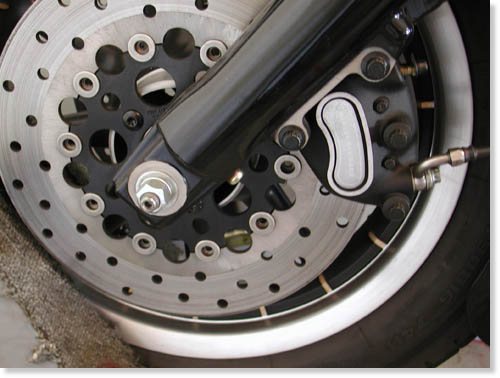
I had a bad feeling about this mod. First, I don’t like to pack anyone, any time. If you want a ride on my Panhead, carry a hand-towel and a bungie cord. I avoid giving a girl a ride home from the bar, even a babe with gigantic hooters. I would preferred to follow her home. I’m not the kind of rider to take a woman on a long run. I would rather have a variety of women in various towns and cities. Okay, I’m a bastard.
Okay, so the pressure’s on. Sin Wu want’s to ride once in a while, and I want to get laid daily. Gotta give up something. I kept the stock Road King classic seat for additional passenger comfort. It’s covered with dust, in the corner, but that quick change aspect is covered. I ordered the custom billet tab for the rear of the stock seat, and had it powder coated black, so both seats were ride-ready. When you purchase a new saddle, it doesn’t always come with the rear tab. The base is plastic and screwing fasteners in and out will wear out the threads.
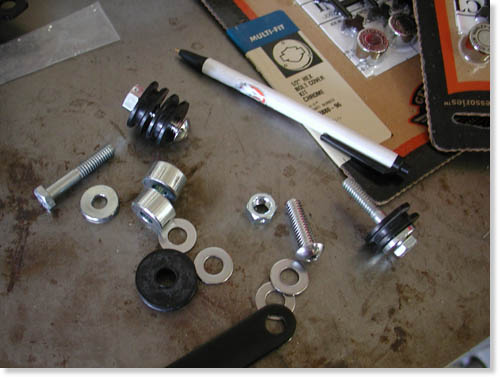
Here’s a handful of the fasteners and bag bracket spacers.
I ordered the front and rear detachable docking hardware kits, but be careful. I leaned toward the new lower backrest/sissybar for styling, which wasn’t in stock, but the pad was. I bought it, then the backrest was back-ordered so we bought the taller sissybar for immediate gratification, but when we got home the pad didn’t fit and we were forced to buy the tall pad. Watch out for this dilemma when ordering. Make sure to check all the installation instructions to make sure you have the correct puzzle pieces. There are several back rest options so watch that aspect when ordering.
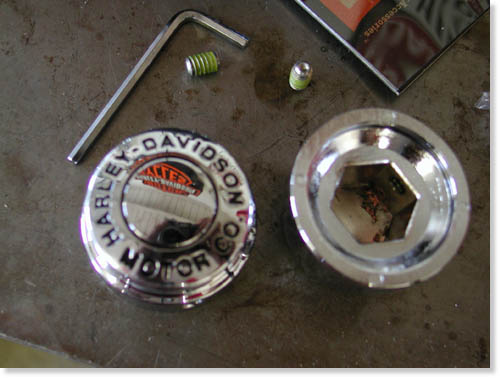
Here’s the massive chromed Classic H-D axle dress hardware.
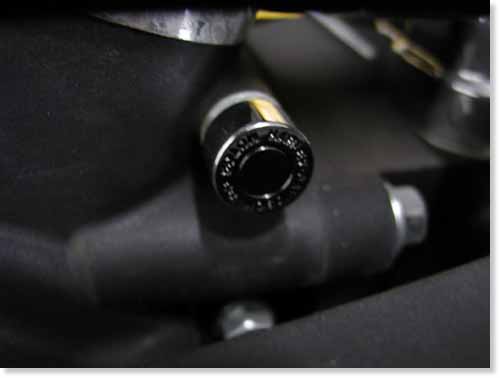
This is simple installation. Slip on the plastic wedge and the cap grips over it. Push them into place–done deal.
We also ordered some classic hex bolt covers and stainless Allen caps to begin an engine detailing process. We purchased chrome caps to detail the front brake calipers and classic chromed front axle covers. We didn’t use the plastic chrome caps ultimately but brush painted the raised edge of the calipers black. I’ll tell you why in a bit.
This was supposed to be one of the easiest mods we undertook, but we learned quickly, that wasn’t the case.
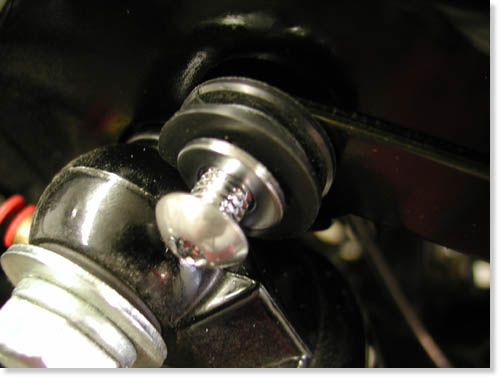
This is the front docking port in place, but not tightened.
When we black powdered a ton of components previously, we assembled the bike securely with Loctite and care. That was our undoing. The Phillips-head beside the shock needed to be replaced with the front docking hardware. Take one bolt out and replace it–no problem, right? The Phillips screws wouldn’t budge and we proceeded to strip the heads. First, I wished I had an impact driver.
I discovered an aerosol spray by Chemsearch called Yield in the auto parts store that loosens rusted bolts instantly. It worked like a charm, with a little patience the bolts came lose. An American Rider reader complained that this product isn’t available in retail stores. That’s true. My longshoreman connection hooked me up. You may need to find a factory worker or mechanic who has a connection.
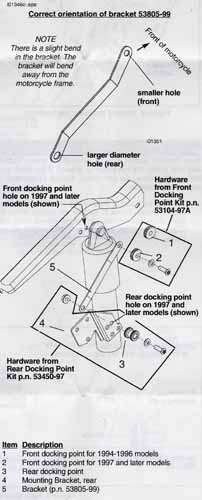
After reading the Low Detachable Backrest kit info that came with the taller kit, the Backrest Docking Hardware kit directions, the Front Docking Point kit instructions and the 100th Anniversary FLHT and FLHR Backrest Pad kit directions, I guzzled my first Corona.
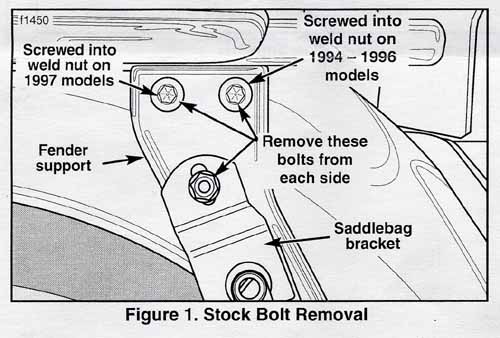
I opened the next Corona. The operation would have been simple if the directions were. I read them over and over. There were too many variations between years and configurations to sort through. The Front Docking port directions confused me with illustrations involving rear bag support spacers designed to bounce out the saddlebags and clear the release button on the backrest.
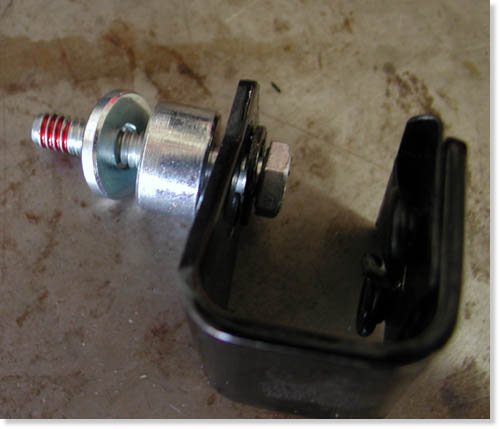
This was a matter of trial and error.
If you’ve built choppers as long as I have, there’s always a way to make anything work, so ignoring the confusion, we spanked our asses in gear. I ignored the spacers, installed the front docking rubber that was designed specifically for the King with a notch for the shock.
There’s a bracket that runs from the front docking station to the rear, but first the rear docking port bracket needed to be installed. On some models equipped with air shocks the shock filler bracket must be removed. The directions said I didn’t need to remove it on the 2003, bullshit. It was directly in the path of the docking bracket, so off it came.
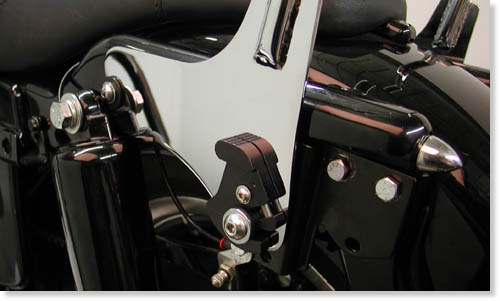
This shot shows the bracket in place, with the shock air port moved. Note the single empty hole in the bottom of the bracket. That’s where the rear bag mount bolts into place. The trick of the night.
Three lousy bolts had to be removed, the rear bag bracket 1/4-20 fastener and the two 5/16s fender support bolts. First the 1/4-20 spun the thin, tin clamp that holds the nut in place. Then the 5/16, once removed, could hardly be replaced. Nothing aligned properly. My lovely assistant had to squat and lift the tip of the fender, and in one case we were forced to remove the lower bag rail to align the top bolts.
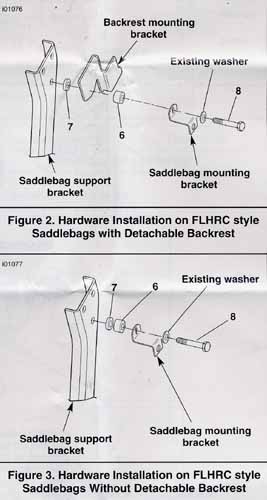
This still doesn’t totally jive. Actually washers had to be fed behind the top Backrest mounting bracket also.
“Can I let go of the fender, now?” Sin Wu asked grunting. The top docking port bolts are packaged in two sizes, 1 inch and 3/4 inch. The directions warn that if the rear inch-bolt comes too close to the fender, replace it with the 3/4. We replaced both and used the 1-inch jobs in the front holes on both sides.
Without the rear fender rack detachable bracket, another option, two washers were thrust under the rear docking port bracket to make up for the thickness of the rack bracket.
Part of the confusion was the numerous detachable elements available for various models. There’s also the two-up detachable rack front docking kit that surfaced from time to time.
That’s all there was to it. We bolted all the elements in place and tested the back rest and bags. Sure enough the King Classic bag lid smacked into the backrest latch when opening. We ultimately spaced the rear back bracket out only about an 1/8 of an inch and we were good to go.
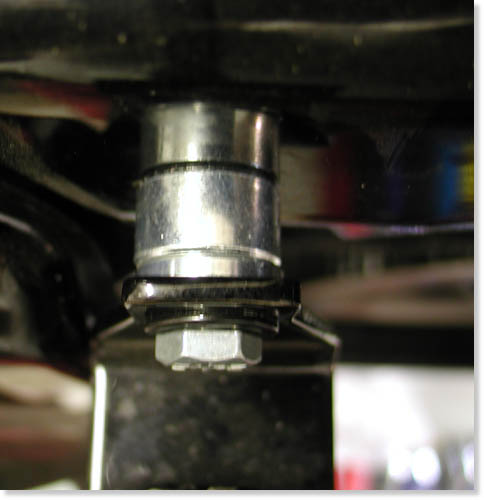
We tried it with the spacers, without, then with smaller spacers that worked perfectly.
Sin fed me chips and salsa and dabbed my sweating forehead with a bandanna, while I slipped the saddlebag bracket, 1/4-20 nut, into place using a long magnet. It worked on the right side. On the left we unbolted the entire fender support, replace the nut, adjusted the thin, tin tabs, and bolted the sucker all back together, only to have the nut fall out again. In this case we squeezed a slim square 1/4-20 nut behind the docking bracket and bolted the back bag bracket on with a spacer. It worked like a charm.
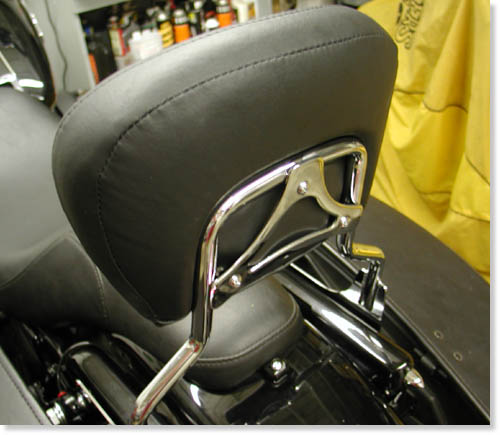
“Can we ride?” Sin cooed. I told her to gear up. We were just about ready to roll.
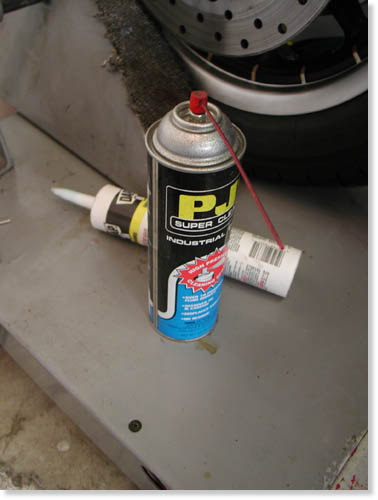
I used electrical contact cleaner to loosen the tin insignia plate, but discovered that wasn’t the intended plan. Leave it be, goddamnit.
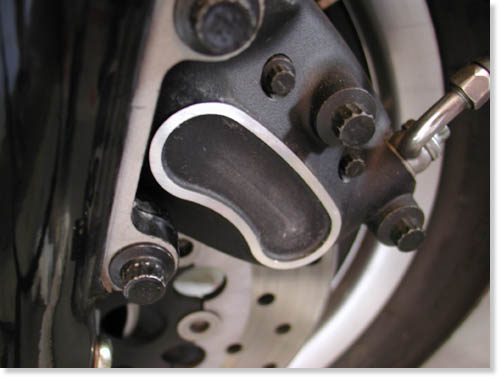
Here’s the totally clean caliper. Big mistake.
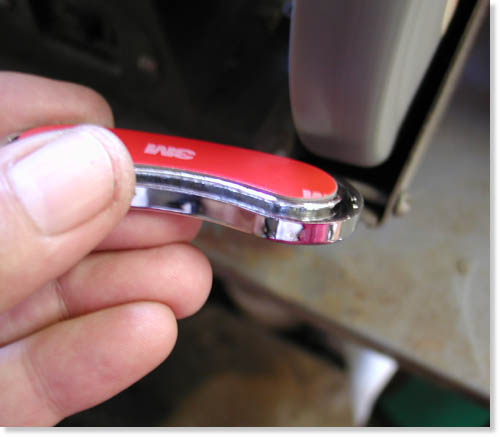
I ground the lip unevenly, but it then fit into the recessed slot on the caliper.
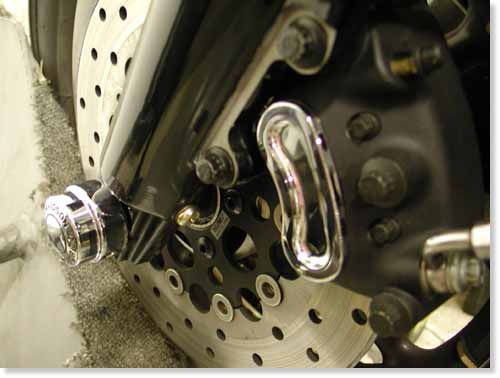
After grinding, all was well. Sorta.
The air in the garage eased as I warmed to her company. For an easy half-hour we played with the details of the bike by installing nut caps and front axle caps which I snugged down against a coating of silicon to prevent vibration.
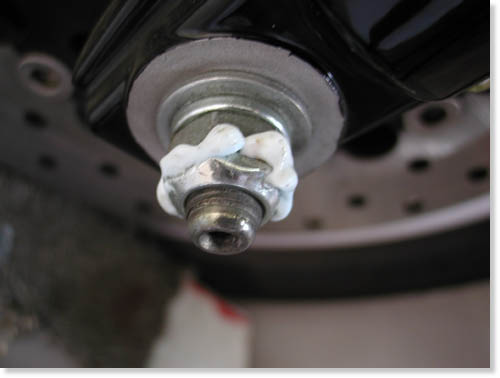
Some silicone on the axle nut will prevent vibration that may loosen the cap.
I discovered that the front chrome caliper caps stuck directly against the existing tin insignia. I took one off and cleaned the area thoroughly with electrical cleaner then the self-sticking surface didn’t reach the base.
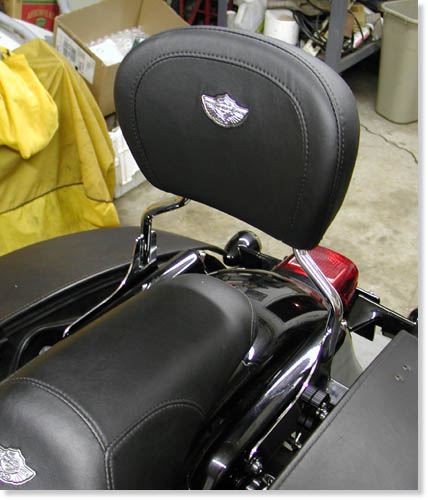
Here’s the 100th Anniversary backrest that will not fit on the short back rest bracket. We sent the short unit to Custom Powder Coating, in Dallas, for a coating of black.
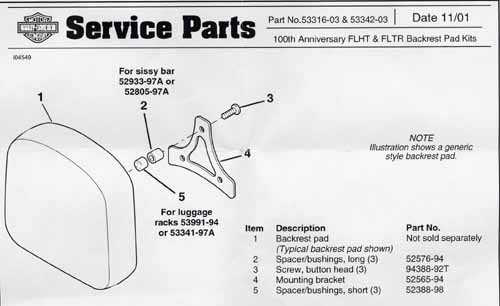
Note that there are various pads and various fasteners and spacers for different applications. Don’t try using common sense.
I ended up with 1/2 pint can of Rust-oleum paint and a small brush for touch-up details. I sent Sin Wu in the house to prepare for the ride. That meant striping out of her threads and waiting for me in bed. It’s the code. We must workout before we ride.
–Bandit
Editor’s note: I’m sniveling through this, but I’m sure with some experience this would have been a breeze. I suppose that’s what dealerships are for.
Sturgis 2000 – Part 1 Whiskey, Women and the Open Road (Continued)
By Robin Technologies |
|
Continued from page 1…… I was about to reach for the phone book one morning, on an ass-saving spring hunt, when the mail arrived with an invitation to the Harley-Davidson new-model announcement. At that point I was spending every extra moment in the garage and interruptions were a problem. But the factory has always been supportive and I couldn’t miss the new bike review so I signed on for the event. It took place in Pasadena and all the moto-journalists from the Southern California region were on hand. Occasionally during the presentation I would peer at the list in my pocket and go to the dingy corner where the heads were to make a call about chrome or parts, or I’d call headquarters to check in with the crew. Some years the Harley announcements indicate business as usual at the factory with only minor changes. This year was a vast contrast to the status quo. It was immediately evident the company was making strides to capture a larger segment of the aftermarket with its accessory production pace and the focus on custom parts. The models radiated custom touches. They had finally truly lowered a bike, the new Lowrider Dyna. Road Glides were getting much more engineering attention. Performance was advancing quickly with a Holley Carb introduction and big-inch motor kits. Some of the new paint schemes reached deeply into the custom culture for colors and designs.
Then they came to the new narrower, lighter, police model for 2001. Cop bikes didn’t mean a hill of beans to me, but I scanned the more agile machine that is now available for individual sales and they’re cheap. Dan Ackroyd should get a new one. I noticed springs under the solo cop saddle and immediately jumped to my feet. Two representatives from the factory rushed to my side. “Can we help you answer any questions about the new police model?” one of the engineers asked. I started babbling about this stretched rigid I was going to ride to Sturgis and the two contemporary thinkers backed away as if my radical concept might rub off on them. I ordered a set later that day. They proved to be … well you’ll see. The frame was sent to the powdercoater, the chrome went out and the sheet metal was shipped to Harold’s. The waiting game began while I chased any missing parts. By the time the sun was blazing in the single window of our tiny headquarters, the frame was back in the garage and up on a towel-covered lift. The chromer made me wait another day. I was in the midst of a bolting-together orgy when the dark-haired one appeared in the doorway of the Bikernet den, peeling out of her threads.
Her alabaster skin looked like cream flowing into a hot cup of coffee. The satin shaved surface was too delicate to touch. What the hell is a biker to do when heaven is standing nude in the doorway? The crew was looking at 34 days until departure. I was looking at green eyes, a sensitive smile and … priorities men, priorities. It was a factor of hours and parts availability, plus watching for problems. Everything was seriously locktite drenched, tightened and tightened again. I notice a weak link immediately in the wheel spacing. This was an odd, uncalled-for operation. You buy wheels, they come with spacers. You install them and it’s a done deal. You go for a ride. So what was the problem? The tubes had been cut and collars added to assist with holding the grease near the bearings, and to hold the spacer centered when the axle was removed. They weren’t shabby. The dilemma made me second-guess my installation. I checked and rechecked the life-threatening problem. If I left them alone, I would certainly be a candidate for a high-speed wobble. If I set them up too tight, I could burn up the bearings in the desert and be left alongside the road to fry in the sun. Something had to be done to correct the wheels or find out where I went astray. With spacers the correct length, the wheels and brakes could be installed for the last time and anything that could reach final assembly made me smile and saved time. We were frustrated. I centered the wheel and began to space the P.M. Calipers. Something wasn’t right. There was .020 slop in the center spacer that pre-loads the Timken bearings. I was blown away and stayed up until 2 a.m. with a sheet of glass and wet and dry sand paper trimming the spacer down while insuring the flat parallel surface to the bearing race as left intact. I finished uncertain of the tolerances. Later I found that the tolerance prescribed by the factory is .004 to .014. It is recommended that with aluminum hubs you should lead your figure to the .004 side. There was another weak link and Harold mentioned it as soon as he received the mounted Sportster Tank. “That tab system is a little shaky, Bandit.” What could I do? I had two 1/8-inch-thick straps that ran the entire length of the tank and out both ends by three inches. At the last minute I eliminated one because I felt it would be too difficult to bondo. The tank was now in Harold’s hands and time was running out. If I had sent the bare frame to Harold, he would have mounted the gas tank by his proven method. The decision had been made and I would be forced to live with it. We kept moving. Ah, but there was another adjustment that lurked in the back of my mind, although Giggie from Compu-fire checked my installation and gave it a thumbs up. I was sketchy about the primary drive adjustment. I had slipped the original inner-primary O-ring between the engine cases and the motor plate for vibration relief. Bad move. The BDL belt was too tight.
There was no slack in the belt and I wanted some. I had to loosen the transmission, unbolt the motor-plate from the engine and move the tranny forward as much as possible. It worked out perfectly, but just in case, I ordered a spare belt (I broke a primary belt in ’97 outside Denver). Giggie from Compu-fire helped kick off the wiring with the installation and timing of the Compu-fire single fire ignition. With it in place sans the Voes switch (this is a chopper, right?). About that time, a tall Asian in a flowered bikini and a black towel strolled past the headquarters on her way to secluded Cabrillo Beach. The entire crew was distracted. It wouldn’t be the last time Sin Wu captured my concentration. She became our lunch time mascot, dropping in from time to time to check the progress and tantalize us. The rear wheel had yet to be spaced properly. It suffered from the same malady as the front wheel and the last thing I wanted storming through my brain at 5 a.m. on a highway in the middle of nowhere was my wheel spacers. We were forced to remove the rear wheel again. I had built in a stud for the hydraulic brake switch behind an exhaust pipe as part of the exhaust bracket. The notion was to hide that ugly bastard yet make it accessible if need be. As it turned out, Joker Machine builds a micro brake switch into their forward controls. Ultimately a dice was drilled and tapped to conceal the stud. Just as I finished the wiring, the paint was delivered. Harold and I discussed the paint scheme at length. The first problem was the frame paint. We were limited to a bright metallic blue. I sent Harold a chunk of square tubing painted the same color to match. He studied it and went to work. We discussed white pearl or cream colored flames and he decided to add a silver accent. We couldn’t decided what color to pinstripe with. We discussed red, pink (no way), even green, but nothing jumped out at us. When Harold called and said he’d pinstriped it gray, I choked. It sounded drab, lifeless. A week later, after clear coating and drying, the paint was shipped. I had become best of pals with the UPS guy, who showed up daily. When he showed up with a small package he’d be greeted with a long face from a disappointed crew member. “We need bigger boxes and more of ’em,” Wrench told him one morning. We did. We were biting our nails, watching the clock and the calendar. The plan called for a running motorcycle two weeks before the takeoff date. The first stretch of road to Phoenix was 450 miles of blistering desert and I was riding alone. I needed a break-in period. Most years we had little or no break-in time. Last year the Excelsior-Henderson had no miles on it after High Tech Custom Cycles customized the rowdy 85-inch monster. I had it for two days before leaving. The first day the front brake kept locking up and we discovered chrome chips in the front master cylinder. With that fixed, I thought I was good to go until the starter motor blew up in my face the night before takeoff. We made arrangements with Bert’s Cycle Mall in Azusa to fix it. I hired a guy to drive my truck, my bike and me to Bert’s, where we sat for half the afternoon while they replaced the starter and some fried bushings, then retuned the bike with a new computer program. Dr. Hamster and I sat in their waiting room with our gear and waited patiently for the verdict. It finally came with a road test by the main mechanic. He rolled out of the parking lot without making eye contact with either of us.
The year before that, it was the street stalker built essentially by Bartels’ Harley-Davidson. Before that, it was the touring chopper built by Jesse James. All of the above are professionals who are constantly building bikes, have mechanics and extensive tools and supplies. I’m not, and my guys all work on old Panheads. So when we took on these projects as non-professional, skirt-chasing, beer-drinking geeks, we wanted more time to correct all the bullshit mistakes we would make. As it turned out, we didn’t make any more mistakes than the pros had in the past. Plus the feeble, leaning Bikernet headquarters held nearly every tool we needed to keep the operation going. As the sheet metal arrived, Sin Wu and I slipped into the basement of the vast Bikernet headquarters to un-box, un-peanut, un-bubble wrap and un-cellophane the paint. The gray pinstripe was perfect, the finish clean and classic. We made love in the basement in celebration and as a tribute to the notion that this underground slab of concrete would soon become the international Bikernet shipping and receiving department. Fuck, life can be exciting. Sin went home and the brothers began to install the tank and sheet metal.
We were moving fast. Time was running out and days seemed to disappear. At one point, we had the grandiose notion that the bike would be ready for the Exceptional Childrens’ Beach Ride in Ventura, California. We couldn’t make it. Then the Calendar Girl Show loomed. What was once the Mikuni Bike Show at the Santa Monica Airport had transcended into the Calendar Girl/White Bros. Show in a small park near the looming bow of the Queen Mary. Cool location, but could we have the bike up in time? Wiring went easy with the internal tubing installed in the frame by Daytec. Tubes ran from the back of the seat post to the top motormount and down the seat tube to the oil pump. I quickly discovered that I could run two switches in the top motormount and Giggie suggested a polished aluminum plate to conceal the switch backs and the single circuit breaker. Giggie emphasized that we use mil spec (military specification) or Marine switches. I had purchased plastic Marine switches but wasn’t confident in them. I wanted to head over to Neptunes Electronics for some heavy duty mil spec metal units, but it never happened. The wiring continued with two switches to control all the electronics on the bike. An on/off switch turned on the ignition and the brake and tail lights and energized the high/low beam switch. The on-off-on switch controlled the headlight and that was all. For the starter switch we used Custom Cycle Engineering’s new mechanical push button, which mounts directly to the starter solenoid of the Compu-Fire starter. It’s the cleanest switch in the world and works like a champ, but if your pipes come anywhere close to the switch, watch out. It’s easy to burn your mitt when the bike is hot. Plus the switch is bolted to the right side of the bike and down low. If that’s going to be a problem with the carb and reaching the throttle, you need to consider those obstacles. It worked like a champ on this rigid with the pipes we chose. For our pipes, we picked a set of Samson 2 1/8-inch drag pipes for a Dyna Glide because they don’t make pipes for rigid frames. From a performance standpoint, I wanted the 98-inch S&S stroker motor to run as effortlessly as possible. I had discovered by mounting a Compu-Fire single-fire ignition system on the touring chopper that it calmed that stroker motor, so I did the same on this one. I wanted to even the exhaust system for firing balance. One pipe was 12 inches longer than the other and hung down too far, which would hamper ground clearance. We took two inches out of the down stroke. Wrench gas-welded it back together with a coat hanger. Then we cut the pipe to even the lengths to 27 inches. That seemed precariously short for the diameter of the exhaust, so we took two Samson exhaust muffler baffles, cut them in half and installed them. Finally, for styling purposes, we asked James Famigatti to scallop the ends of the pipes to contour the shape of the Milwaukee Iron fenders. We called Mikuni America and asked about the carburetor. Lee, the man responsible for every Mikuni carburetor that flies into the states for motorcycles, asked, “For your bike?” “Yep,” I said. “You’re going to install it?” “Yep,” I said. “Forget it,” he said, “Bring the bike to me. We’ll make sure the intake is correct and the cables match, and that the bike runs.” I didn’t know what to make of it, but I did as I was told and delivered the bike to the Mikuni factory. With the swift action of Barnett cables, S&S and American Iron Horse, the correct intake was procured for the tall barrel S&S stroker engine that tucked the polished 42-mm slide carburetor in close to the engine. They fired and tuned the bike for the first time. The technician, Bryan, warned us to back out the air mixture screw half a turn when I reached the altitudes of Denver. They also installed a large tear-drop, exposed K&N air cleaner that would afford the engine all the air it wished to gulp. Time was running out. We still needed miles on the bike but we had no speedometer and no idea where to put it. The cable was in the garage and the drive unit had been installed on the front wheel, but the actual speedometer was nowhere to be found. Then it dawned on me that the ’84 Shovelhead in Dallas had just the speedometer we needed, but planned not to use. I called and asked the crew at Dallas Easyriders to ship the unit quick and it was on its way.
|
Sturgis 2000 – Part 3
By Robin Technologies |
|
The next morning, after breakfast at Stan’s diner in Scottsdale, we rolled north toward Payson on our way to Holbrook. Stan’s is a small joint in a dull rectangular building downtown, that Stan tried to spruce up with adobe chairs and tables. A skinny waitress came to take our order but since this was Myron’s regular digs, he went directly to the chef in back and nodded. That was enough. The chef knew what to do. Karl and I attempted to order with smiles on our unshaven mugs but the waitress was dry as toast, and edgy. The cactus twig of a woman could not comply. We had been trying the low carb regimen and Karl had lost 40 pounds, but she couldn’t allow us to substitute potatoes for tomato slices or cottage cheese for toast. We ended up ordering everything a la carte. At first our easy-going hackles were raised because we wanted to hit the road early and slice away some dusty miles, then eat in some strange hole-in-the-wall joint in nowheresville, Arizona. But the more we irritated her, the more fun we had. She was spitting in our scrambled eggs by the time we finished with her, but it was worth it. Phoenix is a strange city. Surface streets are straight and packed with stoplights. We headed out a country road through one boulevard stop after another. Suddenly we were out of the flat city and into the country, winding into the Mazatzal Mountains on Highway 87. At one point we pulled off the highway at an All-Bike junkyard Rye, Ariz., a town with a population of 300. There were acres of bikes rotting in the elements.
 At this point there were four of us. Myron was riding his black, detailed 2000 Dyna with a 95-inch kit, stretched tanks and a custom windshield. As usual, his bike was immaculate with chromed Harley mags and diamond cut cylinder fins. He had soft bags beside the rear wheel and a bolt-on sissy bar with bags attached. He was one comfortable mutha as we cut through the canyons. The man generally wears a long sleeved T-shirt with a regular T-shirt over it and his HAL vest, plus a scarf. He rides fast and tight. Myron has always reminded me of longtime friend George Christie, the president of the Ventura chapter of the Hells Angels. Although Myron is a massive weight lifter, and George trains in martial arts, the two men are similar height with jet-black hair (graying some, now). Both men are born leaders and strong riders. Karl was on his lowered Softail with drag pipes and drag bars, with his buoyant wife of 25 years at his back. The couple have raised three gigantic kids, consequently Karl doesn’t have new bikes yearly, custom paint jobs and chrome. He’s saddled with a non-working mother and three money-soaking monsters to raise and he’s proud of every minute he can keep the clan in college, clothes and wheels. I respect the fact that Cheri stays home with the kids. It’s a full time vocation and perhaps the most important job on the planet.
 The mountains were striking and I’m constantly amazed at the Arizona beauty. The state is diverse and open. No wonder people are lining up to move there. It’s a killer place to live. The diversity is unreal, from the arid, open, hot-as-a-mutha desert to the rolling, pine-strewn mountains and the Grand Canyon area. We stopped in Payson for gas. I had clocked 87 miles and took 1.9 gallons. I was still rolling along even in erratic terrain and getting 45 mpg. I bought a cheap tire gauge and checked my tire pressure. Brownie had jacked it up per the tire specs, but I was more flexible and had another priority — the ride. The front tire being on an extended front end didn’t need 50 pounds of pressure and the rear 180-18 Avon needed to be as soft as possible, so I dropped the 40 pounds to less than 30. As I stood there, Cheri chatted away about one thing or another, constantly making sexual references to the most absurd articles. She somehow found honey mustard dressing sexual, or elevators, though I could understand her phallic reference to pickles. As we moved into the hills, the incline felt good to the 98-inch S&S motor. Rumbling up a winding incline, we found ourselves behind several motor homes and a logging truck. When we hit a passing lane, two tourists melded to the right and the logging truck and one camper stayed to the left as if in a 1/4 mile they could pass the other dog-slow travelers. I down shifted and poured the fuel to the stroker, which climbed on the other vehicles like they were standing still. The lumber truck was barely reaching the rear bumper of the motor home when I split between them. I blasted over the rise ahead and began a high-speed decline. I slowed slightly to let the others catch me, but they didn’t come. I slowed some more, then suddenly noticed a thundering 18-wheeler bearing down on me. I had upset the trucker and he planned to flatten my ass. The rigid Blue is light, and I was discovering lightning-fast throttle response. I bolted forward. I spun the throttle, again, and it came alive like the crack from a high velocity .22. Then I noticed a new vibration. It was coming from the tank. The truck was trying to gain on me again, and I slipped the polished 42-mm Mikuni more fuel and she responded like a tongue to a sensitive clit. The bike jumped and roared ahead. Again, a rattling screamed at me from the top of the frame and I pulled my gloved hand off the left grip and put it on top of Harold’s paint work, which glistened in the sun. My teeth immediately responded to the touch. Something was wrong, but I had a semi barreling down on me and I couldn’t stop. I didn’t want to pull over and give him an open target so I pressed on the tank with my left hand and pushed harder on the throttle with my right. I raced past the signs indicating a dangerous decline ahead and warning truckers to check their brakes. The guy behind me had no notion of using his as he sped to catch me. Fortunately, I could outrun him, if I were riding a bike built for mountain riding. This was my first opportunity to test the handling of the 38-degree raked frame with the 6 degrees in the Weerd Bros. front end. I had specifically built in plenty of ground clearance by cutting the Samson pipes and lifting the front header. There was nothing on the left to interfere with the road and I had a solid six inches of ground clearance underneath the frame. As I leaned I felt the bike want to tumble so I poured more fuel and the front wheel tracked the corner smoothly. The next corner was well marked for speed and curvature. I dipped low and accelerated. Although the rake generally, with speed, wants to force the bike to go straight, the additional rake in the triple trees minimized the trail and the front end adjusted easily to the turn, but I was trying to hold on to my vibrating gas tank at the same time. Another series of turns were dead ahead and the screaming logger was shifting gears 30 feet from my rear Avon. He knew the road better than I did. I took the shift as a signal of manageable turns ahead and turned the throttle. The bike jumped forward and I released the tank to handle the curve. To my left were open oncoming lanes through sliced mountains. To my right was a sheer precipice and a majestic valley a couple thousand feet below. I pushed the Blue Flame and it responded like a thoroughbred. It felt strange. I had ridden choppers for years, but in the last decade I hadn’t ridden a bike with this length of front tubes. The Jesse James touring chopper had a severe turning radius restriction with the bags, but this machine seemed to have no bumpers, no drag, no pegs that prevented me from leaning it closer to the asphalt, so I pushed. The only thing that would hold me back from making the next turn was Avon traction, a flexing Daytec frame or a squirrely front-end. I seemed to handle turns to the right easier than to the left, and I dipped as the curve unveiled itself. The truck was right on my ass as I hit the 35 mph turn at 60. The most terrifying aspect of any turn is the visual. Can you see the chamfer and the complete arch? Is there a mountain on the inside preventing visibility? Are you heading downhill? Downhill racing is the worst. You can let up on the throttle and the bike won’t slow down. That’s the last thing you need when you realize that your bike cannot make the corner. I needed deceleration and it wasn’t there. I had pulled away from the truck, but the tank was singing a violent tune. I ignored the horrible vibration and dipped the machine to the right. To my amazement, it went over easily. Nothing scraped, skipped, twisted or jiggled. The tire remained firmly planted to the road’s surface and I accelerated through the turn and into the next one. The truck loomed behind me except it wasn’t barreling after me this time. The postings along the side of the mountain warned of the steep slope, brake testing and slow trucks. The driver had chosen to ignore the warnings and careened after me, but now in the rearview mirror the trucker’s load seemed out of balance. The massive logs were jostled. The truck leaned at an odd angle. The driver had abandoned the pursuit in favor of saving his own neck. Smoke poured from the brakes as he tried to control the 80,000-pound vehicle before he encountered another curve along the perilous slope. I glanced at the valley below and decided he was more of a threat now than when he was pissed and in control. I turned up the heat and headed quickly away from the collision-bound truck. We had several junctions ahead, including 377 to Holbrook, 277 to Snowflake and 260 to Show Low. With each curve I was forced to test, I became more confident in the Daytec chassis and long Weerd Bros. wide glide front end. I had never owned a chopper that handled with this much ease. I seemed to be able to dip the flaming scoot over so far that my calf was parallel with the pavement. I hit the town of Heber where we had planned to stop for a piece of peach pie, but I blew right through. I passed the 377 turn off and prayed that the trucker survived, but was on his way to Snowflake. I split off on 260 toward Show Low and quickly found a safe place to pull over to check my tank and wait for the others. The rear tab on the tank had broken and the vibration between the remaining tab was eerie, but with the 3M weather stripping holding the tank to the frame backbone and the front tab in place, all appeared secure. Myron pulled up with Karl and the emotional Cheri shouted, “That truck was after your ass.” We only had another 30 miles to go but we hit a hardware store and, based on expert breakdown recommendations from Karl and Myron, I picked up more 3M stripping, JB Weld, sand paper and some grommets. I rode carefully for the final 30 miles into Holbrook where we copped a couple of rooms and prepared to operate on the Blue Flame.
 I almost had to pry the tank off. The rear tab was toast and I spent an hour cleaning it. I mixed and spread the JB weld, put down new 3M weather stripping and reinstalled the tank. It was time for happy hour and we walked to the local cowboy/sports bar across the highway. There’s an odd sensation that comes over a rider with a busted machine. It’s as if you know you must hike to the top of the hill, but you’re bleeding. You know you’re going for it, but not sure how you’ll make it. Still you keep moving forward. Holbrook was our stopping point about 250 miles out. The bar was cool and for some reason, perhaps the unrelenting heat, we ordered margarita after margarita, then chicken wings, chicken tenders and more wings. Those little puppies were smoldering but went down like chips at a Mexican restaurant. We munched as if we weren’t going to eat for a week, then went in search of peach pie. Why is it that once out of California, fresh vegetables and fruit seem impossible to come by. If I couldn’t have sex, I wanted peach pie, and for some odd reason, it seemed as rare as a whore in church.
|
Sturgis 2000 – Part 4-2
By Robin Technologies |
|
 The Harley shop in Green River didn’t have it, nor did any of the other bike shops in the valley, but there was a shop in Aspen. It wasn’t in the phone book and couldn’t be reached by directory assistance. I called the Harley shop back and was given the number for Aspen Custom Motorcycles. I dialed and there was only an answering machine. Tired and dejected, we rambled back toward town. During one of our last installation attempts, we broke off the stud that held the rear tab in place. Now we needed an auto parts store for a large hose clamp and some rubber insulation to prevent the clamp from tearing through the durable powder coating finish. We pulled up in front of a Napa auto parts store and parked beside a blue and silver pickup with Krylon letters across the back window, “Aspen Custom Motorcycles.” Inside, a thin man with dark hair and youthful features leaned over the counter wearing a black Aspen Custom Motorcycles T-shirt. I introduced myself and he asked us to follow him. Two blocks away, this guy had his shop set up in a single storage unit stall (970) 544-9419. His undercover shop was complete with three stage creme sealer and we bought his only kit, thanked him and hauled ass for the Swank Hotel. In front of our room was an outdoor corridor leading to the bar and outdoor pool. I picked up several towels, borrowed a large bucket and we went to work. The first stage was a mixture of water and a strong detergent that was supposed to soak in the tank for four hours. We didn’t have the time and let it set for an hour. In the meantime, the guys in Randy’s room where having trouble with the plumbing. After I flushed the toxic mixture into a bucket, I poured it down the toilet in Randy’s room. I knew I should have stopped, but I was beyond the point of no return. I returned to the bike for stage two – flushing the tank with a strong solvent. Again the remnants of the explosive liquid were drained into the toilet. Meanwhile, hotel maintenance men and managers descended on Randy’s room, where a couple of riders had set up their joint rolling station. Plungers, tools and snakes were moved from room to room. Four rooms were effected and they were going to have to snake down from the roof. Randy shook his head. “Won’t work,” he said and poured the final stage of thick milky fluid into the tank. This process included sloshing the creamy liquid around the tank for 10 minutes, letting it set for 20, then sloshing again before draining. Randy sloshed and coated the lining of the tank for what seemed to be hours, making sure every crevice received its fair share. By this time evening was upon us. The tank was supposed to dry for 24 hours. I didn’t have time and Randy suggested that we use a hair dryer to speed up the drying process. The instructions specifically warned against the use of hair dryers because the final process was extremely flammable. Randy continued draining the thickening substance back into the bottle it came from, as we pondered the question. At one point, we tried putting the tank in front of the air conditioner to augment the flow, but there had to be a better way. Finally someone hit up the maintenance crew for a shop vac. As the sun sank, we started sucking the fumes from the tank outside our room.
 At one point, two girls showed up, one 22 and the other 27. They wanted to smoke a joint and party some, but the fumes held them at bay. Both were wearing shorts and tank tops and carrying shopping bags. One included a couple pairs of spiked heels that they quickly unwrapped and promised to sport for us. One had on a top buttoned up the front over no bra, and her tits were pressed so hard against the mint green fabric that the heavenly mounds creased the material. When she leaned over to slip on the shoes, we gasped in unison. Whatever it is that makes a woman’s body magic to a man, is a wonderful thing unless abused by either party. If a woman minds that a man gawks at the flesh exposed by too little clothing, she should cover herself. These girls didn’t mind. In fact, they enjoyed it and wanted more. We could have given in to them except we had a mission and a deadline. After the girls asked some probing questions and we didn’t respond appropriately, they rolled themselves a doobie and departed. There was another problem with nubile girls finding their evil ways into our lives. We were staying with 100 of our closest, most gossipy friends in the same goddamn hotel. Speaking of gossip, I hadn’t heard from Zebra for two days. He was supposed to hook up with a pack of riders in Tennessee, and perhaps they roasted him instead of a pig. I didn’t know his whereabouts, but I kept calling his cell phone hoping to hear the number had been permanently disconnected. At 6 a.m. Friday, the phone rang. Larry the mobile mud slide maker was leaving his room to meet me in the parking lot to lend me gas. I was hoping to sleep in, but noooo. I wrestled my ass out of bed and out to the bike with the tank. After setting it on the bike, it was difficult to tell that it had been through hell the previous day. I mounted it, hooked up the lines and went back to bed. I told Larry never to call me at 6 a.m. again and to keep his gas. I wanted to let it air for a couple more hours. At 9 a.m. we put gas in it for the first time from Howard’s truck, just a quart. We loaded up and hit the first station. We were Denver bound. Some of the guys were heading into the pass above, but rumor was that the straight shot was down to Green River, over to the 70 Freeway and into Denver. It was 30 miles out of the way, but we chose the straightest shot. The freeway is only two lanes wide but it meanders along railroad tracks and rivers toward Vail. We stopped for gas in Eagle and were passed by 30 Hamsters blasting onto the freeway. How they beat us I will never know, but I sent my navigator his walking papers the next day. We caught the furry beasts outside Vail. Traffic began to bunch up and we kept riding faster, splitting lanes and running the gauntlet between the very fast cars and extremely slow trucks. Treachery was all around us as we crested a pass and could see the dots of a pack of bikes in the distance. The tank was holding and the bike hadn’t burped, coughed or sputtered. It could handle anything I dished out. I turned the throttle and it responded. About 25 miles outside Denver we blew past the guys in yellow and another couple miles down the road it began to rain, then hail. We ducked off the freeway, pulled on our slickers and found a log cabin watering hole.

|
The Amazing Shrunken FXR Part 5
By Robin Technologies |

You’ve been there. You handed the Makita cordless drill toyou’re drunken buddy, and he drilled a hole in your big screentelevision. You tried to wrap the extension cord around his neck andfinish him off. We came close to blows in the garage a couple ofmonths back. I spent days carefully welding chunks of Samson exhaustpipes together to form a one-of-a-kind exhaust system.
All the welds were performed with gas and hanger rod. Thepipes weren’t perfect, but they fit the bill. They were actuallyintended to be prototypes, to be duplicated by a paid professional.After the first pass was completed the pipes fit like a glove,although they were artistically rough around the edges. Nuttboy cameby on his Wednesday afternoon escape, and I handed him a highspeedgrinder and instructed him to round off the welds. I worked onanother project and paid no attention while sparks flew. When he wasfinished he tapped me on the shoulder and said humbly, “Not sure thisis what you had in mind.”
He had ground right through the pipes and left gapingholes alongside most of the welds. In addition, I discovered to myteeth-grinding dismay, that there were still large sections of thepipe ground so thin, that as soon as the torch tip came within 6inches of the surface the pipe melted away. I spent another whole dayfilling the gaps. Who knows what will happen when the struggling bikefires to life. We’ll have the only exhaust system on earth withbaffles throughout.
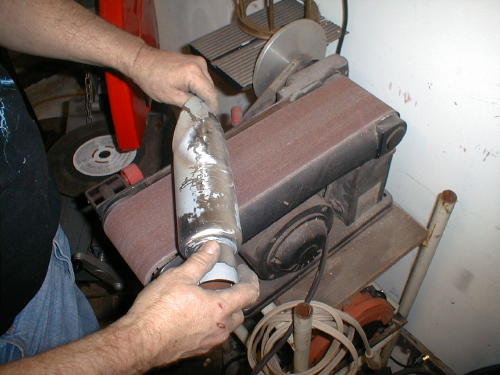
That’s not all. The grief continued. I hand made a mufflerusing a portion of a Samson baffle. We purchased a chromed, truckfender tip from San Pedro Muffler and went to work, but after hoursof screwing with the shiny metal we almost shitcanned the unit. Thefender tip was made out of a strange metal, almost pot metal, thatdidn’t seem to take to the gas welding and wouldn’t respond tobrazing. For every hole I filled, another crack lurked. I welded,then smoothed on a bench grinder only to find cracks and holes tofill again. The shorty muffler probably weighs 50 pounds due to thevast layers of welding rod. As it stands, this is a pure prototypeexhaust system. We should use it for testing then shitcan the rankpiece of shit and start over.
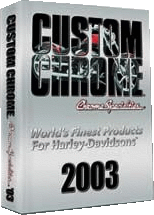
Click to order Catalog!
Frustrated, but pleased with the overall look we were readyfor final metal work. This bike is being built by inexperiencedhands, not professionals, in our backyard garage. Sure, I’ve builtsome bikes, but I wouldn’t consider myself a metal fabricator. I cameup with the initial design and we roughed out elements, but we neededa master metal worker to finish what we started. There are preciousfew, true metal craftsman, who I know. One is Billy Westbrook,another is Jesse James and recently, in the news, we displayed metalwork by Roger at Goldammer (Goldammer Cycle Works Ltd.,www.goldammercycle.com ,1-250-764-8002). High quality workmanship.
They’re out there but not on every corner. I stumbledonto another super-slag artist under my nose. James and LarryFamighetti are Hamsters and own a corrugated steel metal shop inHarbor City, California, called Fam-Art. You’d be tweaked to rumbledown Narbonne Street and stumble across this rusting corner buildingthat’s got to be the oldest swaying dump on the block. Theyspecialize in structural steel (you could never tell it from theircreaking tin shed) for homes and buildings. Large chunks of steel,massive shredders, presses and welders are scattered around the funkylocation that’s reminiscent of the first shack Harleys were built in.

Nuttboy and I darkened their doors a couple of times toask them to flame-cut a couple of chunks of steel for our fenderbrackets. The more I hung around the more quiet-James began to showme steel components he had fashioned for some of the local riders. Herebuilt and reformed Harley taillights to eliminate all the edges andgrooves, then welded them to fenders so that ultimately there were noseams. The more I gawked at the sculptured parts, that demonstratedhis ability, the more I knew we had discovered a man capable of BillyWestbrook fabrication qualities. We hauled the entire FXR to Jamesthe next week.
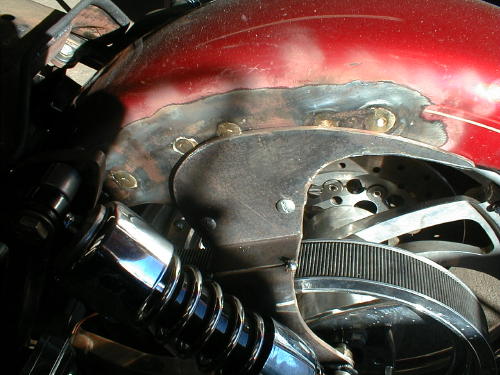
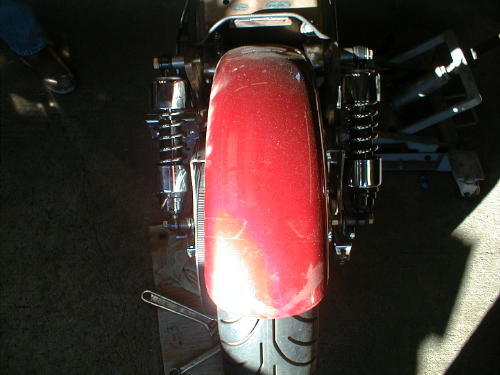
James relocated the straps in such a way to narrow the shockplacement keeping that shrunken look in mind.
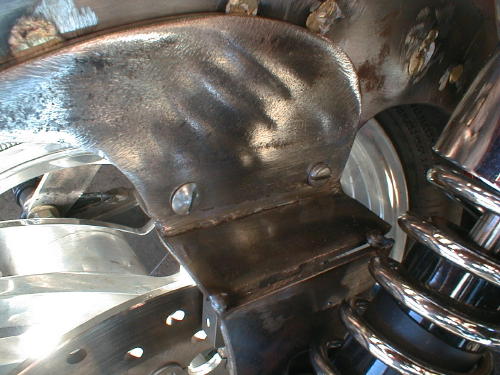
This is a close-up of the right fender strap. It’s beencorrected, reformed and readied for final welds.
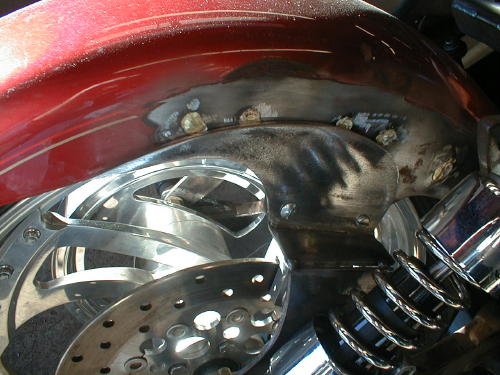

We cut and fitted the tank and made the mounts, butJames filled the underside, rear section for a perfect fit.
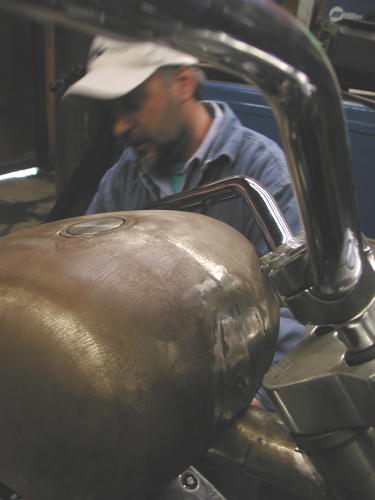
We jacked up the front of the tank and mounted it, butJames filled it and formed the front of the tank to match the customridge along the top. He even made paint work suggestions that I foundinteresting. “If you paint a ridge like this with a light color,”James said, “The ridge will disappear.”
We decided to paint the bike a light House of Kolors pearland create a dark teardrop panel on the top of the tank. He alsocreated and welded fork stops to the neck.
As we rolled out of the shop that day James still hadfinal welds to complete. He straightened out our seat pan, but neededto figure out a mounting arrangement. Finally we needed the CyrilHuze front fender brackets checked and welded into place.
We should have the Shrunken FXR back in our clutches inthe next couple of weeks. We need to finish our rear brake andshifting mechanisms with Giggie from Compu-Fire, fire it up for atest ride and tear it down for paint.
Oh, I need to untie Nuttboy. I need that extension cord.

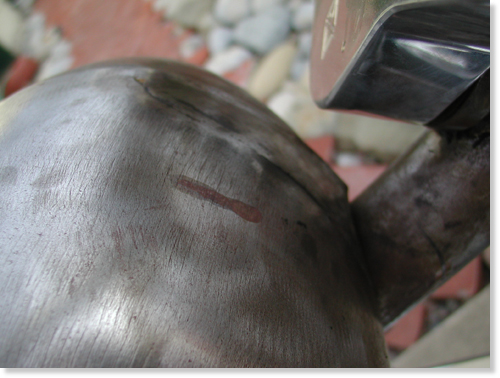
The Shrunken FXR returned recently from Fam Art, in HarborCity, California (310-326-2141). They welded, shaved, mounted theseat, manufactured fork stops and saved our poor- construction asses.James Famighetti mounted our Cyril Huze front fender, welded andformed the tabs and informed us that the Avon Venom was too large forthe narrow glide front end. It was our turn to work on it.
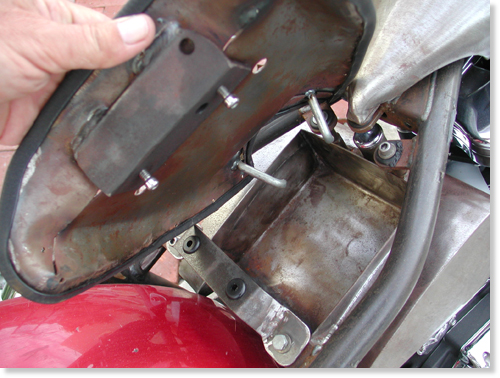
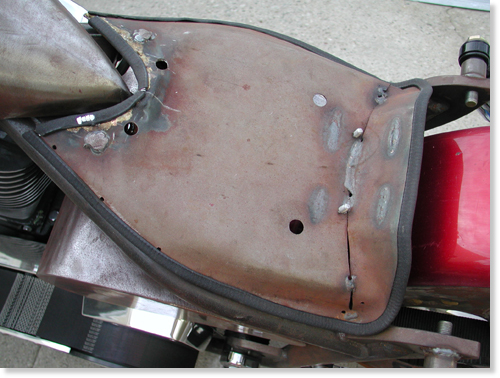
Note that James mounted the seat pan so that the edges wouldnot touch the frame paint in the future.
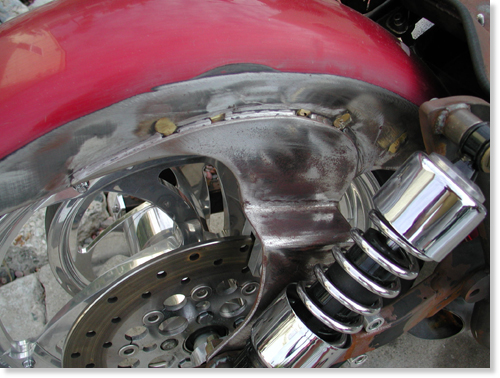
Like any self-respecting bikers we hate to have a bike, oreven components out of our mistrusting mitts. We had another dilemmathat needed handling. The bike still didn’t have a kick stand, and weused two 2 by 4’s, to hold it upright, when not perched on the lift.There’s a trick to this maneuver. If I backed the Pro Street FXR outof the garage and wasn’t hauling the wood planks, I was screwed. Ifalone, I could stand there for hours waiting for someone to strollpast carrying two 2 by 4s–unlikely. After a couple of unsteadyoccurrences, the bike didn’t move without the wood chips on the seat.You can imaging the major pain in the ass this caused.

We ordered a weld-on, Sportster style, kick stand fromCCI, and it arrived complete, with all chromed hardware and thebracket to be welded on the frame. There was one problem indetermining the position. The front Avon was a 100/100 18-inch, andwe planned to replace it with a 90/90. We needed to have the finishedPerformance Machine wheel in place.
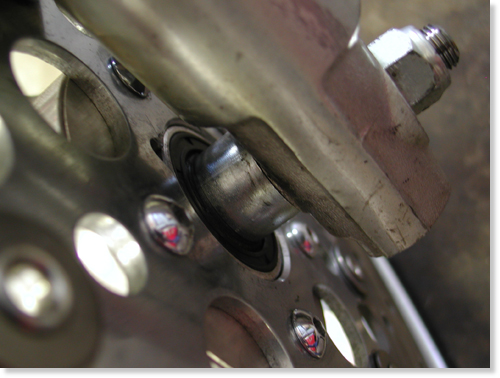
The Avon Road Runner tire arrived, and we had it installed at thelocal Yamaha dealer. James pointed out to us that our front tirespacing wasn’t perfect so I sliced a spacer to give us about a1/4-inch spacer on the right side of the wheel and about a 3/4 inchspacer on the left. The tire, almost centered, now had clearance, andthe wheel floated effortlessly under the modified Cyril Huze frontfender.
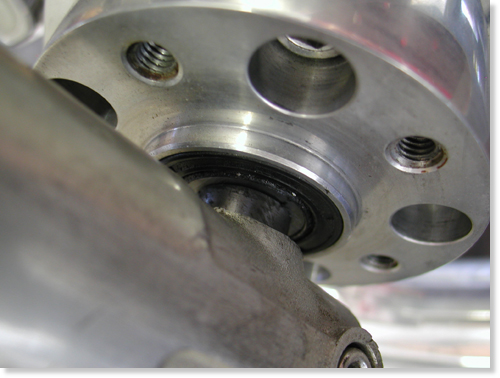
Now we were cleared to install the Hot Match weld-on kickstand.This is a tricky assembly process. First, you need to be absolutelysure you don’t plan to change the front wheel, to a 21, or extend thefront forks. If you do, the kickstand will need to be bent ormodified to fit. It’s not the end of the world, but it will destroythe chrome.
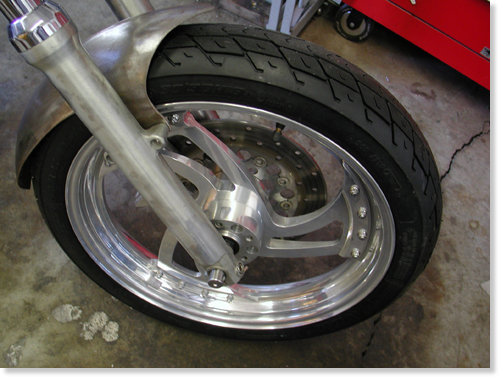
The other trick is determining the right position. Here’swhat my feeble brain told me, since the directions with the Hot Matchdidn’t cover positioning, except to recommend that you take yourtime–no shit. First I stood my Road King straight up and lifted theside stand until it was locked in place. Then I measured from thepoint that would touch the pavement to the ground. It varied fromaround 2.5 inches to 3 inches. I noted that the Hot Match lever wasnearly 3 inches shorter from the point of contact to the center ofthe pivot point. I took that into consideration. I also noted that Ihad lowered my King with shorter shocks, then added a larger Avontyre (a 150). Ground clearance was also a consideration.

Then we picked a placement area on the frame. Our designcalled for little or no forward controls. I kept the tab under theBDL belt drive system and hidden as much as possible, without beingso far back as to create a balance problem. If the weight is forwardof the kickstand, sometimes it can topple the bike. One otherconsideration. When the stand pops up you need to be able to reach itwith a toe, and it better not ride on the belt, or you’re toast. Makesure to check all that, before you burn any rod.
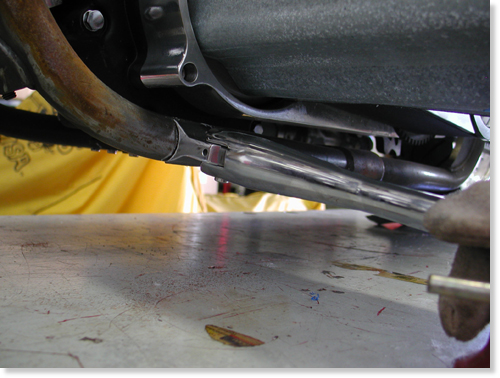
I sprayed the frame rail and the components with asilicone splatter preventative. It obstructs slag from sticking tocomponents. It also made the frame a slipper bitch. I tried settingthe stand end on a socket nearly 3 inches off the deck. Then Iconsidered the differing lengths of the stands and shifted to 2.5inches. Sin Wu was called, from the bedroom, to hold the stand firmlyin place. I marked it, with a grease pencil, then ground the edges ofthe bracket to be welded to the frame. Extra grinding took place toform a snug, metal to metal fit. In order to make all this work weneeded to partially assemble the kickstand without the ball andspring.
The easy-to-read directions called for disassembly, but we left ittogether and used it to hold the bracket in place for tacking. Beforetacking I backed the bike out of the clamp, holding it upright,positioned the bracket in the white grease pencil marks and leanedthe bike carefully until the stand rested on the flat surface. Itlooked cool, so we re-clamped the bike securely, held the stand inplace, protected the belt from hot slag and tacked the sucker withour Millermatic welder. Then we took the stand arm off the bracketand welded it some more. That would hold it securely until we torethe bike down for paint.
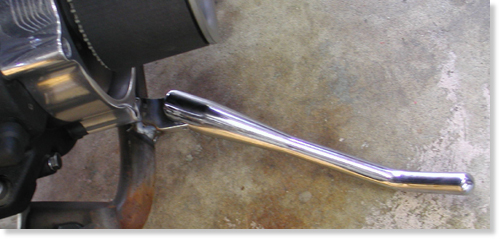
The Hot Match unit from Custom Chrome is a well madeprecision unit delivered show chromed. The instructions includedrecommendations to apply anti-seize to the spring and ball. Theyendorse using Red Loctite on the pivot pin threads. We didn’t becausethe bike would be torn down for paint in the near future. The armneeds to be placed firmly over the bracket and pushed into placebefore the pin will ease into the hole from the bottom. It doesn’thurt to have a spare set of hands and someone holding the bike.There’s also a pivot pin set screw to prevent losing that preciouspivot pin and kick stand arm, on a desert highway, in the middle ofArizona.
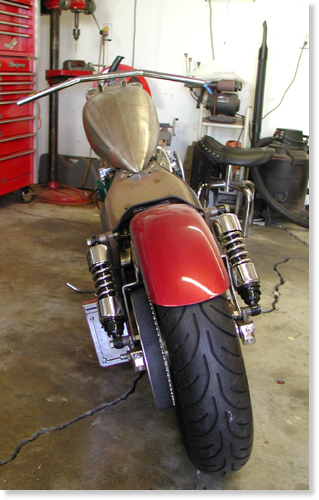
That’s it, except to mention that when we head to thepaint shop, we need to tape off the chrome bracket, so the painterwill paint over the welds but not the chrome tab.

As you can see this bike is damn close to the spray booth.I need to coerce Giggie, from Compu-fire, to ride his FXR out to theBikernet Headquarters with our mid-controls. Once the Joker Machinehandlebar controls are bolted to the modified bars, we’re ready for atrial run, then off to paint. Stay tuned.

–Bandit
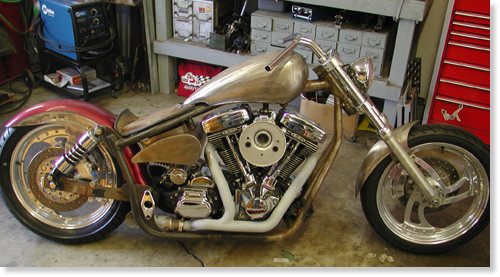

Custom Chrome ® and Chrome Specialties ® have joinedforces to bring you the most comprehensive product offering in theHarley-Davidson ® aftermarket! At over 1,400 pages and over 25,000part numbers, our 2003 Catalog features everything from nuts & boltsto HR3 bike kits, and sets the NEW industry standard.
ONLY $9.95 + 6.95 Shipping**
–Bandit
Back to Part 4…
The Amazing Shrunken FXR Project Part 3
By Robin Technologies |
Bandit and I were checking out the Amazing Shrunken FXR. “Thedamned thing,” referring to the shrunken FXR project we had beenhammering at, off and on, for almost two years, “has attitude,” hegrowled, “a bad-assed attitude.”
“Yeah, but will it have sound attitude?” I mused. “I want it toget attention. I want it to be felt in their chests before they seeit. I want them to hide their children from the evil they fear.”
The Amazing Shrunken FXR has developed into a mythic ethos. Froma cardboard box full of rejected, beat-up, and cast off parts, thebike has become a sculptured icon, a physical dream, and perhaps awrong turn down a bad dirt road, three miles back.The project began back in the spring of 2001. After a lot of fitsand starts, the Buell Project, the Sturgis Run, the Deer Gut stewadventure, Bandit’s painful recovery, the Red Ball prep, variousevents including a trip around the world and soiree’s, we slappedparts on, hammered steel into shape, welded this and that, cussed andfarted and got to where we are with the help of a RevTech driveline,Custom Chrome, BDL belt, Joker controls, Cyril Huze sheet metal andCompu-Fire electrics. The bike is raw boned, trimmed down, and meanlooking. That’s where it stands, inert and waiting for inspiration,up on the rack at the Bikernet garage.

Bandit regarded the raw metal frame with squinty-eyed intensity.”What you thinkin’,” I asked, keeping my own gaze focused on thepotential of the bike. At my question he stretched out his gangly,egret-like frame to its full 6’5″. “It’ll be a loud mother fuckereither way you play it,” he intoned in his gravitas basso-profundodeep voice. “We’ve shortened the frame and rear wheel base so muchthat it’s barely a cunt-hair from the exhaust port to the rear wheel.”
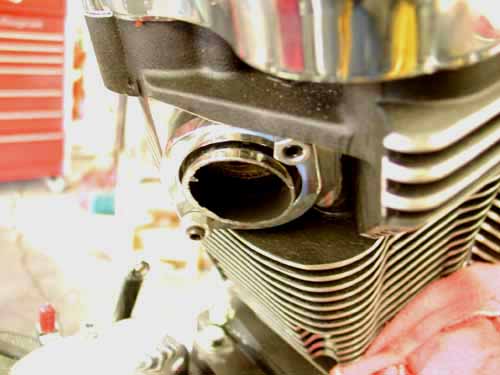
We cut a piece of an Samson Evolution system with a Mikita touse the exhaust port, then started welding other pieces in place. Wecut it back to make a tight turn and create space away from the oiltank.
“Fuck it,” I responded in my best Pancho Sanchezimprovisation, “let’s just start from the port and see what happens.”
We rummaged through a pile of Samson scrap exhaust pipes that wehad scavenged from a dumpster behind the Sampson factory. Flingingout fish tail tips, shot gun systems and swoopy cruiser exhausts,most of them dented and damaged so they couldn’t be re-used. Mr.Samson gave us only the best to modify. We eventually came up withenough pieces to fabricate a Frankenstein exhaust system.

As I grabbed for a section 1 3/4-inch chrome pipe, Imistakenly grabbed a goodly chunk of fur. Bandit’s midget, crazeddemon of a feral cat yeowled in protest and sank his needle-liketeeth into the back of my hand.
“God damn that crazy bastard,” I screamed, “he’s as crazyas a peach orchard boar.” I’m sure Bandit has a mescaline salt-lickfor that freaked out feline.After I extricated my hand from the jaws of Bandit’s feline Cujo, Ireturned to the exhaust system at hand.
Our intent was to minimize the exhaust system as much as possible.We ran the pipe straight down from the front exhaust port, thenturned it to hug the bottom of the engine case. We had originallyhoped to put a flattened pipe under the frame, but reasonable roadclearance dictated a different path. So we tucked it in and aroundthe engine case, then inside the frame, coming out just at the edgeof the back wheel.
“Our first mistake,” Bandit spouted, “we needed a smallerdiameter chunk of exhaust to form guides when welding chunks ofexhaust together. If we had slipped it in one piece even a quarter ofan inch. it would have held each chunk in alignment. That’s onetheory to building pipes. The key to fabing your own pipes is havingenough scrap to slice and dice, then cutting and working each pieceuntil it’s as close to a perfect fit as possible. Finally the tackingprocess is critical. That’s were the guides didn’t come in. If we hadguides we wouldn’t have offset pipes tacked into place. That problememerged severely a week later during the grinding process.”
“It took two days of playing, cutting, fitting and welding toform a completely custom exhaust system in place,” Bandit added.”Make sure you wet towels and form a fire barrior around your tackingarea to protect the rest of the bike. I used a small 0-sized torchtip and common hanger to tack the segments of pipes together. I’m notconfident enough with our new MIG welder with thin sheet metal, so Istuck with the torch.”

” It wasn’t perfect, but it was ours,” Bandit added, “acompletely unique system that would be tucked under the transmissionand attached to the driveline solidly under the tranny backing place.Then we faced the muffler aspect. The pipes were too short to be openor we would have been arrested within a block of the headquarters.”
Needing some kind of ‘standardized’ muffler elements, we went toour local San Pedro Kragen Auto Parts store. With the clamp-on piecein hand, we found parts and pieces enough to create a 7″ mufflercase. “Most of the elements were too heavy and glass packed,” Banditspouted, “We couldn’t weld on a glass pack.”
Back at the garage, with torch in hand, Bandit cut out a sectionof baffles from some scrap Sampson muffler. Spot welding the bafflesinto our jury-rigged muffler, we produced something that may, likeJapanese Fart Wax, diminish the painful ‘Brap-rap-rap’ flutter ofunrestrained exhaust back pressure. A right-angle turn-out willdirect the dragon’s breath exhaust from the screaming 88cc Rev Tech,high-performance engine to an unsuspecting public standingslack-jawed and terrified at the curbed edge of civilization, theirhair-dos blasted straight by the sizzling after-burner of the AmazingShrunken FXR.
“He gets sorta twisted,” Bandit muttered shaking his head.”Actually with the baffle in hand we went to San Pedro Muffler Shopand looked at the myriad of tips and tubing alterations we couldmake. We found a tip and had a chunk of 1 7/8 tubing spread to matchthe tip. That formed the other end of the muffler. We just had toweld the three elements together.”
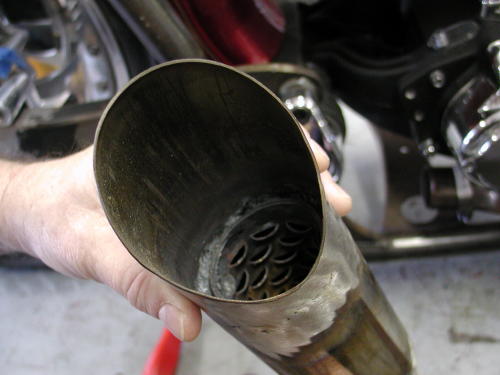
I welded the baffle in place, positioned as it was in theSamson System. I discovered that the two elements didn’t want to weldtogether. I have a feeling the tip was made of an inferior metal.
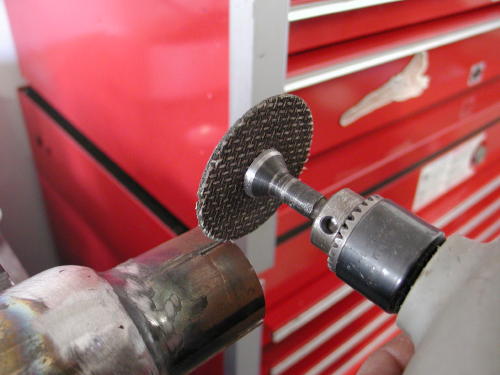
With the die grinder we cut notches for the muffler clamp.
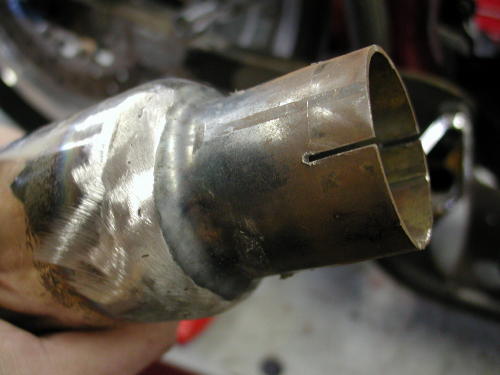
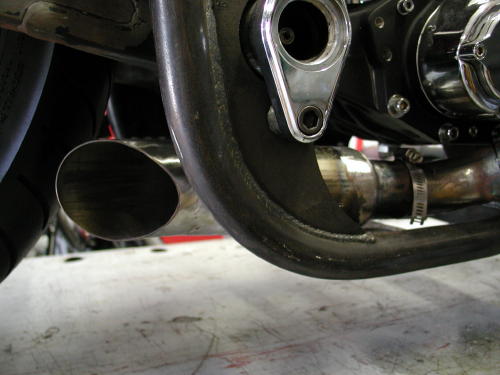
“After welding and fitting I stood back and was proud of ouruniquely tight system that would allow Giggie, from Compu-Fire, tomachine mid-controls for a final touch,” Bandit interupted. Theexhaust played perfectly into the Shrunken aspects of the project. Iremoved the tacked system and began hours of gas welding to make itwhole. That’s when all hell broke loose. While working on anotheraspect of the bike with my back turned to my partner, he began togrind the welds. The college art history professor sought perfectionwith each weld and ground right through the thin walls of the18-guage exhaust pipes. It was amazing. I was sure the system wasruined.”
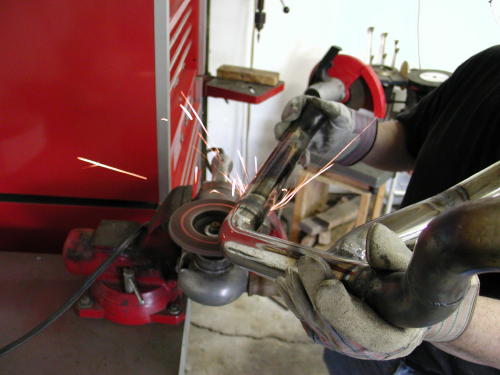
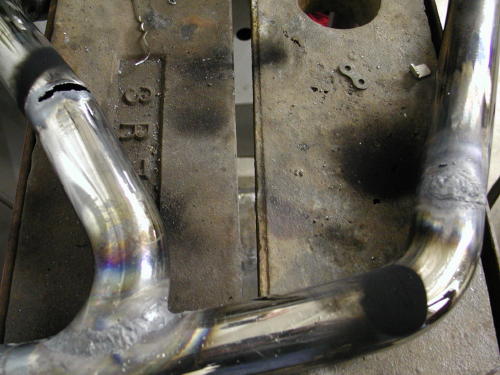
This shows the amount of area ground down so far we were forcedto fill it or destroy the system and start over.
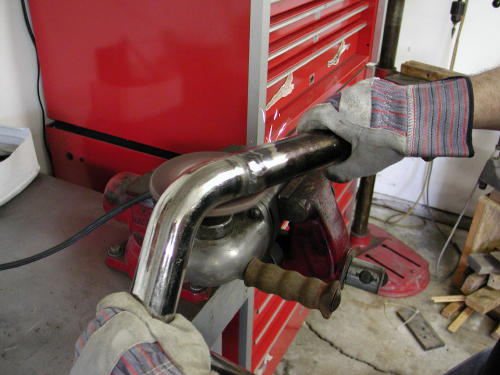
“Some builders tack systems together then take them tomuffler shops for professional construction. I thought that was mynext move. Unfortunately a regular muffler shop doesn’t have themandrels to make the tight bends we had proposed. I was devastated,but the man told me that he could fill the welds with his MIG welder.
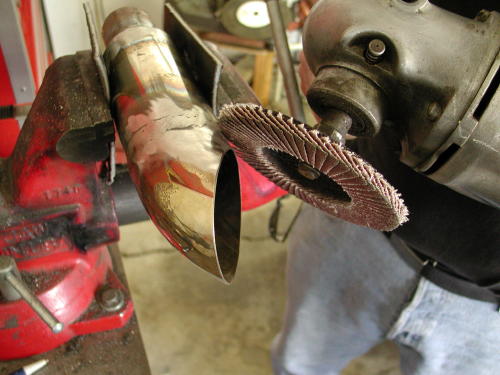
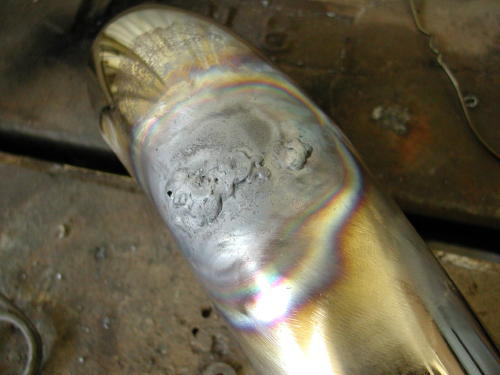
More welds to fill the mad grinder’s cutting work.
“Unfortunately each weld was now a 1/2 inch tall and wide zit atalmost each junction of the pipe. Nuttboy began the grinding processagain. More holes were found and I filled them with gas welding usinghanger rods. I joke now that if the bike runs like shit we blame iton the exhaust system. If it runs well, it’s the same roll of thedice. We’ll see.”
“Making your own exhaust system can be a blast, just don’tget heavey handed with the grinders. Pipe is thin and a little weldthat shows won’t matter much since we didn’t plan on chrome, butblack Jet Hot coating. I’ve sworn off chrome exhaust systems on mybikes for the future.”
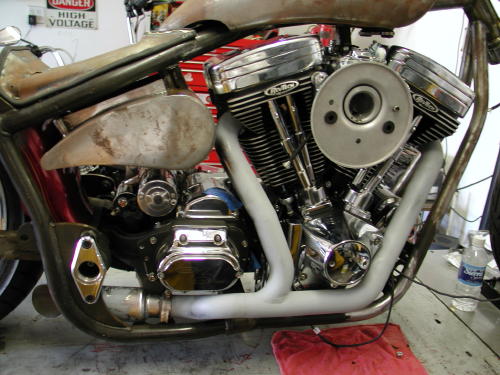
That big bastard just won’t shut up. The next episode in thismechanical adventure will feature Giggy’s attempt a electrifying thesteel monster. Next weekend, barring any new bike projects, Giggy’sinopportune finger damage at the power tools, splattered deer guts,San Pedro political insurrection, Sin Wu’s beguiling charms, a caseof beer, or any other form of diversion or chaos, we will be closerto cranking this monster over.
To Continue……..
Back to Part 2……..
Back to Custom Chrome on Bikernet……..
Back to Joker Machine on Bikernet……..
Sturgis 2000 – Part 1 Whiskey, Women and the Open Road (Continued 2)
By Robin Technologies |
|
Continued from page 2…… With a couple weeks left, I called Joker Machine daily. I didn’t want to press, but I was going out of my mind. My contact, Geoff, had faced some health problems and decided that smoking was his cure. I didn’t want to add to the stress of building high-precision, very costly components that were already on back order. I considered myself a nuisance so I was trying to tread lightly. The staff at Joker was more than helpful and I finally got the call from Geoff. “Come on out and we can bolt on the parts right here. I’ve even found a guy around the corner at Greased Lightening who will make up the brake lines. We finally got the stuff back from chrome, but as usual, all the elements aren’t perfect. You’ll have to roll with one polished piece. The others were sent back to be rechromed.”
I respected his desire for perfection and that he had paying customers breathing down his neck, so I was perfectly happy to take whatever he had. Jay from Station 34 in San Pedro, a cool restoration shop built in an old gas station down the street, volunteered to haul me out to Azusa to the Joker Machine facility. Jay from Japan works with the Japanese Easyriders Magazine and wheels and deals with bikes back and forth to Japan. He was also building a rigid to ride to Japan until I helped him make a contact with the Harley-Davidson fleet center and he was able to borrow a Road Glide. The cheater. Anyway, we loaded the Blue Flame into the back of Jay’s ’79 ranchero and hauled it out to Joker, where we installed the forward controls. Then we rolled a couple blocks to Greased Lightening where the owner, Mike Ingle, custom made the hydraulic brake lines for the front and rear brakes. We bled and tested them and loaded the bike for the return trip to Pedro and the first start up. Mike’s shop is small, but his engine building facility is well equipped. He’s experienced and ready now to take on building engines for a larger clientele. He told us that when bleeding brakes, smearing a tad of grease on the threads of the bleeder nipple prevents air bubbles from creeping around the threads and results in a more positive bleed. An hour later, we pulled up in front of the hot rod body and paint joint around the corner from the headquarters. Henry the proprietor and Bob, the owner of one of Henry’s creations, came scrambling out of the corrugated steel building to check the metallic blue monster sticking way out of the back of the baby blue Ranchero. Using Henry’s driveway for an assist to Jay’s ramp, we unloaded the bike easily and fired it to life for the first time. In the back of my mind I planned to use Eddie Trotta’s break-in scenario where he rides the bike for one mile then tweaks, the next day he rides it for 10 miles and tweaks some more, then 50 miles, and so on. I liked the notion and the bike rumbled easily but idled too high. I rode it around the block and discovered a number of tweaks that needed to be addressed immediately. The formula was working. We pulled the bike into the garage as the dark-haired beauty arrived. We celebrated the occasion with more than just a drink. The night was gone in a blur of sex, sweetness and excitement at bringing the beast to life.
I’ve been building bikes for 30 years and the exhilaration of a metallic accomplishment that can carry you across the country is still the same. It’s something like sex and winning the lottery. Although nothing compares to sex, like, well … more sex. We’ll leave that for another discussion. I had less than 10 days left when I took the bike for its 10-mile excursion. It ran fine, but the tightness of the belt was bothersome. Something was rubbing on the final belt. The rear wheel spacing was slack and there was still no speedometer. The rear fender was finding its home and the bolts needed to be tightened. The new front brake line needed to be secured and we discovered some industrial wire cable ties with rubber inserts that would do the trick. We removed the inserts and polished the aluminum, and we had a couple of custom hydraulic hose guides. I mounted one to the Weerd Bros. lower triple tree by drilling and tapping a small hole, but I made sure to go in about an inch so I had plenty of thread depth. I also made sure I had enough fasteners to have them match if and when I ran the speedometer drive. I had 10 days to put 500 miles on the bike and dial it in for the 2000-mile jaunt across the desert to the Black Hills. With another round of tweaking under my belt, I rode the bike down the coast for breakfast an put another 50 miles on it. I pulled into a gas station to refill and couldn’t get the gas cap off the Sportster tank. It was a carefully manufactured super clean custom cap that fit right down on the surface of the tank. Damn it looked clean, but the gripping edge of the cap was less than an 1/8-inch thick and a hair off the surface of the new paint. With little surface to grip, it wouldn’t budge. I stood in the station perplexed. I knew I would run out of fuel before I returned to headquarters. Unlike most of the stations in L.A., this one actually had a technician, and a wrench who spoke English. On top of that, the man was generous with his tools, another rarity. I borrowed his largest pair of channel-locks and a rag that I draped over the cap and the top of the tank. The cap came loose. Another item to be tweaked. When the weekend came for the calendar show, the bike had a couple hundred miles on it and I had less than a week until departure. There was still no speedometer but the bike was running fine. I had yet to respace the rear wheel, but two women wanted my company at the show and how could I possibly resist? The sun was ablaze as the girls followed me into the check-in area where I planned to display the bike with Joker Machine’s fine rides and then at the Mikuni booth, which sat alone on the edge of the water without any bikes or babes around it to draw the crowds to their product. I ran into a girl who I had once come very close to dating on a regular basis, Lexy, a blond bomb shell with tiny feet and a skirt that could have been made out of one of my Hawaiian shirt sleeves. She dripped with sexiness as I greeted her. The dark-haired beauty at my side stared at the youngster in the stretched-on skirt and her emerald eyes glistened with some mysterious feminine emotion. Sweat beaded on my forehead and the sun hadn’t even crested the horizon yet. The show was flawless and I escaped early to log on more miles and spend some quality time with the lovelies who chaperoned me through the bikinis and chrome. I continued to ride whenever I could while making arrangements for the trip. A noise nagged me and I suspected the BDL system, which is the easiest thing in the world to install if you watch the spacing and the initial alignment. If I ever install one again, I’ll know just how to go after it, and the thing will be a breeze. I also noted some aluminum shavings in the clutch basket. I kept riding, adjusting and tightening the Joker Machine mirror, which was very flexible and sturdy. The Joker controls worked perfectly and I found a couple CCI frame clamps to hold the clutch cable in proper alignment. Two days before departure I pulled the rear wheel for balancing and fixing the spacing. This time a neighbor had loaned me a flat belt and disc sander and I immediately took too much off the spacer and had to take it to the local shop for shims. The next morning I was at Century Motors first thing. When I asked about shims, the mechanic looked at me with disgruntled eyes, stroked his long beard and said, “I’ll check the washer drawer.” I jumped in the flamed Bikernet T-bird and hauled over to California H-D for an assortment of shims, which I quickly took back to Century Motors. With the proper alignment and the wheel carefully balanced, I returned to the garage for installation. Then I decided the noise was coming from the clutch and began to dismantle it. I couldn’t seem to knock the clutch nut loose and more loose ends began to appear. It was Wednesday, with a day left before a crack-of-dawn departure on Friday, but the signs were pointing at a postponement until Saturday morning. Thursday morning I had lists in my pockets and notes on the Panhead Desk. The spare bedroom was becoming the packing department with my bedroll, my HA leather vest, a Prison Blues denim jacket from Chrome Specialties, my ditty bag, extra sunglasses and shirts. The bedroll was rapidly being buried under shit I threw on the bed every time I wandered down the hallowed Bikernet hall.
With each new creak of the feeble hardwood floor, I thought of something else. Sun Block, bungee cords and the battery charger for the cell phone. Just before noon, as I was writing news for the Web site, the UPS man showed up with a small square box. It contained the Custom Chrome Speedometer. I stopped to sign for the package, confirmed what it was, then headed to the garage. The Blue Flame stood majestically in the dim light as I studied its sleek form. She was beautiful and gave off a sense of alertness and anxiousness to hit the road. I wanted to load up and cut a dusty trail that minute, but I had lists to check off, calls to make, the news to finish. I was waiting for Bikernet patches to arrive. The UPS man had already left. If I waited one more day, perhaps? I looked at the speedo and set it on the bench. I went back to the glass Panhead and kept hammering on the news, although my heart was heading for the door.
|
Road King 4/18/03
By Robin Technologies |

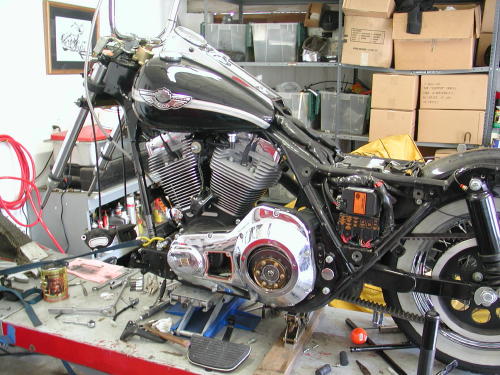
The King stripped for powder coating.
The plan was to strip the bike of all the brackets, tabs and accessories we could get our hands on and have them black powder coated by Custom Powder Coating in Dallas a Bikernet Sponsor.
We ordered additional accessories to enhance the clean black effect. First we ordered the Harley-Davidson black mag wheels and floating rotors with black centers. We pondered the front fender and trying to black out all the trim. During research we discovered, in the Winter P&A catalog, brackets to allow a Fatboy fender to be bolted in the King front end. The Fatboy fender is a cleaner unit, but it still has rivets and ribs. We opted for a solid black Street Stalker fender that’s clean as a whistle and light as a feather.
We also decided to switch the rear turnsignals out for the new Screamin’ Eagle teardrops and the narrower light bar. When they arrived we had to tear the lights down. We cut the two plug wires in a staggered fashion. The light bulb was then removed and we used a coat hanger tool to hook the plastic base and pull it out of the shell. Lastly we ordered the Harley-Davidson fender, license plate mount.
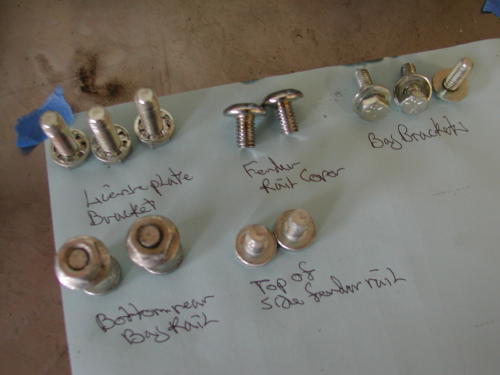
The first thing we did was to clear off our bench and tape down a couple of large sheets of paper. We organized every nut and bolt, screw and spring.
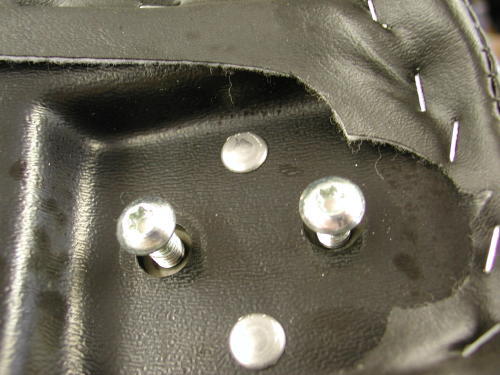
I ordered the billet seat tab from the catalog in the Multi-fit area. When I ordered a slim seat it didn’t come with a tab so I had to move the tab each time I switched seats. I powder coated both for more simple assembly in the future.
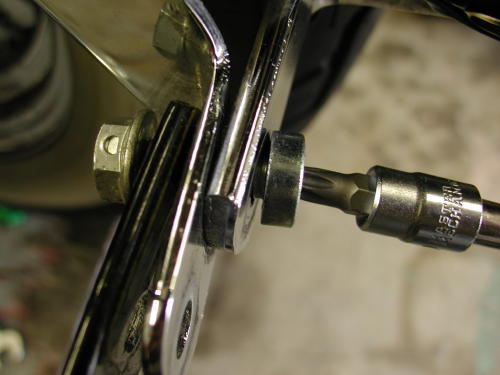
Nuttboy and I started the process removing the bags. I began the process of removing all the bag brackets and roll bars. Each time we removed a fastener we set it on the sheet of paper and wrote a description.
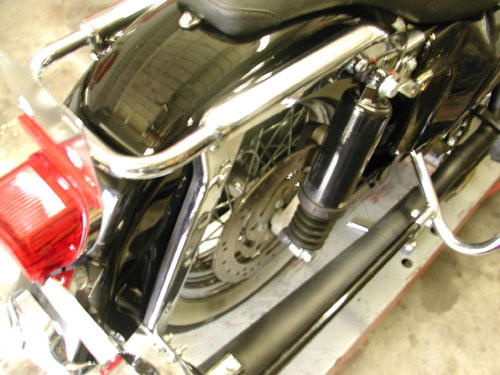

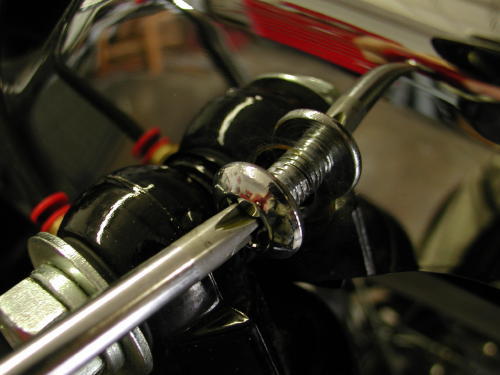
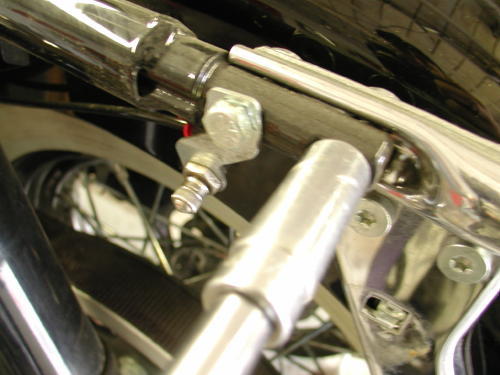
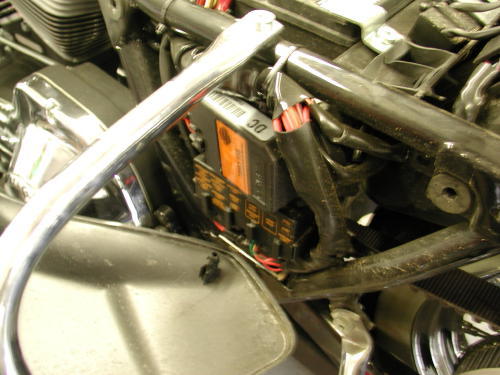
We had to pop the plastic side panel loose and take the seat off to get at the roll bar fasteners.
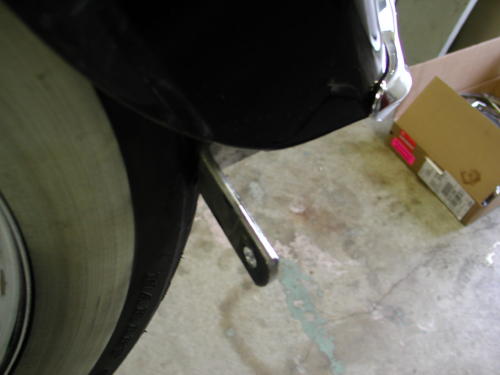
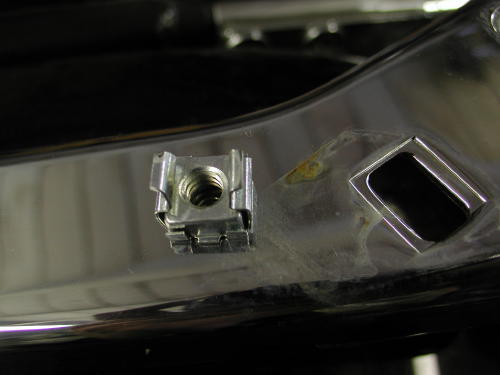
This shows one of the bag bracket fasteners that are inserted into the bag rails. I thought about pulling them for fear that the heat from the powder coating process would weaken the spring tension. We tested the theory by leaving some in place. We didn’t have a problem, either way.
On the left side I had to remove the passenger footboard to take the derby cover off. With each note on the sheet of paper we listed the number of fasteners for each application. The more information the better. I had to remove the seat and the King side panels to take the bag roll bars off. Many of these items were held on with Torx bolts. It’s a good notion to buy a set.
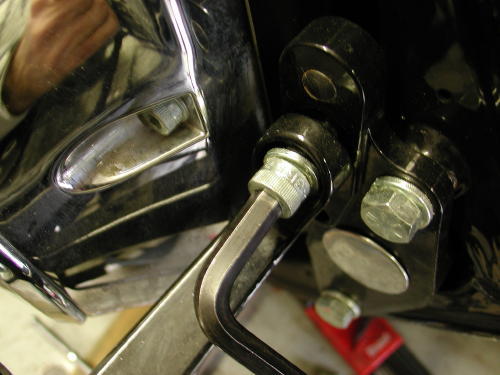
This footboard had to go to reach the derby fastener.
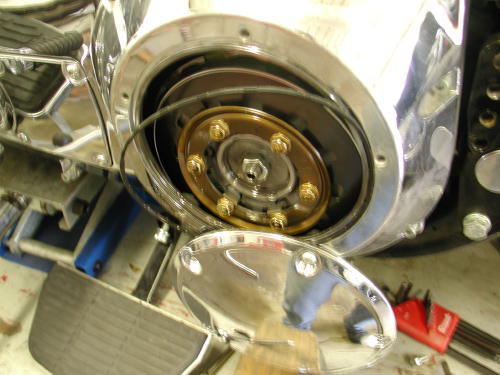
I started to remove the shift levers and discovered that I had to remove the footboard to reach the inspection cover Torx fasteners. I wasn’t sure if the footboards would have black in their future. At first I reviewed the area of the black board that would show, just the rim. Then we turned the board over and studied the way the rubber suspended pads were installed. We discovered that the pads are removed easily with a punch to the edges of the bottom protruding rubber lips. The boards went into the box for powder.
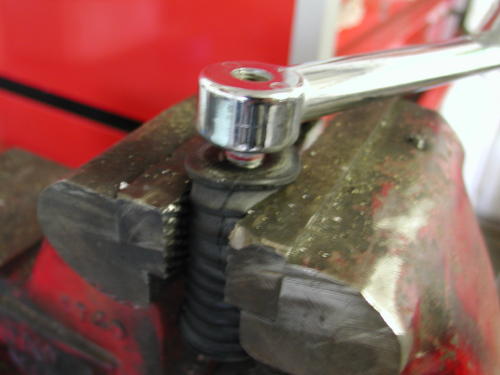
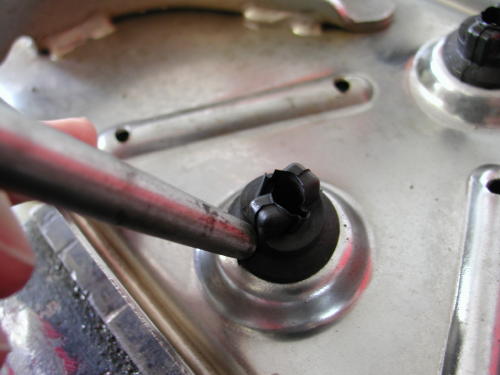
This was a simple process to tapping the edges of the rubber with a large tap and rubber hammer. We tried driving them out with the tap first, through the center. That didn’t work.
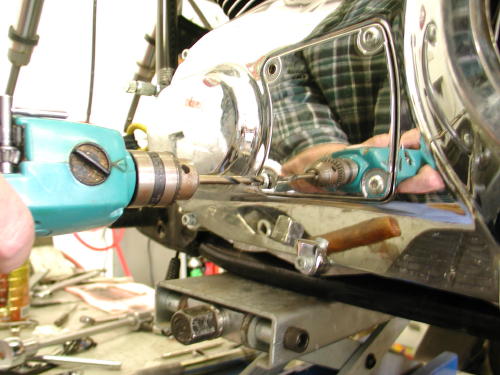
The mechanic’s law calls for one screw or fastener to seize every time. We had to drill out one of the inspection cover screws.
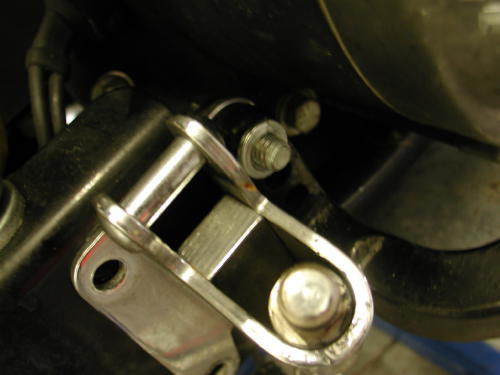
I tried to take off the kickstand the old fashioned way by removing the tooth then pivoting the arm forward. The spring wouldn’t come loose. I had to remove all the fasteners.
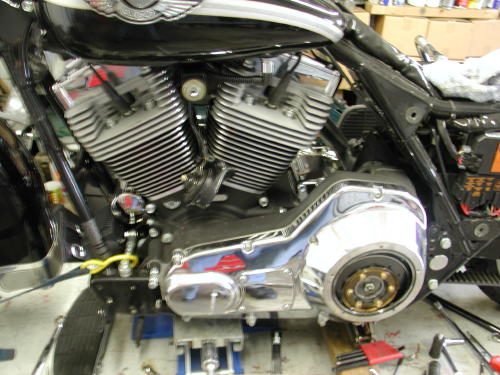
Metric fasteners haunted me from time to time, including the red Loctite touched horn fasteners which were #10 metric sockets. The Showa front end was covered with metric 12 point fasteners. It forced us to hit a commercial tool shop for 12-point metric sockets.
As the last of the fender rail parts came off we marked the loop that carried the license plate. We planned to replace the license plate holder with a fender-mounted job that attached below the taillight. We cut off the existing license plate loop, then I brazed washers and nuts so we could screw small orange reflectors in place.
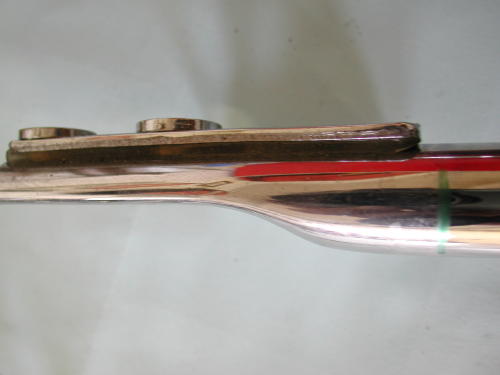
We marked the old license plate rail with a felt pen so the cut would fall just under the fender rail cover.
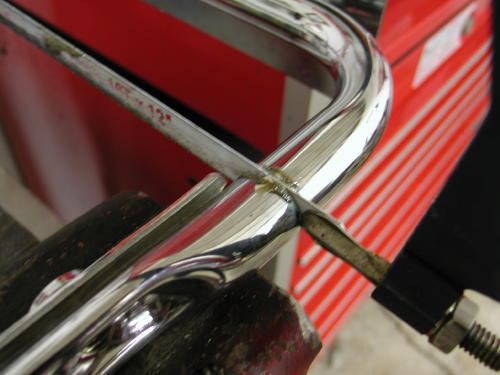

We didn’t use these reflectors. We were looking for Harley orange reflectors with steel backs.
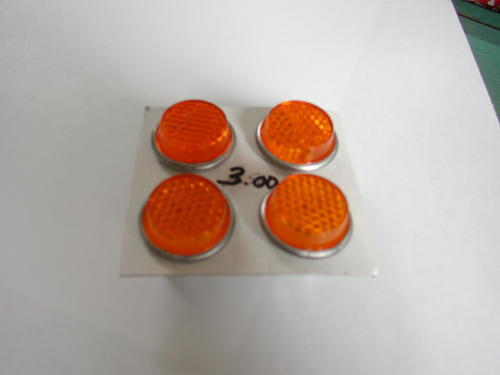
After a swapmeet run we had the right stuff for the job.
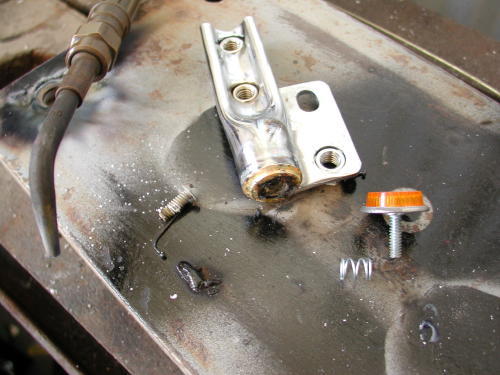
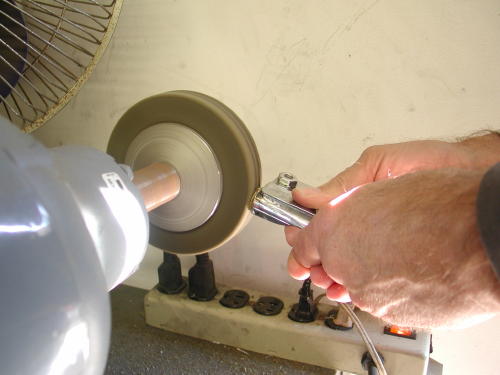
Sin Wu wandered into the garage just as I turned off the torch. She shuts down productive activity wherever she goes. She had a couple of alloy knitting needles that she offered us. I discovered in short order that the long alloy knitting needle worked perfectly for removing the hard-to-reach cotter key behind the brake pedal.
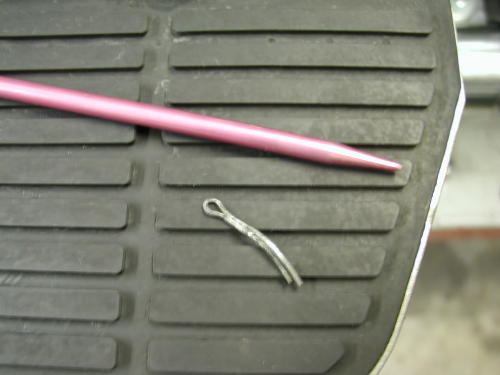
I had the toughest time retracting the clevis pin from of the pedal that hinged on the master cylinder piston. Finally it was removed with a punch from under the frame. The brake pedal caused me so much pain it didn’t make it into the powdercoating box. We painted it with a rattle can after prepping.

Continued On Page 2
Sturgis 2000 – Whiskey, Women and the Open Road on the Blue Flame
By Robin Technologies |
|
 Unlike many years in the past, I didn’t rely on any builders to make the deadline for the trek to the Bad Lands. The Bikernet crew handled building two road-sizzling chops in two and a half months. I’ve got to tell you that it felt good to get back in the garage amongst the socket sets, grinders and torches. Although the drunken work ethic was strong, several times during late-night wrench fests I came mighty close to firing myself. However, since I was one of a very small crew of volunteer wrench merchants, it didn’t make solid sense. Nutboy was there until he couldn’t handle the clogged pressure cooker in the garage, so he grabbed 30 college coeds and flew to Ireland. Never did get the meaning of all that, but it sounded like good fun. Agent Zebra flew in from Miami to pitch his movie 1%er for the 43rd time and came by the Bikernet headquarters to assist with his bike. I quickly discovered that the bull riding champion/survivalist can’t turn a doorknob, never mind a wrench. Renegade lost his patience and we kicked him out of the garage and told him to return to Hollywood and, “Don’t come back without a contract.” Wrench was constantly on hand, Snake was constantly drunk and Oz could never get away from his computer monitor long enough to help, but he was a constant source of phone-advice.
Renegade came to the garage daily to criticize everything from finish choices to components. That bastard would make a kid cry about going to Disneyland. He hasn’t had a good word to say since I met him in 1972, but he’s my brother. Whatta ya gonna do? Our challenge was to build two bikes and ride to Sturgis for the first Sturgis Bikernet Chop-Off, a bike-building competition between Bikernet East and Bikernet West. Great plans don’t always pan out, yet become blessings in disguise. We finally turned one world-class custom, which was not the road bike we needed, into two distinctly different asphalt gobblers. Were we up for the task? Did we have the skills and tools to build the bikes? Would they run once they were completed? Had I lost my eye for solid choppers or my mechanical touch? Keep in mind as this saga unfolds that this (Bikernet) is a start-up business, competition and life change. I’ve been helping people get their businesses, projects and products off the launching pad for almost 30 years. Now, faced with no paycheck and no expense account we attempted to build two bikes from the ground up just months before Sturgis 2000. In addition, we would be judged on who had the coolest chop and whipped the other son of a bitch from its designated homeland, namely Miami and San Pedro in Los Angeles, to South Dakota. With the Bandit II dismantled, we stood back and evaluated the situation. We had another set of wheels hanging around in the garage and miscellaneous other parts. Agent Zebra is a short, wiry asshole, so the Paughco frame went to him, along with a set of H-D custom wheels and rotors. We split the P.M. brakes between the two bikes. We checked our leaking bank accounts and began ordering parts. Since the frame for my ride had to be ordered from Daytec, we started on the Agent’s bike first. The original Bandit II narrow glide went back on the stretched Paughco Softail along with P.M. brakes and Harley Thunderstar wheels and rotors. The 88-inch CCI engine slipped into place along with the Baker five-speed transmission. As the days rolled along, we plucked more parts from my pile just to keep the starving Agent’s project rolling. The frame was still painted with the Bandit II theme, along with the tank, so we stuck with it. A Fatboy rear fender was fitted over the 160 Avon Tyre and sent to Phil Stadden for paint along with the West Coast Choppers front fender. The completeness of the 88-inch Rev Tech engines made the project much smoother. The Baker Transmission was a jewel to deal with and improved the ride immensely. With a few odds and ends from the extensive, “if you need it – they have it,” Custom Chrome catalog, the Zebra special was coming together. We had a minor clearance problem with the frame and engine. Fitting the 160 tire under the fender was tight and making the brakes work was a bit of a challenge. In no time, the bike was running and on a custom-painted Gold Rush Semi heading to Miami for the Agent. We shipped it to Eddie Trotta at Thunder Designs in Fort Lauderdale for break-in, a seat from the infamous Keith and tweaking.
Of course the Agent couldn’t leave well enough alone and he decided to have special panels painted on the sides of the tank and fender announcing his arrival. The paint work was handled by Eddie Meeks in record time, but it still sliced away at Zebra’s time for break-in. The crew at Thunder Cycle, with less than a week before kick-off, pulled burn-outs up and down the tourist-packed streets of Fort Lauderdale in an effort to spin the miles onto his new odometer. All right, you’re beginning to get the picture, but there are more obstacles to come. The young muscular Zebra had this Germanic girlfriend. She was tall and thin, with super-model looks, natural blond hair and blue eyes like you only see in Scandinavia. She had a whisper of a voice and could speak very little English. Unbeknownst to the Agent, he was in love. He bought her furniture, a car, took care of her expenses, etc. while he was working. Suddenly his Los Angeles highlife went into the shitter and he was forced to move quickly to Miami and set up a crack house in the middle of Cuban controlled South Beach. The competition didn’t take to the blond boy from Kansas, and they dropped a pill in lovely Nicole’s soup. She immediately fell out of love with Zebra and the world stopped. Not only did he lose his girl, but his access to a car and all the furniture in his pad. His massive, attack-trained Malinwa dog, Apache, went homeless on the streets of Miami while Zebra panhandled for coins along the route to the Badlands. On the other hand, my life was a circus of broken promises. Calling in a favor, I contacted Milwaukee Iron for fenders. I had helped Randy build his business from the beginning, yet when the fenders arrived, the UPS dude stood there with a unexpected C.O.D. request, and there I was, in the middle of a financial no man’s land. That scenario happened more than once. We even had a Bikernet sponsor sign our contract then go back on their signature. But “give up” is not written in the Bikernet mantra, so we rolled up our sleeves and kept wrenching. For every time I felt screwed, there was a bright star, a blessing in disguise, a pearl in our soup. The Weerd Bros. from Phoenix not only were helpful beyond our wildest dreams, but their product turned out to be a superb ride and a life saver. Harold Pontarelli, owner of H-D Performance, called me one day about a year and a half ago, while I was still at Easyriders, and said that for running some of his bikes in the mag and for being a friend, he wanted to comp me a paint job. I thanked him profusely, but never expected to take him up on the offer because I knew my days at the page factory were numbered. A couple of months after I left, Harold called me to say his promise was good whether I ever did a thing for him again or not. I was blissfully floored. Custom Cycle Engineering, which you can see featured on the site in our Panhead project section, has always been a good friend. I run their rubbermounted dogbone risers on all my bikes.
Finally, Ron at Paughco never hesitates to assist in any way he can. So for every screwing, there was a blessing. Finally, a company I had never had a chance to work with came to my rescue in the final hour. It’s odd that some of the companies I had assisted for years couldn’t step up. Yet the folks at Joker Machine, whom I hadn’t worked with, went out of their way to assist. Geoff and Diane were there when I needed them and I will be forever grateful. Their machine shop is impeccable, the product precise and well thought through, and examples showed up on the road to Sturgis from time to time. They take particular care with polish and chrome. Being flexible is a necessary evil to building a custom. When the bell tolled and the slick-as-a-perfectly-curved-tit Daytec frame arrived, we had five weeks to build the Blue Flame from the ground up. The custom Daytec rigid was ideal for the 14-over Weerd Bros. front end. Tony Day said of the specifications, “An Eddie Trotta formula frame.” Eddie from Thunder Designs in Fort Lauderdale builds a hard-riding stretched Softail chopper that makes riding like first-time sex. The question at that point was whether to send the frame with the sheet metal to Harold in Vacaville, Calif., or to powdercoat in three days and have the chassis building underway while the sheet metal was under the spray gun. Powder has its color limitations. It’s tremendously durable and strong, but comes in few colors. We found a company in Orange County, Primo Powder Coating (Huntington Beach, that has an unheard-of two-stage powder, so I was relieved not to build another fucking black bike. I love black scoots, but I’ve built one too many, including the Excelsior-Henderson last year and the ’97 Street Stalker from the prior year. It was time for a change. While waiting for the welds to cool, we debated whether to powder coat. While wondering, we narrowed a ’50s cop-bike solo seat one inch and Nuutboy fabricated a steel frame and pivot point. A bracket on the frame was modified to allow the seat to glide up and down with rear spring action. Two studs were welded in the center of the frame rails to correspond with the studs on the underside of the seat, but what about springs? The old Bates springs were never strong enough to carry the weight of a man. I had to find a set of 4-inch tapered coil springs that would handle my ass to the Bad Lands. It was June and the sun was as hot as my love life. Something sparked and a dark-haired bundle of intrigue entered my lonely existence in the middle of a bar fight. Although the pressure was on, she remained a soft-spoken Valium in tight pants. She was like finding a jewel in a trash bag full of crushed beer cans. Initially I was concerned, curious and watchful as she roamed in and out of my days, bringing coffee cake in the morning and sex at night. Her schedule fit well with work on the Web site, books and bikes. She showed up on my doorstep at 10 p.m. and slipped out at midnight. She had an 11-year-old daughter whose school was up the street from the Bikernet headquarters. She’d swing by in the morning on her way to work with packs of oatmeal and creamers, stay a few minutes and disappear out the door. She didn’t ask questions, didn’t seem bothered by anything and loved sex — my kind of woman. But I was focused on the goal to build the bikes and driven to ride to Sturgis.
I was about to reach for the phone book one morning, on an ass-saving spring hunt, when the mail arrived with an invitation to the Harley-Davidson new-model announcement. At that point I was spending every extra moment in the garage and interruptions were a problem. But the factory has always been supportive and I couldn’t miss the new bike review so I signed on for the event. It took place in Pasadena and all the moto-journalists from the Southern California region were on hand. Occasionally during the presentation I would peer at the list in my pocket and go to the dingy corner where the heads were to make a call about chrome or parts, or I’d call headquarters to check in with the crew. Some years the Harley announcements indicate business as usual at the factory with only minor changes. This year was a vast contrast to the status quo. It was immediately evident the company was making strides to capture a larger segment of the aftermarket with its accessory production pace and the focus on custom parts. The models radiated custom touches. They had finally truly lowered a bike, the new Lowrider Dyna. Road Glides were getting much more engineering attention. Performance was advancing quickly with a Holley Carb introduction and big-inch motor kits. Some of the new paint schemes reached deeply into the custom culture for colors and designs.
Then they came to the new narrower, lighter, police model for 2001. Cop bikes didn’t mean a hill of beans to me, but I scanned the more agile machine that is now available for individual sales and they’re cheap. Dan Ackroyd should get a new one. I noticed springs under the solo cop saddle and immediately jumped to my feet. Two representatives from the factory rushed to my side. “Can we help you answer any questions about the new police model?” one of the engineers asked. I started babbling about this stretched rigid I was going to ride to Sturgis and the two contemporary thinkers backed away as if my radical concept might rub off on them. I ordered a set later that day. They proved to be … well you’ll see. The frame was sent to the powdercoater, the chrome went out and the sheet metal was shipped to Harold’s. The waiting game began while I chased any missing parts. By the time the sun was blazing in the single window of our tiny headquarters, the frame was back in the garage and up on a towel-covered lift. The chromer made me wait another day. I was in the midst of a bolting-together orgy when the dark-haired one appeared in the doorway of the Bikernet den, peeling out of her threads.
Her alabaster skin looked like cream flowing into a hot cup of coffee. The satin shaved surface was too delicate to touch. What the hell is a biker to do when heaven is standing nude in the doorway? The crew was looking at 34 days until departure. I was looking at green eyes, a sensitive smile and … priorities men, priorities. It was a factor of hours and parts availability, plus watching for problems. Everything was seriously locktite drenched, tightened and tightened again. I notice a weak link immediately in the wheel spacing. This was an odd, uncalled-for operation. You buy wheels, they come with spacers. You install them and it’s a done deal. You go for a ride. So what was the problem? The tubes had been cut and collars added to assist with holding the grease near the bearings, and to hold the spacer centered when the axle was removed. They weren’t shabby. The dilemma made me second-guess my installation. I checked and rechecked the life-threatening problem. If I left them alone, I would certainly be a candidate for a high-speed wobble. If I set them up too tight, I could burn up the bearings in the desert and be left alongside the road to fry in the sun. Something had to be done to correct the wheels or find out where I went astray. With spacers the correct length, the wheels and brakes could be installed for the last time and anything that could reach final assembly made me smile and saved time. We were frustrated. I centered the wheel and began to space the P.M. Calipers. Something wasn’t right. There was .020 slop in the center spacer that pre-loads the Timken bearings. I was blown away and stayed up until 2 a.m. with a sheet of glass and wet and dry sand paper trimming the spacer down while insuring the flat parallel surface to the bearing race as left intact. I finished uncertain of the tolerances. Later I found that the tolerance prescribed by the factory is .004 to .014. It is recommended that with aluminum hubs you should lead your figure to the .004 side. There was another weak link and Harold mentioned it as soon as he received the mounted Sportster Tank. “That tab system is a little shaky, Bandit.” What could I do? I had two 1/8-inch-thick straps that ran the entire length of the tank and out both ends by three inches. At the last minute I eliminated one because I felt it would be too difficult to bondo. The tank was now in Harold’s hands and time was running out. If I had sent the bare frame to Harold, he would have mounted the gas tank by his proven method. The decision had been made and I would be forced to live with it. We kept moving. Ah, but there was another adjustment that lurked in the back of my mind, although Giggie from Compu-fire checked my installation and gave it a thumbs up. I was sketchy about the primary drive adjustment. I had slipped the original inner-primary O-ring between the engine cases and the motor plate for vibration relief. Bad move. The BDL belt was too tight.
There was no slack in the belt and I wanted some. I had to loosen the transmission, unbolt the motor-plate from the engine and move the tranny forward as much as possible. It worked out perfectly, but just in case, I ordered a spare belt (I broke a primary belt in ’97 outside Denver). Giggie from Compu-fire helped kick off the wiring with the installation and timing of the Compu-fire single fire ignition. With it in place sans the Voes switch (this is a chopper, right?). About that time, a tall Asian in a flowered bikini and a black towel strolled past the headquarters on her way to secluded Cabrillo Beach. The entire crew was distracted. It wouldn’t be the last time Sin Wu captured my concentration. She became our lunch time mascot, dropping in from time to time to check the progress and tantalize us. The rear wheel had yet to be spaced properly. It suffered from the same malady as the front wheel and the last thing I wanted storming through my brain at 5 a.m. on a highway in the middle of nowhere was my wheel spacers. We were forced to remove the rear wheel again. I had built in a stud for the hydraulic brake switch behind an exhaust pipe as part of the exhaust bracket. The notion was to hide that ugly bastard yet make it accessible if need be. As it turned out, Joker Machine builds a micro brake switch into their forward controls. Ultimately a dice was drilled and tapped to conceal the stud. Just as I finished the wiring, the paint was delivered. Harold and I discussed the paint scheme at length. The first problem was the frame paint. We were limited to a bright metallic blue. I sent Harold a chunk of square tubing painted the same color to match. He studied it and went to work. We discussed white pearl or cream colored flames and he decided to add a silver accent. We couldn’t decided what color to pinstripe with. We discussed red, pink (no way), even green, but nothing jumped out at us. When Harold called and said he’d pinstriped it gray, I choked. It sounded drab, lifeless. A week later, after clear coating and drying, the paint was shipped. I had become best of pals with the UPS guy, who showed up daily. When he showed up with a small package he’d be greeted with a long face from a disappointed crew member. “We need bigger boxes and more of ’em,” Wrench told him one morning. We did. We were biting our nails, watching the clock and the calendar. The plan called for a running motorcycle two weeks before the takeoff date. The first stretch of road to Phoenix was 450 miles of blistering desert and I was riding alone. I needed a break-in period. Most years we had little or no break-in time. Last year the Excelsior-Henderson had no miles on it after High Tech Custom Cycles customized the rowdy 85-inch monster. I had it for two days before leaving. The first day the front brake kept locking up and we discovered chrome chips in the front master cylinder. With that fixed, I thought I was good to go until the starter motor blew up in my face the night before takeoff. We made arrangements with Bert’s Cycle Mall in Azusa to fix it. I hired a guy to drive my truck, my bike and me to Bert’s, where we sat for half the afternoon while they replaced the starter and some fried bushings, then retuned the bike with a new computer program. Dr. Hamster and I sat in their waiting room with our gear and waited patiently for the verdict. It finally came with a road test by the main mechanic. He rolled out of the parking lot without making eye contact with either of us.
The year before that, it was the street stalker built essentially by Bartels’ Harley-Davidson. Before that, it was the touring chopper built by Jesse James. All of the above are professionals who are constantly building bikes, have mechanics and extensive tools and supplies. I’m not, and my guys all work on old Panheads. So when we took on these projects as non-professional, skirt-chasing, beer-drinking geeks, we wanted more time to correct all the bullshit mistakes we would make. As it turned out, we didn’t make any more mistakes than the pros had in the past. Plus the feeble, leaning Bikernet headquarters held nearly every tool we needed to keep the operation going. As the sheet metal arrived, Sin Wu and I slipped into the basement of the vast Bikernet headquarters to un-box, un-peanut, un-bubble wrap and un-cellophane the paint. The gray pinstripe was perfect, the finish clean and classic. We made love in the basement in celebration and as a tribute to the notion that this underground slab of concrete would soon become the international Bikernet shipping and receiving department. Fuck, life can be exciting. Sin went home and the brothers began to install the tank and sheet metal.
We were moving fast. Time was running out and days seemed to disappear. At one point, we had the grandiose notion that the bike would be ready for the Exceptional Childrens’ Beach Ride in Ventura, California. We couldn’t make it. Then the Calendar Girl Show loomed. What was once the Mikuni Bike Show at the Santa Monica Airport had transcended into the Calendar Girl/White Bros. Show in a small park near the looming bow of the Queen Mary. Cool location, but could we have the bike up in time? Wiring went easy with the internal tubing installed in the frame by Daytec. Tubes ran from the back of the seat post to the top motormount and down the seat tube to the oil pump. I quickly discovered that I could run two switches in the top motormount and Giggie suggested a polished aluminum plate to conceal the switch backs and the single circuit breaker. Giggie emphasized that we use mil spec (military specification) or Marine switches. I had purchased plastic Marine switches but wasn’t confident in them. I wanted to head over to Neptunes Electronics for some heavy duty mil spec metal units, but it never happened. The wiring continued with two switches to control all the electronics on the bike. An on/off switch turned on the ignition and the brake and tail lights and energized the high/low beam switch. The on-off-on switch controlled the headlight and that was all. For the starter switch we used Custom Cycle Engineering’s new mechanical push button, which mounts directly to the starter solenoid of the Compu-Fire starter. It’s the cleanest switch in the world and works like a champ, but if your pipes come anywhere close to the switch, watch out. It’s easy to burn your mitt when the bike is hot. Plus the switch is bolted to the right side of the bike and down low. If that’s going to be a problem with the carb and reaching the throttle, you need to consider those obstacles. It worked like a champ on this rigid with the pipes we chose. For our pipes, we picked a set of Samson 2 1/8-inch drag pipes for a Dyna Glide because they don’t make pipes for rigid frames. From a performance standpoint, I wanted the 98-inch S&S stroker motor to run as effortlessly as possible. I had discovered by mounting a Compu-Fire single-fire ignition system on the touring chopper that it calmed that stroker motor, so I did the same on this one. I wanted to even the exhaust system for firing balance. One pipe was 12 inches longer than the other and hung down too far, which would hamper ground clearance. We took two inches out of the down stroke. Wrench gas-welded it back together with a coat hanger. Then we cut the pipe to even the lengths to 27 inches. That seemed precariously short for the diameter of the exhaust, so we took two Samson exhaust muffler baffles, cut them in half and installed them. Finally, for styling purposes, we asked James Famigatti to scallop the ends of the pipes to contour the shape of the Milwaukee Iron fenders. We called Mikuni America and asked about the carburetor. Lee, the man responsible for every Mikuni carburetor that flies into the states for motorcycles, asked, “For your bike?” “Yep,” I said. “You’re going to install it?” “Yep,” I said. “Forget it,” he said, “Bring the bike to me. We’ll make sure the intake is correct and the cables match, and that the bike runs.” I didn’t know what to make of it, but I did as I was told and delivered the bike to the Mikuni factory. With the swift action of Barnett cables, S&S and American Iron Horse, the correct intake was procured for the tall barrel S&S stroker engine that tucked the polished 42-mm slide carburetor in close to the engine. They fired and tuned the bike for the first time. The technician, Bryan, warned us to back out the air mixture screw half a turn when I reached the altitudes of Denver. They also installed a large tear-drop, exposed K&N air cleaner that would afford the engine all the air it wished to gulp. Time was running out. We still needed miles on the bike but we had no speedometer and no idea where to put it. The cable was in the garage and the drive unit had been installed on the front wheel, but the actual speedometer was nowhere to be found. Then it dawned on me that the ’84 Shovelhead in Dallas had just the speedometer we needed, but planned not to use. I called and asked the crew at Dallas Easyriders to ship the unit quick and it was on its way.
“It’s good to go,” he finally said without looking up. In the midst of rush-hour traffic, we rolled onto the freeway toward Sturgis.
The year before that, it was the street stalker built essentially by Bartels’ Harley-Davidson. Before that, it was the touring chopper built by Jesse James. All of the above are professionals who are constantly building bikes, have mechanics and extensive tools and supplies. I’m not, and my guys all work on old Panheads. So when we took on these projects as non-professional, skirt-chasing, beer-drinking geeks, we wanted more time to correct all the bullshit mistakes we would make. As it turned out, we didn’t make any more mistakes than the pros had in the past. Plus the feeble, leaning Bikernet headquarters held nearly every tool we needed to keep the operation going. As the sheet metal arrived, Sin Wu and I slipped into the basement of the vast Bikernet headquarters to un-box, un-peanut, un-bubble wrap and un-cellophane the paint. The gray pinstripe was perfect, the finish clean and classic. We made love in the basement in celebration and as a tribute to the notion that this underground slab of concrete would soon become the international Bikernet shipping and receiving department. Fuck, life can be exciting. Sin went home and the brothers began to install the tank and sheet metal.
We were moving fast. Time was running out and days seemed to disappear. At one point, we had the grandiose notion that the bike would be ready for the Exceptional Childrens’ Beach Ride in Ventura, California. We couldn’t make it. Then the Calendar Girl Show loomed. What was once the Mikuni Bike Show at the Santa Monica Airport had transcended into the Calendar Girl/White Bros. Show in a small park near the looming bow of the Queen Mary. Cool location, but could we have the bike up in time? Wiring went easy with the internal tubing installed in the frame by Daytec. Tubes ran from the back of the seat post to the top motormount and down the seat tube to the oil pump. I quickly discovered that I could run two switches in the top motormount and Giggie suggested a polished aluminum plate to conceal the switch backs and the single circuit breaker. Giggie emphasized that we use mil spec (military specification) or Marine switches. I had purchased plastic Marine switches but wasn’t confident in them. I wanted to head over to Neptunes Electronics for some heavy duty mil spec metal units, but it never happened. The wiring continued with two switches to control all the electronics on the bike. An on/off switch turned on the ignition and the brake and tail lights and energized the high/low beam switch. The on-off-on switch controlled the headlight and that was all. For the starter switch we used Custom Cycle Engineering’s new mechanical push button, which mounts directly to the starter solenoid of the Compu-Fire starter. It’s the cleanest switch in the world and works like a champ, but if your pipes come anywhere close to the switch, watch out. It’s easy to burn your mitt when the bike is hot. Plus the switch is bolted to the right side of the bike and down low. If that’s going to be a problem with the carb and reaching the throttle, you need to consider those obstacles. It worked like a champ on this rigid with the pipes we chose. For our pipes, we picked a set of Samson 2 1/8-inch drag pipes for a Dyna Glide because they don’t make pipes for rigid frames. From a performance standpoint, I wanted the 98-inch S&S stroker motor to run as effortlessly as possible. I had discovered by mounting a Compu-Fire single-fire ignition system on the touring chopper that it calmed that stroker motor, so I did the same on this one. I wanted to even the exhaust system for firing balance. One pipe was 12 inches longer than the other and hung down too far, which would hamper ground clearance. We took two inches out of the down stroke. Wrench gas-welded it back together with a coat hanger. Then we cut the pipe to even the lengths to 27 inches. That seemed precariously short for the diameter of the exhaust, so we took two Samson exhaust muffler baffles, cut them in half and installed them. Finally, for styling purposes, we asked James Famigatti to scallop the ends of the pipes to contour the shape of the Milwaukee Iron fenders. We called Mikuni America and asked about the carburetor. Lee, the man responsible for every Mikuni carburetor that flies into the states for motorcycles, asked, “For your bike?” “Yep,” I said. “You’re going to install it?” “Yep,” I said. “Forget it,” he said, “Bring the bike to me. We’ll make sure the intake is correct and the cables match, and that the bike runs.” I didn’t know what to make of it, but I did as I was told and delivered the bike to the Mikuni factory. With the swift action of Barnett cables, S&S and American Iron Horse, the correct intake was procured for the tall barrel S&S stroker engine that tucked the polished 42-mm slide carburetor in close to the engine. They fired and tuned the bike for the first time. The technician, Bryan, warned us to back out the air mixture screw half a turn when I reached the altitudes of Denver. They also installed a large tear-drop, exposed K&N air cleaner that would afford the engine all the air it wished to gulp. Time was running out. We still needed miles on the bike but we had no speedometer and no idea where to put it. The cable was in the garage and the drive unit had been installed on the front wheel, but the actual speedometer was nowhere to be found. Then it dawned on me that the ’84 Shovelhead in Dallas had just the speedometer we needed, but planned not to use. I called and asked the crew at Dallas Easyriders to ship the unit quick and it was on its way.
With a couple weeks left, I called Joker Machine daily. I didn’t want to press, but I was going out of my mind. My contact, Geoff, had faced some health problems and decided that smoking was his cure. I didn’t want to add to the stress of building high-precision, very costly components that were already on back order. I considered myself a nuisance so I was trying to tread lightly. The staff at Joker was more than helpful and I finally got the call from Geoff. “Come on out and we can bolt on the parts right here. I’ve even found a guy around the corner at Greased Lightening who will make up the brake lines. We finally got the stuff back from chrome, but as usual, all the elements aren’t perfect. You’ll have to roll with one polished piece. The others were sent back to be rechromed.”
I respected his desire for perfection and that he had paying customers breathing down his neck, so I was perfectly happy to take whatever he had. Jay from Station 34 in San Pedro, a cool restoration shop built in an old gas station down the street, volunteered to haul me out to Azusa to the Joker Machine facility. Jay from Japan works with the Japanese Easyriders Magazine and wheels and deals with bikes back and forth to Japan. He was also building a rigid to ride to Japan until I helped him make a contact with the Harley-Davidson fleet center and he was able to borrow a Road Glide. The cheater. Anyway, we loaded the Blue Flame into the back of Jay’s ’79 ranchero and hauled it out to Joker, where we installed the forward controls. Then we rolled a couple blocks to Greased Lightening where the owner, Mike Ingle, custom made the hydraulic brake lines for the front and rear brakes. We bled and tested them and loaded the bike for the return trip to Pedro and the first start up. Mike’s shop is small, but his engine building facility is well equipped. He’s experienced and ready now to take on building engines for a larger clientele. He told us that when bleeding brakes, smearing a tad of grease on the threads of the bleeder nipple prevents air bubbles from creeping around the threads and results in a more positive bleed. An hour later, we pulled up in front of the hot rod body and paint joint around the corner from the headquarters. Henry the proprietor and Bob, the owner of one of Henry’s creations, came scrambling out of the corrugated steel building to check the metallic blue monster sticking way out of the back of the baby blue Ranchero. Using Henry’s driveway for an assist to Jay’s ramp, we unloaded the bike easily and fired it to life for the first time. In the back of my mind I planned to use Eddie Trotta’s break-in scenario where he rides the bike for one mile then tweaks, the next day he rides it for 10 miles and tweaks some more, then 50 miles, and so on. I liked the notion and the bike rumbled easily but idled too high. I rode it around the block and discovered a number of tweaks that needed to be addressed immediately. The formula was working. We pulled the bike into the garage as the dark-haired beauty arrived. We celebrated the occasion with more than just a drink. The night was gone in a blur of sex, sweetness and excitement at bringing the beast to life.
I’ve been building bikes for 30 years and the exhilaration of a metallic accomplishment that can carry you across the country is still the same. It’s something like sex and winning the lottery. Although nothing compares to sex, like, well … more sex. We’ll leave that for another discussion. I had less than 10 days left when I took the bike for its 10-mile excursion. It ran fine, but the tightness of the belt was bothersome. Something was rubbing on the final belt. The rear wheel spacing was slack and there was still no speedometer. The rear fender was finding its home and the bolts needed to be tightened. The new front brake line needed to be secured and we discovered some industrial wire cable ties with rubber inserts that would do the trick. We removed the inserts and polished the aluminum, and we had a couple of custom hydraulic hose guides. I mounted one to the Weerd Bros. lower triple tree by drilling and tapping a small hole, but I made sure to go in about an inch so I had plenty of thread depth. I also made sure I had enough fasteners to have them match if and when I ran the speedometer drive. I had 10 days to put 500 miles on the bike and dial it in for the 2000-mile jaunt across the desert to the Black Hills. With another round of tweaking under my belt, I rode the bike down the coast for breakfast an put another 50 miles on it. I pulled into a gas station to refill and couldn’t get the gas cap off the Sportster tank. It was a carefully manufactured super clean custom cap that fit right down on the surface of the tank. Damn it looked clean, but the gripping edge of the cap was less than an 1/8-inch thick and a hair off the surface of the new paint. With little surface to grip, it wouldn’t budge. I stood in the station perplexed. I knew I would run out of fuel before I returned to headquarters. Unlike most of the stations in L.A., this one actually had a technician, and a wrench who spoke English. On top of that, the man was generous with his tools, another rarity. I borrowed his largest pair of channel-locks and a rag that I draped over the cap and the top of the tank. The cap came loose. Another item to be tweaked. When the weekend came for the calendar show, the bike had a couple hundred miles on it and I had less than a week until departure. There was still no speedometer but the bike was running fine. I had yet to respace the rear wheel, but two women wanted my company at the show and how could I possibly resist? The sun was ablaze as the girls followed me into the check-in area where I planned to display the bike with Joker Machine’s fine rides and then at the Mikuni booth, which sat alone on the edge of the water without any bikes or babes around it to draw the crowds to their product. I ran into a girl who I had once come very close to dating on a regular basis, Lexy, a blond bomb shell with tiny feet and a skirt that could have been made out of one of my Hawaiian shirt sleeves. She dripped with sexiness as I greeted her. The dark-haired beauty at my side stared at the youngster in the stretched-on skirt and her emerald eyes glistened with some mysterious feminine emotion. Sweat beaded on my forehead and the sun hadn’t even crested the horizon yet. The show was flawless and I escaped early to log on more miles and spend some quality time with the lovelies who chaperoned me through the bikinis and chrome. I continued to ride whenever I could while making arrangements for the trip. A noise nagged me and I suspected the BDL system, which is the easiest thing in the world to install if you watch the spacing and the initial alignment. If I ever install one again, I’ll know just how to go after it, and the thing will be a breeze. I also noted some aluminum shavings in the clutch basket. I kept riding, adjusting and tightening the Joker Machine mirror, which was very flexible and sturdy. The Joker controls worked perfectly and I found a couple CCI frame clamps to hold the clutch cable in proper alignment. Two days before departure I pulled the rear wheel for balancing and fixing the spacing. This time a neighbor had loaned me a flat belt and disc sander and I immediately took too much off the spacer and had to take it to the local shop for shims. The next morning I was at Century Motors first thing. When I asked about shims, the mechanic looked at me with disgruntled eyes, stroked his long beard and said, “I’ll check the washer drawer.” I jumped in the flamed Bikernet T-bird and hauled over to California H-D for an assortment of shims, which I quickly took back to Century Motors. With the proper alignment and the wheel carefully balanced, I returned to the garage for installation. Then I decided the noise was coming from the clutch and began to dismantle it. I couldn’t seem to knock the clutch nut loose and more loose ends began to appear. It was Wednesday, with a day left before a crack-of-dawn departure on Friday, but the signs were pointing at a postponement until Saturday morning. Thursday morning I had lists in my pockets and notes on the Panhead Desk. The spare bedroom was becoming the packing department with my bedroll, my HA leather vest, a Prison Blues denim jacket from Chrome Specialties, my ditty bag, extra sunglasses and shirts. The bedroll was rapidly being buried under shit I threw on the bed every time I wandered down the hallowed Bikernet hall.
With each new creak of the feeble hardwood floor, I thought of something else. Sun Block, bungee cords and the battery charger for the cell phone. Just before noon, as I was writing news for the Web site, the UPS man showed up with a small square box. It contained the Custom Chrome Speedometer. I stopped to sign for the package, confirmed what it was, then headed to the garage. The Blue Flame stood majestically in the dim light as I studied its sleek form. She was beautiful and gave off a sense of alertness and anxiousness to hit the road. I wanted to load up and cut a dusty trail that minute, but I had lists to check off, calls to make, the news to finish. I was waiting for Bikernet patches to arrive. The UPS man had already left. If I waited one more day, perhaps? I looked at the speedo and set it on the bench. I went back to the glass Panhead and kept hammering on the news, although my heart was heading for the door.
That afternoon, I finished the weekly update and jammed for the tilting garage. Nuutboy had already broken under the extreme pressure and hauled ass for foreign shores. Wrench checked into rehab for the 24th time. He had been awake for three weeks and was beginning to look like the guy from the “Living Dead.” Japanese Jay threw up his hands, jumped on the bike from the Harley fleet center, and hauled ass for the border. Renegade bitched and moaned, but under his breath, after smoking several joints, said, “Nice bike.” We knew then I was good to go. I dialed Giggie in a frenzy, “Could I have knocked the clutch hub loose?” “Don’t sweat it,” he said, “It’s tight, but what about the plates?” We had installed a plate wrong and metal-to-metal grating was taking place. With that fixed, I moved on to a shim to prevent the starter jackshaft from peeling away the aluminum on the inside of the BDL support bracket. I was beginning to feel that tight feeling of a motorcycle without any loose ends, except for the speedometer, which I was holding in my hand behind the top triple tree. It seemed to fit and I ran the cable. No problem except the cap holding the cable into the bottom of the speedo didn’t seem to work. It came with another cap and that didn’t work either. My mind raced with options. Throw it into the street and forget it? Find something with the correct thread size and make a cap? That seemed to be an option and I jumped into the flamed T-Chicken and roared to the marine store.
The threads were fine and the same size as any toggle switch nut, except nothing was available except toggle switch waver nuts. I tried the hardware store. The owner who never smiles, then the employees, the Asian with one bad arm who doesn’t speak, and the Hispanic who is always eating burritos no matter what time of day it is pointed at the fastener wall and ignored me. I searched and searched until I had to ask for help. They shook their heads and I searched some more. I screamed, they hid behind paint cans. I couldn’t believe that they would have every size 1/2-inch nut except this one. I roared off to Neptune’s electronics. The owner, in the shop that hadn’t changed since the ’50s, looked at me and said, “Yep, had some of those, but I don’t know where.” He didn’t and I left feeling dejected. It was almost 4:30 as I tore along the harbor while dialing the cell phone. “Phil,” I said gritting my teeth, “You know anything about speedo cables?” “Yep,” he said, as he eyed my CCI cable, “it’s easy to get these things wrong,” and referred me to Drag Bike Engineering on Artesia Boulevard in Gardena. I drove up Western Boulevard, which sucks. It runs north and south through the middle of the Palos Verdes Peninsula. It’s a four-lane boulevard that’s bordered by every goddamn franchise jip joint, fast food place, square boring store front on the planet. The only item it contains more of is stop lights. So I drove, and stopped and drove, and the street narrowed. I rolled out of San Pedro into Lomita, then Torrance and into some places I had never heard of when I finally hit Artesia. I hung a left and there was Drag Bike Engineering, a clean, well-stocked shop. Phil told me to ask for Jim and I did. Only two knowledgeable riders were in the pristine shop and one said, “Don’t I know you?” I looked at him hard and thought about all 30-some years I’ve been riding and stumbling in and out of events, parties and runs. I hadn’t a clue. “Yeah, a couple of years ago at Kern River,” he said, smiling. The most vivid memory of the Kern was hitting a guy in the face with a bottle of Cuervo Gold ’cause he pulled a knife on one of our guys for the second time. I warned him the first. It wasn’t him, thank God. I introduced myself again, apologized for not remembering anything except what was on my check-off list for Sturgis and asked about the cable. Jim came out from the back. “Yep, those cables are tough to match.” He wandered over to his rack, pulled off another CCI cable and tossed it on the counter. “See if this will do the trick.” I pulled my knife and began to slice at the plastic wrapper, immediately slitting my thumb wide open. Maybe the pressure was getting to me. The cable was perfect and I bled all over his counter. Jim gave me a Band-aid as his partner put a plastic coating over the braided cable and I hit the road. Good byes are tough, sometimes, and we bounced joyously into the wee hours before she slipped from my arms and into the harbor night. Blissfully high on several stimulants, I attempted to mount the speedo. I had to drill a 3/8-inch hole in the top triple tree. I did so crooked and with that disappointment dampening a near-perfect evening, I went to bed. I was beginning to cut into overtime. Had the Agent left from the east coast? I could care less. He had his bike a month ago. If he chose to dick around, well that was his problem. I had my list to contend with. The final nights were spent saying goodbye to a woman who had made my summer come alive. She was different than so many women I had met. There was no pretense. She had been born and raised in San Pedro and she could give a shit less about Hollywood, stardom or money. She lived a simple life as a single mother of three kids while looking after her aging father. She had roots and was securely attached to them. There appeared to be no agenda, although since splitting from her abusive biker, druggie husband of 15 years she felt ripped off by him and life. She wanted the family /husband and ordinary home and hated the fact that it all was torn from her. There was also something nasty about this woman who seemed to glide along on tender feet. Her dark wavy hair looked wonderful no matter how she combed it. It seemed astonishing that if she grabbed it and shoved it into a rubber band she suddenly took on a whole new look, yet just as beautiful as the one before. She also had a thirst that once unleashed seemed to permeate her being. If I cared for her, she blossomed, like a brilliant sunlit bloom. And so her sexual appetite was replanted in fresh soil to flourish. It’s as if a woman needs only to have the door carefully opened and the bud goes wild. As I sat back and watched this flower bloom again and again, I relished the minutes we had together. Although my body was floating on air, my mind was aghast with the trivial elements of the trip. I awoke with a start. Only 24 hours to go. She held on as I threw socks over my shoulder into the pile burying the Bandit’s bed roll and began a hectic countdown. The morning began with calls to the patch maker. He gave me some bullshit story about a supplier overseas after the son of a bitch told me they did all their work in-house. I made my way to the garage and reinstalled the speedo several times, corrected the clutch and then hit the spare bedroom and the pile of laundry over the bedroll. I loaded it and unloaded it, checked and rechecked. Then I slipped the heavy bag above my headlight. Tie wraps usually work well to hold it in place, but sometimes not well enough. It seemed to shift six inches off center as soon as I stood the bike upright. I fired the loaded bike in the late afternoon and headed for a refueling station. The Blue Flame had less than two miles on the new speedo when I pulled it back into the garage for final tightening. It was good to go and she was about to come. I locked the back door. The next time I would open it would be to head out at the crack of dawn the next morning.
I had planned to wake up at 4 a.m. and leave at 5, but when she rolled on top of me, for some reason I couldn’t move or toss her aside. I didn’t struggle, but as the sun broke above the harbor like a fresh egg cracked into a hot frying pan, I pushed the rigid into the growing warmth and fired her to life. I pushed off with a full tank of gas and no idea of my capacity or mileage. I rolled along the harbor as the 18-wheelers were beginning to rumble in and out of the teeming container docks. The tug whistle blasted above the sound of my modified drag pipes as I rolled onto the freeway heading north to the 91 and north again to the 605 and north again to the 10, where I would set for 430 miles, heading east to Phoenix. I have a code, that I like to cut through at least 100 miles the first leg out. Depending on the length of the day, I slice off smaller chunks as the day dwindles. You know the saying: “Let’s ride, we’re burnin’ daylight.” My first stop was 101 miles out and the tilted, 3.2- gallon gas tank took 1.841 gallons. That was 54 miles to the gallon. I stopped just past Yucaipa, and I thought of Rip and all his trips from Yucaipa to the Valley. ‘Bout 100 miles in rush hour traffic to work on a motorcycle is nothing to sneeze at, and it’s surprising that something other than motorcycles killed him. As I fueled, I started to strip off the outer layers. Since it was cool when I left, I had on thermal undies, Wranglers, an Excelsior-Henderson sweatshirt, the Prison Blues denim and little Joe’s leather vest, except this one I ordered in brown. I had to wear something different and it was cut larger than the first black one. I would like to be able to afford another lambskin shirt out of brown, also. In the process of stripping off the jacket and strapping it to my bedroll along with a spare primary belt, I bungeed the bedroll to the trees and bars and it quit bouncing around.
I rode another 30 miles and came across Hadley’s, a famous spot for date shakes. Unlike my usual gotta-get-there demeanor, I pulled off the freeway and took a break. Already I was feeling solid about the bike as I stood and watched the sun turn up the amps. The outlook for flat Phoenix was 115 degrees of misery, and I would be riding into the pressure cooker just when the flame reached its max. Behind the scheduled departure time by one hour, I felt both the pressure to keep moving and the release of being on vacation. Yet was this competition with the bastard on the far coast a vacation? Or was it an endurance contest to test my cracked and bruised bones to the Black Hills on a rigid? A rigid? I pondered the question. I hadn’t noticed any discernible terror permeating my 52-year-old muscles or frame by the rigidity of the structure I was riding. Was I deceiving myself about the ride or was it acceptable? Without checking a damn thing on the bike, I gulped down the mixture of dates, bananas and ice cream and hit the road. Damn, that was delicious, but I had a desert to cross on a new motorcycle, through a no-man’s land during the sizzling summer. I kept telling myself that this Sturgis would be different. I was riding a rigid. I would take it easy. The bike needed a break-in period, it needed to be checked out, watched over and I wasn’t no spring chicken. Fuck all that shit. I had worked hard all summer building two bikes. I’d been riding bikes before I drove a car so I wasn’t going to change my style. I rode hard and the bike was going to be forced to handle it. I kept moving up the freeway, through Palm Springs toward Blythe, on the border of the sunshine state and Arizona. For me, Blythe represents reaching the outskirts of Los Angeles and escaping into the forgotten lands of a desert, of Indian reservations and not much else. I like that. I enjoyed the two-lane road that meandered through the low shrubbery and intermittent cactus, surrounded by miles of fine white sand that stings your eyes and catches in the sweat on your sunburnt brow. There’s a silence out there, a solitude that’s hard to find in L.A. Sure, once out of the city there are other counties, other communities, but it’s all the same. One franchise after another, shouting at travelers from the sides of the freeway. I needed to get away and I don’t feel as if I’ve gone a mile until I hit Blythe. It’s a small, sun-bleached truck stop in the middle of nowhere where a biker can refuel and have a meal, then ride a mile to the border and shit-can his helmet. The remainder of the trip would be helmet free. I pulled in under a canopy at the Chevron and refueled. It was hot and I took my slicker, spare drive belt and Prison Blues jacket off my bedroll and unzipped the tool pouch. I have a pack of Allen wrenches in the pocket. I went in the station after refueling and stretched in the cool air of the interior. The two girls behind the counter gawked at the road warrior standing before them and hurriedly gave me the change for my jug of chilled water. I could feel them checking me sideways as I walked into the sun. I had passed a caravan of VW drivers on some sort of product test. The group of Europeans compared notes about the cars and tried to discuss my stretched chopper with me. I don’t speak German. Hell, even my Spanish is rough, but I made do.
I tried my best while adjusting the peg angle on the Joker machine forward controls, to tell them the code of the west and how choppers had taken California from the Spanish. They wandered off pointing at the Blue Flame in amazement. The bike was handling well and the ride was superb. For A rigid, I seemed to be floating on air. I must give the H-D folks the credit and Nuutboy, the man responsible for narrowing the seat pan and building a support frame under the seat. There was no side-to-side slack. The up and down movement was unhampered and the springs carried my weight without a problem. When I first hit the road, I was concerned about my fat-assed weight on the two spindly coil springs and tried to sit forward on the seat to prevent fatigue and over extending their life. I realized before long that there was no way I was going to put my riding position behind the longevity of the springs. I couldn’t stay focused on preventing trucks from running over me. The Joker Machine pegs were well designed and executed. The were designed to allow me to change the angle in case my feet were vibrating off the pegs and change the pivot angle. I made one of the pegs flat and slightly lifted the heel rest on the other. It was a test. The polished chrome surface of the pegs was slick and my old Niki hiking boots were dancing off the surface, precariously close to bouncing off the brutally abrasive concrete below. I chose to wear these leather, low-cut boots for a couple reasons. I generally wear leather cowboy boots. Here’s why: If you wear tennis shoes or rubber soled boots and need to put your foot on the pavement while the bike is rolling, anything that sticks will shove off to the rear and you’ll immediately find yourself bouncing along on your knee. If you can’t put your foot down in an emergency, what the fuck good are you? Many riders wear rubber-soled boots for a specific reason: They’re resistant to oil and chemicals. If you’re in dust or dirt and trying to push your machining around, you get better traction (you should be riding, not pushing). But that’s slow-speed shit. To me, it’s the fast shit you need to concern yourself with. Your boots should have tough but slick leather soles for serious survival. So when picking my wardrobe for the run, I wanted something with some give for the slick foot pegs. Leather soled boots would glide right off. On the other hand, I wanted something hard enough to be less than tire-sticky on the pavement. These hardened Nikis seemed to do the job. Fortunately I never had to test their high-speed capabilities. With the pegs adjusted and enough water in my gullet to keep me from passing out in the heat, I rolled out from under the shade of the gas station canopy and back into the blistering sun. I pulled off the side of the highway under a sprawling billboard welcoming me to the Arizona desert ahead. The sign said freedom to me. I wanted to yank off the jockey-styled helmet and throw it in the gulley with the creosote, tumbleweed and empty junk food containers that line Interstate 10 all the way to the east coast. I let my helmet go a couple of years ago in Utah on my way to the rally, but this year my budget was tight. It took every dime to build the bikes and pay the bills before I headed out. I left Los Angeles with only a $100 bill in my Wrangler pocket. My brother in Phoenix would refill my run fund because I had put our Sturgis motel on my credit card. I would take his cut in cash. Enough cash to keep me going, I hoped. With 160 miles left to make the 429 to Phoenix, I kept rolling. I was already confident that I could make 100 miles without hitting reserve, so I cleared the trip gauge before I left each gas station and it acted as my gas gauge. As I rolled into the desert, the sun was reaching noon high and I thought about the machine beneath me. There’s a sense of fight and might or doom and gloom in each machine I ride. You just know after a couple hundred miles whether the bike is good for the long haul, hanging on for dear life or crumbling under your feet. It’s a matter of sound, vibration and a feel for the driveline balance. I had worked hard to keep the driveline poised, but I had no concept of how the Daytec frame, the Weerd Bros. front end or the Road Wings wheels would stand up under the continued strain. I had been disturbed at the poor pre-load spacing of the Timken bearings in the wheels. The company seemed to be floundering. A collapsed wheel at 80 mph would make me wish I had skis strapped to my ankles. I had allowed a longtime friend of mine and a man who understands and owns long bikes ride my bike during the break-in period. I rode along side him on his black West Coast stretch. I concentrated on watching the frame and front end on the uneven surface of the Santa Monica Freeway. I was surprised to see a 14-over front end work that well. The polished aluminum tubes glided effortlessly up and down after I had installed six ounces of heavyweight Rev Tech oil in each already-wet tube. If the front end had been dry, we would have poured eight ounces in each. The wheels were hard to read. I hadn’t balanced the front, but it didn’t seem to hop on the grated concrete. When the pavement was smooth, the bike appeared to glide along. As I reached the California border, I knew I had over 500 miles on the engine and could raise the speed limit. Until that point, I had kept the revs alternating and not locked on any particular speed, but now it was time to start checking the vibration barriers. I wanted the engine and driveline to hang tight up to about 80 mph and so far the vibration was minimal past 70, so I worked up the speed slightly to test the resonance. Some 20 miles past the border, I began a 75-80 mph test. The adjustment to the foot peg angle worked perfectly. No longer was I forced to put slight pressure on the outside of my feet to hold the hiking boots on the pegs. The back and forth pivot adjustment seemed to afford me a better position for resting my feet. At times though, I wished for mid controls. I could push it to 80 mph and my feet stayed on the pegs. I began rolling at a constant 75-85 mph range. The driveline appeared to be tight. I would need to check fasteners once I rolled into Phoenix. They would tell me how the frame felt about the ride. Something else milled around in my feeble brain cells, besides my melting forehead and Agent Zebra on the east coast with a two week head start. I knew how he rode, how he abused motorcycles. He would be lucky to make it to the Florida state line. Aside from a mental check list of a myriad mechanical considerations, there was another woman seeping into my consciousness. A silky-haired Asian woman with dark eyes and a taller-than-average form. We had never discussed a relationship like I had with the dark-haired beauty. Sin would just stop by from time to time at lunch and crawl into bed almost without a word. She was emotionally soft and timid. She studied at Cal State Long Beach, something about sea life, seals, otters and such, but she grew up in San Pedro. She was young, in her late 20s, and I knew she would be moving on when the summer ended. She was a bashful volcano, waiting to erupt on several fronts. As Sturgis neared, I had become so caught up in what had to be done that I didn’t pay attention to what was going on around me. Sin became suddenly sullen about a month out. She didn’t say anything as I babbled about the bikes, the Web site and the trip. At first she seemed preoccupied with a buxom blond named Coral, whom she met at the beach a half mile away. Coral was obviously bi and aggressive and was tempting Sin into a fling. The encounter became hot bedtime talk and our love making hit an all-time fevered pitch. Sin was aware that she was attracted to the hot blond with the bubbly personality and tits to match. Sin wanted me to watch out for her and began to talk about a tryst at the headquarters. Although quiet and bashful, Sin had a complete back tattoo with a Geisha girl at the center. A mermaid covered one shoulder, but the Geisha girl, fully clothed with a gown that flowed down her spine, was the center of intrigue. The woman in the tattoo seemed torn, yet proud and centered. As Sin bent over the bed, she talked about Coral’s body and her touch. I looked at the permanent illustration of the Geisha and could see the questioning in her eyes. I had told Sin about the dark-haired one and she respected my involvement and didn’t pressure me. This was all supposed to be fun but I sensed her attraction to Coral was growing, and I knew from Coral’s e-mails that she was hungry for Sin’s tall form, milky skin and big boob-job tits. The mixture was pure ecstasy for me. I was dancing on a dangerous cloud and as I headed across the desert, gradually twisting the Joker machine throttle farther and farther past the 85-mph line, I realized that emotions were beginning to reach a collision point. Coral was introducing herself into my life, one that was being shared by the unknowing dark-haired beauty with a quiet stillness about her and Sin, a women so beautiful I knew the thought of keeping her was out of the question. It was a firy bouquet that couldn’t bloom for long. An 18-wheeler retread exploded and pieces of tire jettisoned in every direction. The truck directly behind the offending vehicle veered and for a few treacherous moments it acted as a steel snake slithering in and out of my lane. I may fall apart in some situations, but in an impending accident I become calm and watchful, hoping to make the appropriate maneuvers. I kept my eyes open for a slight movement, an escape hatch, or another idiot to become involved. I blasted through a cloud of dust and returned to my thoughts of Sin’s tits bouncing below me, her sleek youthful fingertips taunting her nipples, and her words of lust toward another woman drawing me to the brink. Many times I craved for the bikes to be completed so I could have Sin over more. Tonopah finally showed up on a sign as I careened past at 85 mph and the ambient temperature passed 100 degrees. I pulled in and refueled. I was still pulling down 50 mpg, which blew me away. Theoretically I could get 150 miles out of this shapely 3.2-gallon Sportster tank. One of these days, I would like to take two weeks to get to the Bad Lands. I’d like to ride like a fuckin’ tourist, taking all the small roads, gawking at the tundra and pulling off at the viewpoints to check out the majestic canyons. Instead, I ride like I have one day left to live, like I will receive a ten spot for every vehicle I pass, and I want to make a million in a day. It’s fun, I can’t deny it. On the other hand it’s ridiculous. A small Lexus will do 160-mph without blinking an eye and could out-accelerate, out-maneuver and outrun my ass, yet I’m the one pushing the limits. Guess I’ll never learn. I had an ice cream in Tonapah and every son of a bitch I passed over the last 100 miles gently rolled by while kids in the back listened to CD’s and the folks bitched about loud bikes, promising to write their senator when they returned from vacation. Truckers I had blown past rolled on by and by the time I got back on the road I could ride for all I was worth (not much at the moment), and I could just catch ’em before I hit the city limits of Phoenix. But goddamnit, I was going to give it a helluva try. I fired up the Blue Flame, dropped the clutch and wheelied onto the freeway. “Look out you bastards, I’m comin’,” I screamed as I hit 80 mph and merged into the No. 2 lane. I have yet to read a map before entering the Phoenix freeway system. I always roll in and wonder where the fuck I am. I ask around and finally find the way to Easyriders of Scottsdale. This time, the I-10 interchange was closed and I was forced to exit. As I pulled off the freeway, I asked a bunch of Native Americans in the pickup next to me how to get to Scottsdale. They looked at each other in bewilderment, pointed in several directions and finally the driver gave me directions that I couldn’t understand and was dubious to believe. I’m more and more surprised when asking directions of locals, the percentage who don’t know where the fuck they are. Most can’t speak English, especially kids. I asked one kid where Broadway was in Phoenix. He didn’t have the slightest. Ironically, the gas station he was working in was on Broadway. I finally got the word that I could take a big busy street directly into Scottsdale or take another one that led me through a bad section of the area on the way to my destination. It was 115 degrees when I pulled off the freeway and started bouncing from one stop light to another. My informant failed to tell me that the street I chose lead me directly into the international airport, so I suddenly found myself weaving in and out of terminal traffic. I came out of the airport unscathed and was dropped onto a freeway. I was fuckin’ lost. The freeway lead me directly to the one and only Scottsdale offramp and I gladly jumped off the freeway. I knew I didn’t have far to go to get to downtown, but I could sense the engine was tiring of the 118-degree heat and needed a break. It had performed perfectly and deserved to relax. I pulled into Myron’s Easyriders store adjacent to his Billet Bar, coasted under a canopy and shut off the engine. It ticked a sigh of metal relief as I walked into the shop and shouted for service. Fonz, the parts man, and Myron stood basking in a frosty level of air conditioning. Brownie, a veteran mechanic, immediately checked out the Blue Flame, changed the oil to straight 60 weight as prescribed by the manual for consistent temps above 80 degrees and recommended an alternator plug strap. I had made a mental note to bolt one in place several times, but never acted upon it. One of the guys handed Brownie the strap and he eyed it suspiciously and looked at me. “You like this one or do you want me to use one that works?” “Needs to work,” I said, and they found a Custom Chrome strap that I hadn’t seen before. It is held on by two case bolts and the plug can’t move. Myron owns the ER store, the bar next door and the Scottsdale Worlds gym, so when I’m in town, I have Brownie work on my bike while I hide under the misters in the Billet Bar patio and play pool. When the master of disaster can get away, we head to his gym. I was behind in my workouts so we hit it hard — chest, triceps, back, biceps and abs. I spent two hours trying to make up for sporadic workouts over the last two months. Myron’s gym doesn’t have that day spa look of soft tones and plush carpeting. It’s more reminiscent of the iron pit at San Quentin, if they allow them anymore. There’s lots of chain link separating various areas of equipment. Lots of mirrors, black rubber padding and polished diamond plate. The ceiling is high and industrial and the brother spends 11 grand a month on air-conditioning in the summer. Cindy, Myron’s wife, runs it and teaches aerobics. That evening, I had dinner with Myron and Cindy at their home, with three snarling dogs at my side throughout the meal. I wasn’t sure if they wanted me or the marinated chicken breasts on my plate. I sat very still and tried to make idle conversation before I returned to Karl’s house for the night. Karl is the fire chief for the rural metro area of greater Phoenix. He’s about 6-foot-3, 250 pounds, an ox of a man with a constant smile. Although it was 118 degrees during the day, the thunderstorms rolled in by the late afternoon and hit hard in the evening. Just as we were about to bed down, lightning rocked the windows and slabs of sideways rain slammed against the stucco home. Tree branches broke off, filling the pool with pine needles. Ten minutes into the gale, the lights went out and Karl went into action. He’s been trained to be calm when the shit hits the fan and he did just that. He gave orders, checked for electrical outages and possible fire hazards, then settled the rattled family down. His wife, the bouncing beautiful Cheri, is an emotional whirlwind unplugged, which seems to control big Karl. I was trying to sleep on the couch while the women screamed at the crackle of lightning and the crash of timbers. Flashlight beams crisscrossed in the darkness. I like Arizona, but the heat coupled with violent storms had me itchin’ to get the fuck out of Dodge. It was time to move. The next morning, after breakfast at Stan’s diner in Scottsdale, we rolled north toward Payson on our way to Holbrook. Stan’s is a small joint in a dull rectangular building downtown, that Stan tried to spruce up with adobe chairs and tables. A skinny waitress came to take our order but since this was Myron’s regular digs, he went directly to the chef in back and nodded. That was enough. The chef knew what to do. Karl and I attempted to order with smiles on our unshaven mugs but the waitress was dry as toast, and edgy. The cactus twig of a woman could not comply. We had been trying the low carb regimen and Karl had lost 40 pounds, but she couldn’t allow us to substitute potatoes for tomato slices or cottage cheese for toast. We ended up ordering everything a la carte. At first our easy-going hackles were raised because we wanted to hit the road early and slice away some dusty miles, then eat in some strange hole-in-the-wall joint in nowheresville, Arizona. But the more we irritated her, the more fun we had. She was spitting in our scrambled eggs by the time we finished with her, but it was worth it. Phoenix is a strange city. Surface streets are straight and packed with stoplights. We headed out a country road through one boulevard stop after another. Suddenly we were out of the flat city and into the country, winding into the Mazatzal Mountains on Highway 87. At one point we pulled off the highway at an All-Bike junkyard Rye, Ariz., a town with a population of 300. There were acres of bikes rotting in the elements.
At this point there were four of us. Myron was riding his black, detailed 2000 Dyna with a 95-inch kit, stretched tanks and a custom windshield. As usual, his bike was immaculate with chromed Harley mags and diamond cut cylinder fins. He had soft bags beside the rear wheel and a bolt-on sissy bar with bags attached. He was one comfortable mutha as we cut through the canyons. The man generally wears a long sleeved T-shirt with a regular T-shirt over it and his HAL vest, plus a scarf. He rides fast and tight. Myron has always reminded me of longtime friend George Christie, the president of the Ventura chapter of the Hells Angels. Although Myron is a massive weight lifter, and George trains in martial arts, the two men are similar height with jet-black hair (graying some, now). Both men are born leaders and strong riders. Karl was on his lowered Softail with drag pipes and drag bars, with his buoyant wife of 25 years at his back. The couple have raised three gigantic kids, consequently Karl doesn’t have new bikes yearly, custom paint jobs and chrome. He’s saddled with a non-working mother and three money-soaking monsters to raise and he’s proud of every minute he can keep the clan in college, clothes and wheels. I respect the fact that Cheri stays home with the kids. It’s a full time vocation and perhaps the most important job on the planet.
The mountains were striking and I’m constantly amazed at the Arizona beauty. The state is diverse and open. No wonder people are lining up to move there. It’s a killer place to live. The diversity is unreal, from the arid, open, hot-as-a-mutha desert to the rolling, pine-strewn mountains and the Grand Canyon area. We stopped in Payson for gas. I had clocked 87 miles and took 1.9 gallons. I was still rolling along even in erratic terrain and getting 45 mpg. I bought a cheap tire gauge and checked my tire pressure. Brownie had jacked it up per the tire specs, but I was more flexible and had another priority — the ride. The front tire being on an extended front end didn’t need 50 pounds of pressure and the rear 180-18 Avon needed to be as soft as possible, so I dropped the 40 pounds to less than 30. As I stood there, Cheri chatted away about one thing or another, constantly making sexual references to the most absurd articles. She somehow found honey mustard dressing sexual, or elevators, though I could understand her phallic reference to pickles. As we moved into the hills, the incline felt good to the 98-inch S&S motor. Rumbling up a winding incline, we found ourselves behind several motor homes and a logging truck. When we hit a passing lane, two tourists melded to the right and the logging truck and one camper stayed to the left as if in a 1/4 mile they could pass the other dog-slow travelers. I down shifted and poured the fuel to the stroker, which climbed on the other vehicles like they were standing still. The lumber truck was barely reaching the rear bumper of the motor home when I split between them. I blasted over the rise ahead and began a high-speed decline. I slowed slightly to let the others catch me, but they didn’t come. I slowed some more, then suddenly noticed a thundering 18-wheeler bearing down on me. I had upset the trucker and he planned to flatten my ass. The rigid Blue is light, and I was discovering lightning-fast throttle response. I bolted forward. I spun the throttle, again, and it came alive like the crack from a high velocity .22. Then I noticed a new vibration. It was coming from the tank. The truck was trying to gain on me again, and I slipped the polished 42-mm Mikuni more fuel and she responded like a tongue to a sensitive clit. The bike jumped and roared ahead. Again, a rattling screamed at me from the top of the frame and I pulled my gloved hand off the left grip and put it on top of Harold’s paint work, which glistened in the sun. My teeth immediately responded to the touch. Something was wrong, but I had a semi barreling down on me and I couldn’t stop. I didn’t want to pull over and give him an open target so I pressed on the tank with my left hand and pushed harder on the throttle with my right. I raced past the signs indicating a dangerous decline ahead and warning truckers to check their brakes. The guy behind me had no notion of using his as he sped to catch me. Fortunately, I could outrun him, if I were riding a bike built for mountain riding. This was my first opportunity to test the handling of the 38-degree raked frame with the 6 degrees in the Weerd Bros. front end. I had specifically built in plenty of ground clearance by cutting the Samson pipes and lifting the front header. There was nothing on the left to interfere with the road and I had a solid six inches of ground clearance underneath the frame. As I leaned I felt the bike want to tumble so I poured more fuel and the front wheel tracked the corner smoothly. The next corner was well marked for speed and curvature. I dipped low and accelerated. Although the rake generally, with speed, wants to force the bike to go straight, the additional rake in the triple trees minimized the trail and the front end adjusted easily to the turn, but I was trying to hold on to my vibrating gas tank at the same time. Another series of turns were dead ahead and the screaming logger was shifting gears 30 feet from my rear Avon. He knew the road better than I did. I took the shift as a signal of manageable turns ahead and turned the throttle. The bike jumped forward and I released the tank to handle the curve. To my left were open oncoming lanes through sliced mountains. To my right was a sheer precipice and a majestic valley a couple thousand feet below. I pushed the Blue Flame and it responded like a thoroughbred. It felt strange. I had ridden choppers for years, but in the last decade I hadn’t ridden a bike with this length of front tubes. The Jesse James touring chopper had a severe turning radius restriction with the bags, but this machine seemed to have no bumpers, no drag, no pegs that prevented me from leaning it closer to the asphalt, so I pushed. The only thing that would hold me back from making the next turn was Avon traction, a flexing Daytec frame or a squirrely front-end. I seemed to handle turns to the right easier than to the left, and I dipped as the curve unveiled itself. The truck was right on my ass as I hit the 35 mph turn at 60. The most terrifying aspect of any turn is the visual. Can you see the chamfer and the complete arch? Is there a mountain on the inside preventing visibility? Are you heading downhill? Downhill racing is the worst. You can let up on the throttle and the bike won’t slow down. That’s the last thing you need when you realize that your bike cannot make the corner. I needed deceleration and it wasn’t there. I had pulled away from the truck, but the tank was singing a violent tune. I ignored the horrible vibration and dipped the machine to the right. To my amazement, it went over easily. Nothing scraped, skipped, twisted or jiggled. The tire remained firmly planted to the road’s surface and I accelerated through the turn and into the next one. The truck loomed behind me except it wasn’t barreling after me this time. The postings along the side of the mountain warned of the steep slope, brake testing and slow trucks. The driver had chosen to ignore the warnings and careened after me, but now in the rearview mirror the trucker’s load seemed out of balance. The massive logs were jostled. The truck leaned at an odd angle. The driver had abandoned the pursuit in favor of saving his own neck. Smoke poured from the brakes as he tried to control the 80,000-pound vehicle before he encountered another curve along the perilous slope. I glanced at the valley below and decided he was more of a threat now than when he was pissed and in control. I turned up the heat and headed quickly away from the collision-bound truck. We had several junctions ahead, including 377 to Holbrook, 277 to Snowflake and 260 to Show Low. With each curve I was forced to test, I became more confident in the Daytec chassis and long Weerd Bros. wide glide front end. I had never owned a chopper that handled with this much ease. I seemed to be able to dip the flaming scoot over so far that my calf was parallel with the pavement. I hit the town of Heber where we had planned to stop for a piece of peach pie, but I blew right through. I passed the 377 turn off and prayed that the trucker survived, but was on his way to Snowflake. I split off on 260 toward Show Low and quickly found a safe place to pull over to check my tank and wait for the others. The rear tab on the tank had broken and the vibration between the remaining tab was eerie, but with the 3M weather stripping holding the tank to the frame backbone and the front tab in place, all appeared secure. Myron pulled up with Karl and the emotional Cheri shouted, “That truck was after your ass.” We only had another 30 miles to go but we hit a hardware store and, based on expert breakdown recommendations from Karl and Myron, I picked up more 3M stripping, JB Weld, sand paper and some grommets. I rode carefully for the final 30 miles into Holbrook where we copped a couple of rooms and prepared to operate on the Blue Flame.
I almost had to pry the tank off. The rear tab was toast and I spent an hour cleaning it. I mixed and spread the JB weld, put down new 3M weather stripping and reinstalled the tank. It was time for happy hour and we walked to the local cowboy/sports bar across the highway. There’s an odd sensation that comes over a rider with a busted machine. It’s as if you know you must hike to the top of the hill, but you’re bleeding. You know you’re going for it, but not sure how you’ll make it. Still you keep moving forward. Holbrook was our stopping point about 250 miles out. The bar was cool and for some reason, perhaps the unrelenting heat, we ordered margarita after margarita, then chicken wings, chicken tenders and more wings. Those little puppies were smoldering but went down like chips at a Mexican restaurant. We munched as if we weren’t going to eat for a week, then went in search of peach pie. Why is it that once out of California, fresh vegetables and fruit seem impossible to come by. If I couldn’t have sex, I wanted peach pie, and for some odd reason, it seemed as rare as a whore in church. The next morning, Myron and I got our asses in gear and loaded our scoots. Karl and Cheri were returning to Phoenix the long way through the mountains and Flag before getting home. We said our goodbyes and headed out. It was odd, or maybe not, that Myron and I were travelin’ without maps this year. We remembered the time we rode into Colorado by mistake and Mark the Warrior was mapped to the max. This was going to be an odd trip without a map. Sorta like sailing to Hawaii without a compass. We were flying by the seat of our pants. I babied the Blue Flame onto I-40 and tested it with my left glove. Not an ounce of vibration. It felt as if it was welded to the frame. I took it easy for another 40 miles then rolled it on. I had an entire fuckin’ tool box in the compartment of my handy-dandy bedroll. Hell, if it broke, I’d fix it. We rode to Gallup, N.M., some 98 miles to the east, pulled in and gassed up. A big Indian behind the counter told us, “Just stay on this street til you get to the Mexican restaurant — best food in town. Hang a right there and you’re on 666 heading north to Shiprock. Should take you about 2 hours.” “How about peach pie?” I asked. He just shrugged. An older gentleman dressed in Indian attire and turquoise jewelry looked at us through squinted eyes surrounded by leather-tough skin. “Two hundred miles,” he said. We looked at him, then at the younger man who ignored the bent over old dude with the knowing eyes. Something wasn’t right. We copped out and Myron bought a map. We rode the lumpy street for five miles until we came across the turn for 666 and the restaurant. Inside, we opened the map. He had purchased a perfectly good map of Utah. We weren’t going there, so I folded it and set it beside my napkin while I ate huevos rancheros, then asked the waitress how far Cortez, Colo., was. I’m not sure she knew what state she was in, but she delivered some mean salsa. After eating, we strolled out to the bikes and the waiter followed us. “You forget this, senors,” he said, handing me the map. I waited for him to return to the restaurant then shit-canned the map. We don’t need no stinkin’ maps. Myron’s wheel was clicking and it felt strange in the turns, so we had pulled it apart in Holbrook and found nothing. It sounded even worse as we pulled onto Highway 666 heading north, unaware of how far Cortez or Shiprock were. We just kept riding. The straight stretch from Gallop north was dry and hot, just under 100 degrees as we plowed into a junk yard of a town called Shiprock, named after one of the massive outcroppings in the desert. The roads were torn up like they were when we came through in ’97. We tried to find peach pie, but struck out, so we stopped at a McDonald’s for a shake. We were befriended by a small young Indian man wearing a camouflage hat and pants, a Vietnam ribbon and a tightly pressed denim shirt. He sat across from us, bent over in our direction and started the conversation like he had access to a couple of slices of black market peach pie. He glanced around the plastic franchise nervous like. His voice was slow and low and he peered at me like I was a passenger in De Niro’s “Taxi” movie. His eyes were deep and haunting. He whispered about the Harley he wanted to own more than anything, a Sportster he was planning to leave his wife and kids to get. I got it. If anyone heard him tell that story and it got back to his wife, he was toast. We pulled our chairs closer to the young man and listened intently as he explained his dream. I gave him a Bikernet sticker while wishing I had a Sportster in my bedroll. I would have gladly given it to the man. You could see the intensity in his eyes, the longing and the desperation. Apart from 15 liquor stores and the big Mac, the town had little to offer. On the outskirts there was a track of desolate homes indicative of the area. Each structure was about the size of a single, shoe-box mobile home. They were all painted brick red with white gravel roofs. A winding gravel path wound between them and small tufts of cactus. That was it. No garages, decks, driveways or carports. Each one was worn down by the sun and the wind that kept them engulfed in a cloud of dust. We noted the depressing atmosphere that loomed like acid rain over dying crops and got the fuck outta there. It was only 31 miles to Cortez. We rolled in before 3 p.m. and pulled up to the Best Western inhabited by the Hamsters. In fact, so many of the furry beasts were riding out that they had taken over two motels. My first impression as we pulled into the parking lot packed with dressers was a question. Where were all the custom bikes? The Hamsters have a reputation for being rich and riding nothing but $50,000 customs. From the looks of the parking lot, and the lines of black dressers, I had run into a HOG chapter on its way to the rally. My version of the dubious Hamster mantra has always been a club for custom builders and custom bike enthusiasts. As far as I’m concerned, that’s still the case, although as the guys get older, most can afford something comfortable for the long haul. Arlen Ness still rides a full custom all the way to the Bad Lands. And as far as being wealthy, most of these guys weren’t born that way. They worked for it, building a business that finally became successful. So now they have some money and deserve it. They also employ many riders, like Phil and Karen Day of Daytec. You couldn’t meet more down-to-Earth people. Arlen began his working life as a postman while building bikes in his garage. It’s only idiots like myself who decide to drop everything, go through a divorce and write books for a living who are on the brink of poverty. At least I can say I’m not a yuppie. The tank was still in place, Myron’s wheel continued to be round and roll as we pulled in just before a thunderstorm. Adjacent to the motel was a run down but functioning gym. Although the equipment was rickety and loose we hammered our bodies until we couldn’t walk and beat feet out of there. Every year on the way to Sturgis, Thomas throws a major party for his wife, Cheryl. Tom and Cheryl ride from the Bay area to Sturgis annually on one of Arlen’s luxury liners. He pushes that black beast with red and orange flames, with his wife on the back throughout the entire trip, keeping up with us hot rods. Quiet and unassuming, they plow down the freeway each year dressed in all black, riding hell bent to reach the Bad Lands. Each year at one stop, Thomas makes arrangements to feed and pour for all the Hamsters to celebrate Cheryl’s birth and their relationship. I don’t need to eat or drink that night. It’s enough to watch Cheryl’s face glow as he introduces her once more to the rabid clan. She glows with appreciation and love for her man. The “wind ’em up” call came at 7 a.m. the next day and a handful of riders jammed to breakfast, scarfed their eggs and omelets, asked for peach pie without success and rushed back to the motel to be with the gang as they rode out. We had 320 miles to go through Durango, over the pass into Silverton, up to Delta and into the mountains leading to Aspen. About 30 of us rode out together. There’s nothing more boring than riding in a pack. You can’t look around, check out the girls or look for peach pie. You can’t stop to pick your teeth, scratch your ass or look at the valley below. You can’t fuck around and do wheelies or someone will vote you out of the club. Well, we learned this the first year and then gradually worked our way to the front of the pack and disappeared over the horizon ahead. If a club wants to look impressive, they should meet five miles from their destination and ride together into town. Riding in a pack is fuckin’ dangerous but damn, it looks impressive. It’s the slow guy in the middle of the pack who falls asleep and wipes out the rest. Since I was still testing the handling of the blue chopper, I held back as we entered the mountainous curves leading out of Durango along the narrow gauge railroad into the steep mountains ahead. The tank held fast as we rolled through the sweeping bends and I warmed up to the morning sun. Soon I was trying to drag something as I careened around one curve after another, reminiscing about the touring chopper four years ago and how I had to shift my weight to keep the bike as upright as possible until I could get to a welder at a gas station in Silverton.
As I cruised into the old mining town, I pulled into that same gas station and two of the guys who helped weld the swingarm into place were still there. One showed me his Knucklehead chop at the house behind the station. Some of the guys who hadn’t eaten breakfast were chowing down — another reason packs are a pain. So I grabbed my work gloves, saddled up and headed out of town with one Hamster wannabe behind me on his dresser. Little did I know that this would become a day to remember. We blew out of town and into the hills beyond. The trip at that point was perhaps the most picturesque, with rivers running through the pines below as we rolled through Montrose, then Delta and off at 133 toward Carbondale. We were making good time until we came to a small canyon outside of Carbondale, where the road was torn down to the dirt, grated and driven on enough to become washboard. The rigid handled it well, but I didn’t like the jarring impact on the tank. It seemed to scream as I bounced from one pothole to the next ridge and gully for three long miles. When we finally pulled onto the smooth pavement, I knew I was in trouble. I had a new series of vibrations screaming at me. Another 30 miles and we stopped for gas in Carbondale. We had covered 122 miles. Although I was richening the mixture due to the altitude, I put a mere 2.216 gallons in the chopper for 55 mpg. Aspen wasn’t far off. All we needed was fuel and 23 miles and we would be staring at a Jacuzzi, a pool and drinks. I looked at my cellular phone entrepreneur partner, Milo, and at my tank. Both the front and the rear tabs were broken and basically the tin tank with 25 pounds of gasoline stored inside was being held on with a piece of 3M tape a 1/2-inch wide. Milo shook his head, but I had to jinx the situation. “No problem,” I said, “I had to pry off the tape the last time. It’ll hold.” Yeah, right. Half way up the hill toward Aspen, I went over a slight bump in the road and the tank landed in my lap. Milo was in front and I lost him. I held onto the tank and pulled over. Setting it back in place, I stared at the wonderful paint work by Harold Pontarelli and pondered my situation. I wasn’t thinking immediate fixes. I was thinking about tomorrow and finding a welder, about the outcome of this run, and finally about Agent Zebra and the east coast contingent that was barreling up from the southeast. I had to make it, to fix the fucking tank and keep rolling. I was riding the first rigid chopper to Sturgis in, well, there were perhaps infinite rigids converging on the Bad Lands, so what was my point, anyway. Finally, I awoke from my nightmare, dug out a bungee cord from my bedroll, ran it over the tank, behind the gas cap and down to the front legs of the frame. It seemed to be stable so I rode on into town holding the tank with one hand. We were staying at a swank hotel in the center of trendy Aspen, but all the glitter and class only told me there wasn’t a welding shop in town. I had a mission. I unloaded my shit, checked into my room and picked up the phone. Myron came in about the same time, went to the room and tried to turn on the television. It didn’t work. That was a precursor to the events that lay ahead. I made call after call until I found a welder in Basalt, some 30 miles away. While I was calling all over the valley, Myron attempted to order something to eat, but the swank lodge didn’t start room service until 6 p.m. The welder I was looking for couldn’t be squeamish about welding gas tanks and I made sure to mention that pitfall immediately while calling around. With the welder lined up and a plan in place, I went to the bar to get a drink to calm my nerves. The bar didn’t open for another hour, but Myron and I glared at the barkeep until he found a couple glasses and filled them with Jack. We opted for an early dinner in town, so we attempted to clean up for the event. In the head, I stepped on a piece of glass and bled all over the slate floor. Then I attempted to iron a shirt, but the iron didn’t work. Myron, Milo and I went to dinner with Randy Aron of Cycle Visions in San Diego. I offered to pay for dinner, since Randy was going to run my ass around Aspen to find a welder, but my credit card was turned down. Plus the restaurant didn’t have any peach pie. Hell, the shitty tabs on the tank were my fault, not Randy’s. I was beginning to feel jinxed. El Swank Aspen hotel seemed OK. What else could go wrong? I discovered later that Wachovia bank was trying to track me down. Seems some biker had accosted my card and was riding to Sturgis on my dime, ‘cept that crazed thief was me. Randy, a young, stylish sorta rider is one of those Hamsters everyone complains about. He doesn’t look like the average biker. He drives a new truck and builds world class custom motorcycles. He’s talented and good looking but how did he get there? He started a plumbing business 20 years ago and worked his ass off. He took the risks, learned the trade, found customers, dealt with employees and finally became successful. Let’s shoot the mutha fucker. While the rest of the crew slept in their little sawdust Hamster Beds, I crept out at 6 a.m. and loaded the long chop next to Randy’s hand- formed dresser in his truck. We paid close attention to my sketchy directions and rolled out of the mountain pass down to Basalt where we took a right on Frying Pan Road and found a small industrial building. I pulled up to 3-D Iron and Mike Horn, a skinny, wrinkled man, greeted us with the bad news.
Peering up at me through thick glasses, he said, “If it’s a gas tank, we won’t weld it.” Reaching for the tank that we had taken off the frame, wrapped in towel and duct taped for security, I noticed that liquid had filled the corner of the truck bed. On second glance, I became rudely aware that the petcock had come open and it was gas that soaked my clothes and my bedroll. I rolled my eyes and asked if we could pay for the equipment and weld it ourselves. “Nope, can’t do it. Insurance liability, you know,” he said. “But I will make a strap for the tank.” While I stared at the old welder in astonishment and tried to explain that I spoke to someone who had given me the green light, I knew it was futile. I could see a guy in the back of the shop bent over a bare metal trailer frame. He would only glance in my direction from time to time. Perhaps it was the guilty culprit who said to bring the tank down. Randy stood beside the truck and greeted several guys from the sheet metal shop next door.
Most of the middle-aged workers were going to Sturgis and they readily struck up a conversation. The shop was neat and most of the guys had salt-and-pepper hair pulled into pony tails. Randy tapped me on the shoulder. “These guys will let me use their mig welder,” he said, referring to the team at T&E Marshall Enterprises Inc., makers of custom sheet metal and heating systems. We finally had a formula for success. The old guy from the crappie shop made the strap and drilled the holes while we emptied the tank and readied it for welding. Randy flushed the tin container with water, then held the tank mouth against the exhaust pipe of his truck until the carbon monoxide dissipated any gasoline fumes. The tank smelled clean and he fired his lighter above the mouth. Nothing. In a matter of five minutes, it was ready to weld safely. Randy tested the welder on a piece of scrap. The mig would do the job, but he wasn’t as comfortable as if he had his tig. The mig would have to do. Welding dissimilar metals together is a trick I was once very adept at. The 16-gauge material of the Sportster tank had to be mated to the 1/4-inch thickness of the strap and Randy went to work. Sparks flew, metal crackled and paint sizzled as he welded the tab in several places.
Since I had brazed the original tabs in place, the braze melted and flowed into the welds, causing them to sputter. We let the tank cool and filled it with water. It leaked, my worst nightmare. Even worse than breaking tabs or having a loose tank was the threat of a leak. Randy tried again, but the leaks were coming from under the tab where it was impossible to reach with the welder. In an attempt to fix the existing leaks, Randy blew a hole in the tank. He worked on the hole, then I suggested that we braze over the welds to seal them. It wasn’t a bad idea, but a torch and braze was going to generate much more heat to a wider area and Randy was considering the damage to the paint. So far, Harold’s creativity was unscathed. Finally, Randy and I began an hour job that could have taken 15 minutes. Because of the bondo smoke and the steam from the wet rag Randy held close to the area I was attempting to braze, the torch kept blowing out. It took forever to coat some of the welds with brass. We checked the tank again with water. It seemed to have sealed. We packed up and headed north. Checking tank leaks with water is like filtering your gas with screen door mesh. It’s an indicator, but not a good one. I felt that the only way to guard against gas seeping through the welds was to seal the tank. We had some discussion about saving the tank and welding on it in the future with sealant inside, but finally settled on trying to find some Custom Chrome Tank Creme, a three-stage process. We went to a small diner for lunch and I got back on the phone.
The Harley shop in Green River didn’t have it, nor did any of the other bike shops in the valley, but there was a shop in Aspen. It wasn’t in the phone book and couldn’t be reached by directory assistance. I called the Harley shop back and was given the number for Aspen Custom Motorcycles. I dialed and there was only an answering machine. Tired and dejected, we rambled back toward town. During one of our last installation attempts, we broke off the stud that held the rear tab in place. Now we needed an auto parts store for a large hose clamp and some rubber insulation to prevent the clamp from tearing through the durable powder coating finish. We pulled up in front of a Napa auto parts store and parked beside a blue and silver pickup with Krylon letters across the back window, “Aspen Custom Motorcycles.” Inside, a thin man with dark hair and youthful features leaned over the counter wearing a black Aspen Custom Motorcycles T-shirt. I introduced myself and he asked us to follow him. Two blocks away, this guy had his shop set up in a single storage unit stall (970) 544-9419. His undercover shop was complete with three stage creme sealer and we bought his only kit, thanked him and hauled ass for the Swank Hotel. In front of our room was an outdoor corridor leading to the bar and outdoor pool. I picked up several towels, borrowed a large bucket and we went to work. The first stage was a mixture of water and a strong detergent that was supposed to soak in the tank for four hours. We didn’t have the time and let it set for an hour. In the meantime, the guys in Randy’s room where having trouble with the plumbing. After I flushed the toxic mixture into a bucket, I poured it down the toilet in Randy’s room. I knew I should have stopped, but I was beyond the point of no return. I returned to the bike for stage two – flushing the tank with a strong solvent. Again the remnants of the explosive liquid were drained into the toilet. Meanwhile, hotel maintenance men and managers descended on Randy’s room, where a couple of riders had set up their joint rolling station. Plungers, tools and snakes were moved from room to room. Four rooms were effected and they were going to have to snake down from the roof. Randy shook his head. “Won’t work,” he said and poured the final stage of thick milky fluid into the tank. This process included sloshing the creamy liquid around the tank for 10 minutes, letting it set for 20, then sloshing again before draining. Randy sloshed and coated the lining of the tank for what seemed to be hours, making sure every crevice received its fair share. By this time evening was upon us. The tank was supposed to dry for 24 hours. I didn’t have time and Randy suggested that we use a hair dryer to speed up the drying process. The instructions specifically warned against the use of hair dryers because the final process was extremely flammable. Randy continued draining the thickening substance back into the bottle it came from, as we pondered the question. At one point, we tried putting the tank in front of the air conditioner to augment the flow, but there had to be a better way. Finally someone hit up the maintenance crew for a shop vac. As the sun sank, we started sucking the fumes from the tank outside our room.
At one point, two girls showed up, one 22 and the other 27. They wanted to smoke a joint and party some, but the fumes held them at bay. Both were wearing shorts and tank tops and carrying shopping bags. One included a couple pairs of spiked heels that they quickly unwrapped and promised to sport for us. One had on a top buttoned up the front over no bra, and her tits were pressed so hard against the mint green fabric that the heavenly mounds creased the material. When she leaned over to slip on the shoes, we gasped in unison. Whatever it is that makes a woman’s body magic to a man, is a wonderful thing unless abused by either party. If a woman minds that a man gawks at the flesh exposed by too little clothing, she should cover herself. These girls didn’t mind. In fact, they enjoyed it and wanted more. We could have given in to them except we had a mission and a deadline. After the girls asked some probing questions and we didn’t respond appropriately, they rolled themselves a doobie and departed. There was another problem with nubile girls finding their evil ways into our lives. We were staying with 100 of our closest, most gossipy friends in the same goddamn hotel. Speaking of gossip, I hadn’t heard from Zebra for two days. He was supposed to hook up with a pack of riders in Tennessee, and perhaps they roasted him instead of a pig. I didn’t know his whereabouts, but I kept calling his cell phone hoping to hear the number had been permanently disconnected. At 6 a.m. Friday, the phone rang. Larry the mobile mud slide maker was leaving his room to meet me in the parking lot to lend me gas. I was hoping to sleep in, but noooo. I wrestled my ass out of bed and out to the bike with the tank. After setting it on the bike, it was difficult to tell that it had been through hell the previous day. I mounted it, hooked up the lines and went back to bed. I told Larry never to call me at 6 a.m. again and to keep his gas. I wanted to let it air for a couple more hours. At 9 a.m. we put gas in it for the first time from Howard’s truck, just a quart. We loaded up and hit the first station. We were Denver bound. Some of the guys were heading into the pass above, but rumor was that the straight shot was down to Green River, over to the 70 Freeway and into Denver. It was 30 miles out of the way, but we chose the straightest shot. The freeway is only two lanes wide but it meanders along railroad tracks and rivers toward Vail. We stopped for gas in Eagle and were passed by 30 Hamsters blasting onto the freeway. How they beat us I will never know, but I sent my navigator his walking papers the next day. We caught the furry beasts outside Vail. Traffic began to bunch up and we kept riding faster, splitting lanes and running the gauntlet between the very fast cars and extremely slow trucks. Treachery was all around us as we crested a pass and could see the dots of a pack of bikes in the distance. The tank was holding and the bike hadn’t burped, coughed or sputtered. It could handle anything I dished out. I turned the throttle and it responded. About 25 miles outside Denver we blew past the guys in yellow and another couple miles down the road it began to rain, then hail. We ducked off the freeway, pulled on our slickers and found a log cabin watering hole.
That last 25 miles were the worst of the trip. It rained off and on as the traffic became thick as mud on your boots. Lane splitting is not allowed and when we attempted to play ignorant travelers, motorists tried to hit us. As the sun broke over the parking lot of cars, the humidity rose with the mercury. Of course we got lost at one point, found the Two-Wheelers shop and ultimately the hotel. There was a major party planned for the 25th anniversary of the shop, but the threat of rain and the 450- mile trip to Sturgis the next morning forced us to take it easy and hit the hay early. We tried a local restaurant for grub, but they still didn’t serve peach pie. The next morning, Myron and I were on the road by 4:30. An odd feeling swept over us as we rode Highway 25 in the dark. In the rolling fields and wide open spaces of Colorado, it was as if we were lodged on the brink of the city. There wasn’t a row of houses or an industrial park once we turned north and it felt good. We rumbled for 90 miles until we arrived at Cheyenne, Wyo., for breakfast. We hit the road for another 75 miles and pulled off in Wheatland where we refueled and had one of Myron’s safety meals and coffee. He works out constantly and feels that his success in the gym is attributable to his intake of protein. He doesn’t eat a lot or poorly, but often and bushels of protein. As we walked out of the restaurant, we were met by Cheryl. Tom’s bike had a broken shift lever and he was working on it. “How the hell did you get here?” Myron asked. “Uh,” Cheryl muttered, not sure what to say. “What time did you leave?” I asked. “6:30,” she said. We looked at each other in dismay. Myron jerked on his gloves. “Let’s ride,” he shouted, “We’re burnin’ daylight.” We spit dust and rocks as we blasted out of the gravel lot and onto the highway. Suddenly he was hell bent for leather. We stopped just for gas in Orin and headed east on 20/18, blasting toward the small town of Lusk, Wyo.
At the end of town we stopped for another safety meal. We had 130 miles to go to get to Sturgis, but the roads would narrow and we’d have to slow down. Across the street the bikes were lined up in front of the western bar. I liked this town. It’s small but has some action going for it. As we turned toward the door of the Del Rey Cafe, Milo strolled out the door pickin’ his teeth with a tooth pick. “Damn!” Myron said and almost abandoned his safety meal stop. “What the fuck are you doing here?” Milo shrugged, straddled his all-black dresser and took off. The waitress would melt a good man’s bones with her silky, fair complexion, even lighter hair and brilliant blue eyes. My words were stumbling when I asked for peach pie, but I lost all interest when I discovered that she had just run out. “You mean you didn’t save me a slice?” I shouted, throwing my tan gloves on the table. In Newcastle we stopped momentarily for gas, but as we paid our ticket we noticed Hamster Jeff pull into the station. Myron grabbed his gloves and headed for his Dyna. “Fuck the peach pie,” he shouted again, “Let’s ride.” I tried to holler to Jeff as we headed out of the station and hit the highway toward Four Corners. We were in a race now, and although Myron said to most riders as we left them in bars and gas stops, “Keep it under a hundred,” this time it was different. If we had open straight roads ahead, throttles would be pegged to the stops. He couldn’t figure out how these bastards who left the motel two hours after we did were catching up. Hell, we were rumbling along at 85 plus, but we had 14 meals to their one cup of coffee. What the fuck? Now we were in narrow canyons weaving through packs of bikers heading to their homeland. Again the chopper handled the curves as if I were on a rice rocket, dipping and bending with each bank. Each gas stop was spoke to spoke with lines of motorcycles to refuel. Each bar looked like a popular biker hangout from Southern Calif. on a Sunday afternoon.
They were coming from all directions. The rumor of afternoon thunderstorms had us pushing the envelope. Our bikes were a mess, but they were running and we were ready to hit the home stretch for our abode in the Bad Lands. Finally, in Spearfish Canyon 15 miles from home, we slowed and enjoyed the Jack Pines and the bustling brooks that bordered the winding road. We were home. Home to the biker, the outlaw, the bandit and to every fucking rider in the world who enjoys open roads, beer, broads and peach pie. Now if we could only find the girl, or at least a piece of pie.
–Bandit
|
The Amazing Shrunken FXR Project
By Robin Technologies |
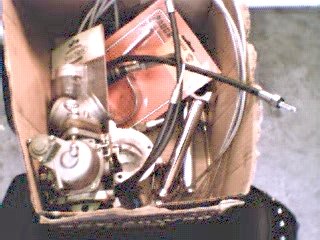
This here cardboard box full of odds and ends was where it allbegan. Or was it just an idea? Or maybe too much Jack Daniels. Ormaybe Bandit was tired of me whining about it. Anyway, like a beggar on the streets ofCalcutta, or Blanche Dubois in “A Street Car Named Desire,” I depend onthe kindness of strangers. And there ain’t none stranger than Bandit’scohorts. Strange but mighty generous, such as Rogue, who cut us adeal on the FXR frame and forks. We’re relying on Joker Machine forall the quality components including the end caps for the swingarmto get this puppy on two wheels.
We couldn’t figure out what this chopper was going to be. Maybe thedefinitive Rat Bike, or a stretched-out steel spider with a hellishV-Twin, or whatever kind of Rube Goldberg, slapped-togethermonstrosity we stumbled upon.
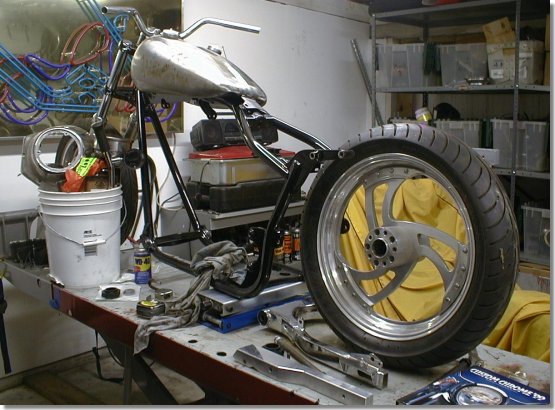
The critical thing is that I’ve got short arms and legs (kind oftroll-like) so whatever we made, it had to have a low center ofgravity. I tried riding Bandit’s Buell, but when I came to a stop, myfeet didn’t touch the ground. So we agreed that the frame had to damn nearscrape gravel. I kind of fancy myself an iconoclast, so I didn’t want tobecome another ad for yuppie motorcycling. Bandit wouldn’t let mepour acid on the thing to give it a lived-in look. If it was going to be a Rat Bike, heproclaimed with bombast, it had to be cool. Well, cool and twobucks might get ya’ a bottle of warm beer. I was determined to make my mark,rat-assed or not.
Bandit suggested that we chop a couple inches out of the frame.
OK, I sez. Bobbed fenders? Bob’s yer uncle, I sez. Narrow the fender railspace? Narrow it is, sez me. Now we’re rockin’. But to tell ya thetruth, it’s still a frame sittin’ in mid-air and a box full of used parts.
But don’t count us out yet. We’ve got a sizzling summer approaching,I’m outta work (I ain’t teachin’ summer school), the Jack Daniels is flowin’,and we’re fillin’ up more cardboard boxes. Bandit’s a tolerant guy, he’s gotthe summer (if he don’t go sailin’ off to the seven seas), and me? I got abrain bubblin’ like a pot o’ hot chili. No tellin’ where thiscrazy-assed bikeis gonna’ take us.
We threw the potentially radical chopper that Bandit and I have banged together up to this point, into the back of my pickup and jammed over to see the Doctor. Dr. John, the frame doctor took one look at the bike in the back of my truck and shook his head. Behind that scraggly beard and those beady blue eyes there is a wealth of experience. He’s seen a lot of biker hopes and dreams, sometimes nightmares, come through his Anaheim Hills shop. He’s managed to salvage most of them. His wry humor snuck through that tangle of beard, “Hmmm, that’s one nice looking Rev-Tech engine.” Bandit ground his jaw, I fidgeted, kicking at the asphalt.
He looked at our hopeful faces and didn’t want to disappoint, “Ok, I’ll take the challenge, but it’s going to take me a couple of days to figure out how the hell I’m going to hammer this thing into shape.” Bandit and I smiled, knowing that the Dr. was going to save our scrap-iron baby.
The whole idea was to shrink the Pro-Street frame around the engine, with just a slight additional rake to the front end. I’m 5’8″ but with short arms and legs, so we wanted the bike frame to be custom fit to my body- frame proportions. We had been looking at some of the bike designs from Japan (where the guys are built more like me) for inspiration.
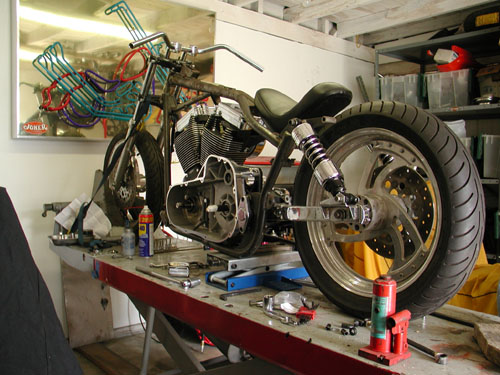
Just with the modifications that Bandit and I have done so far gives some hint as to the unique feel of this design. With the massive Rev-Tech 88-inch engine and 6-speed Revtech transmission squeezed into place, it looks like a Star Wars space sled. I kind of like the rusty, unpainted Pro-Street frame. It gives it an elegant rat-bike look. But then that’s just my twisted sense of humor.
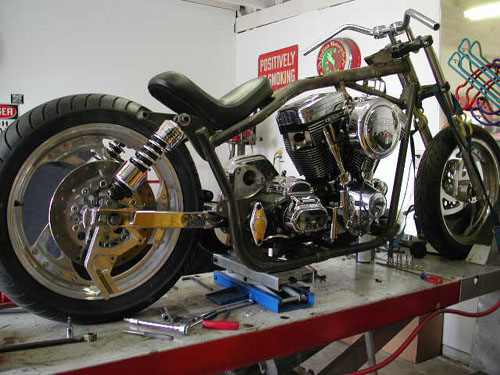
With the rubber-mount engine we have to leave some room for wiggle, so the frame can’t fit like Saran-Wrap. Cutting an inch or so off the swing arm will bring the back tire teasingly close to the inside-front of the swing arm. With a tiny back fender and stretched our front, the ass-end of the bike will look like it’s tucked in below the seat. I said it’s going to look like a running, weird-assed wild hyena. Bandit didn’t care for the comparison and shook his head discustedly.
When we built the Blue Flame, the whole bike was engineered to fit Bandit’s stretched-out body dimensions. Not every bike rider is built like that gangly orangutan, Bandit. So we’ve put a lot of thought into the design of this bike, in terms of scale and proportion. Even the choice and location of foot pegs, shifter, brake pedal, style of handle-bars, and primary shield, will reflect these concerns.
While the doctor is bending and welding the frame into shape, we will be working on paint design, tank and fender design, and ways to clean up some of the wiring, break lines and cables. Or maybe we’ll just fuck off until the doctor calls. Hey, it’s summer and we need to mellow out some.
The day started moderately okay. Bandit and I were going to zoom up toIrwindale to talk to Geoff Arnold at his Joker Machine headquarters to order a raft of parts for the Shrunken FXR, then toAnaheim Hills to meet John the Frame Doctor to check out the progress on myframe, we thought we might also catch lunch with Scooter, our notorious Bikernet criminal attorney, then a leisurelyglide back to San Pedro. No sweat, you say?
The closer we got to the foothills, the morning mist mixed with thecarbon monoxide of a million or so cars careening all over the L. A. basin.Ocean breezes pushed this toxic stew into the eastern edge of the foothills.By the time we got to Irwindale, the Bandit and I were like a couple ofbreakfast eggs sizzling in a skillet.
Bandit called the Doctor to confirm our plan to pop by. No way, no how,says the Doctor. He’s having a PMS kind of day. He hasn’t started on mybike. He’s got a hemorrhoid of a project to hammer out before he can starton mine. Dr. John also repairs sportbike frames and reported that sometimes the frames are so mangled that, well they should be shredded, not repaired. He was up against one of those. So no doctor visit.
A call to Scooter gets about the same results. He’s got to work so nolunch. The day was starting to feel cursed and doomed.
So we knock on the door of Joker Machine. On the other side of the doorwe could hear the banshee howling of an animal possessed. As we walked in,Studley the Joker mascot, attacked with teeth bared, an upper lip curled inschizoid disdain. The rabid Chihuahua snarled, yapped, barked and yelped ina psychotic frenzy. Damn near took Bandit’s arm off when he bent down to patthe little demon on the head.
Geoff grappled with the chain, holding back the crazed critter andwelcomed us with a hearty handshake. Geoff was a gracious host, showing usall the latest Joker products and a few of the Joker toys including their new truck.
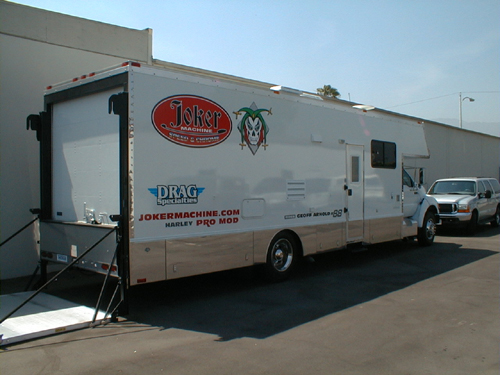
Joker’s new Renegade traveling drag racing garage and party room.
Brian was outside welding together what appeared to be girders for abridge. It turned out to be the sturdy ramp superstructure for the improvedJoker Machine stationary Dyno. Like everything at Joker Machine, expertise andquality construction dominated. That’s one reason we chose to use Joker controls, footpegs and aircleaners and their new rocker covers. The blue flame was domintated with Joker components primarily due to fit and finish. Bandit has never purchased a Joker part and had to modify it to fit.
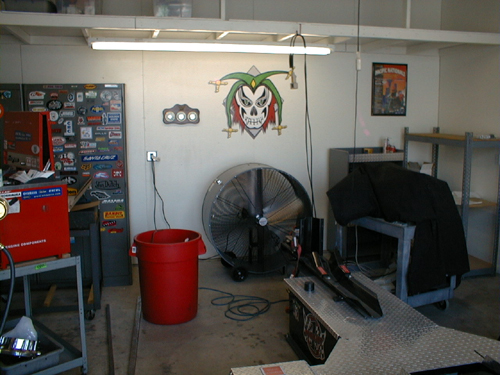
Secret Joker Dyno testing facility. What will they think of next?
Joker is in the process of developing a testing facility for a new line of products, yet to be released to the public.
Over lunch and beers we discussed our design ideas for the new bikesBandit and I are working on. The crew of Joker Machine looked at each othercautiously as Bandit babbled vague musings about “design integrity” and”hidden exhaust systems” or “creating a dense engine compartment.” I chimedin, gesturing with my hands, waving my arms to demonstrate the contours ofthe frame and tank.
Geoff grinned and said that he thought Joker Machine was up to the task.Bandit laughed and said that we had planned to integrate a number of JokerMachine products into our new bikes. Joker Machine, Bandit said, is the bikeparts distributor of choice. For example, he said, products like theadjustable foot pegs allow for adaptation to the individual rider needs.
In addition to the adjustable foot pegs, we intend to integrate into ourdesign with Joker Machine tear drop vents, hand controls and a Joker air cleaner. Weplan to modify Joker Machine forward foot controls to mid-controls.
The Joker Machine crew grudgingly finished their beers and got up toreturn to work. We all walked out side to a blast of heat that would curlthe devils eyelashes. Brian climbed into the back of a Joker truck housing a new V-Rod for product development. Brian recently graduated from advanced schooling in metal fabrication and the Joker crew is looking to him for inspiration and guidance into new product arenas while their CNC design wizard Richard continues to modify and develop new billet products.
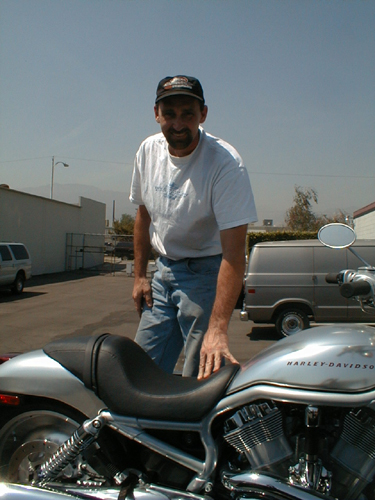
Brian the Joker steel fabricator wizard pondering the V-Rod.
Bandit and I ordered everything from Joker point cover to forward controls that have zero slop, positive lever movement, built in stop light switch and adjustable foot pegs so you don’t vibrate off the pegs. They make all the difference in the world as Bandit attested to on his ride to Sturgis on the Blue Flame. We will doll up the Rev Tech black and chrome 88-inch engine with Joker Rockers that are fully machined from solid billet. The Wedge design enables total serviceability while the motor is in the frame. Bottom section is completely o-ringed. Base is clearanced for larger diameter valve springs and feature a unique modular baffle system for excellent venting characteristics. We’re also using their hand controls because according to Bandit they’re perfect. Our order contained a myriad of the little item also, like small triangular rear turn signals, mirror, gas cap, oil breather, throttle housing, billet clamps and bullet head bolt covers.
Finally we jumped into my truck and headed back tothe ribbon of shimmering hot asphalt of the 210 Freeway. By the time we gotto the 605 Freeway, it was 5:00PM and the Freeways were all at a turgidstandstill, constipated with lumbering gas guzzling, smog spewing cars andtrucks. It was one of those many moments when we wished we had those tight FXRs splitting lanes toward the cool salt air of the coast.
Doctor John promises to have the frame finished for pick-up next week. We’ll report from his Anahiem, Ca location.
If you’re in the Southern California neighborhood, Joker Machine is sponsoring a show at the Grand Opening of the Route 66 Roadhouse and Tavern, June 22 at 1846 E. Huntington Drive, Duarte, California. Call (626) 357-4210 for more information on the shows and Pig Roast.
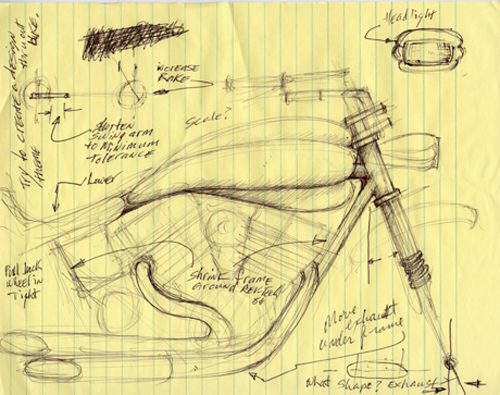
My first concept drawing which Bandit puked on and shit-canned.
Here’s the first of one of my bumbling concept sketches. We will be working with a racing Porsche sheetmetal fabricator on fenders, tanks and exhaust configurations. Wait until you see what Bandit and I come up with next.
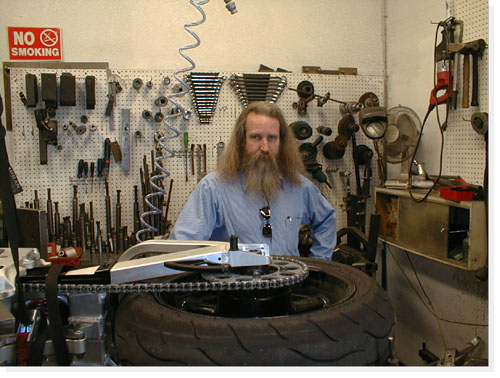
Like the enigmatic fortunes you find inside thosefolded Chinese cookies, our visit with Dr. John–the”frame doctor,” was a mix of New Age mysticism andpractical guidance. The week before, Bandit and Ibrought the rolling Pro-Street frame to the gooddoctor. We gave the him our best ideas of what wethought the bike should become. Basically, we wantedthe bike to fit my body proportions, to shrink theframe around the engine and to still have elements ofa street chopper.
Bandit and I had been trying to create a bike that hada real “signature” identity, yet we weren’t sure whatthat would mean. We tried to convey our concepts withawkward babbling.
Stroking his long, gray beard with a knowing gravity,the doctor calmly listened to our ravings. Eventuallyhe gave us a broad grin through the tangle of beardand said, “Don’t worry, boys, I understand exactlywhat you need.”
We had left the bike with vague misgivings.”Do you think he really has a clue what we want?” Iasked Bandit.
“I dunno,” Bandit said, staring off into the acrid,smog-laden sky.”The guy’s kind of strange, but everyone I’ve talkedto says the guy’s a wizard,” Bandit musedmysteriously.
When we pulled up to Dr. John’s shop, there was ourcreation leaning up against the wall. Not averse tostreet-corner poetry, I intoned, “What a bitchin’fuckin’-lookin’ bike.”
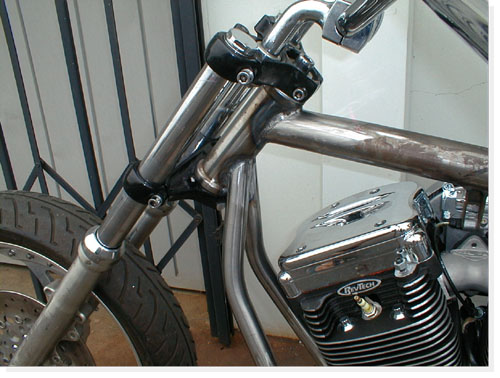
“Man, that bike is really unique,” Bandit exclaimed ina more civilized tone.
As we oohed and ahhed about the bike, Dr. John camearound the corner, grinning. I jumped onto theseat-less bike and grinned. It fit perfectly, betterthan an O.J. leather glove.
“I really think you’ve got something good goingthere,” the doctor spoke with unconcealedappreciation. “I wasn’t sure it was going to workuntil I got into it. The bike began to speak to me. Ithink it’s got the right karma,” the doctor spoke withmysterious gravity.
All this mystery was not without reason. Dr. Johnstarted this trek to ultimate frame adjustment workingat Goodyear Tires. A fortuitous opportunity, sponsoredby Goodyear, for advanced training at L.A. Trade Techgave him the chance to try motorcycle repair.Recognizing that he was more interested in bikes thantires, he began a course in bike repair withinstructor Pat Owens.
Dr. John soon connected up with a bike shop calledMotorcycle Menders. Right away, he could tell that hehad a better-than-average sense of what was needed tofix most frames. Eventually, he opened his first shopin Covina in 1983. In 1990, he moved to his presentlocation in Anaheim.
Dr. John’s expertise is extended to both traditionalstreet choppers and to the more exotic road racebikes, where competitive tolerances and alignmentshave seconds off of lap times. The challenges to hisexpertise in frame adjustment include the extremes ofcreating a bike for a 6’9″ rider and a Harley with a25″ over stock front end. For his own use, he isbuilding a karma-tingling three-wheeler with a VWengine.
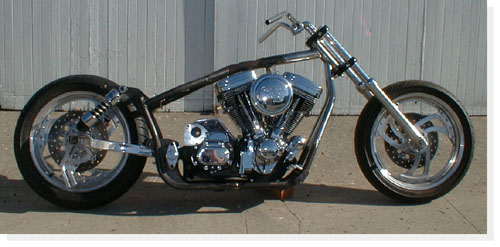
In his shop, amongst a tangle of tweaked Ninjacarcasses, “destruction derby” ATV frames, twistedchopper forks and even a mangled Vespa body, Dr. Johnholds court. Side-tracking his stories about gettinginto the frame adjustment business, he mixes conceptsof metal stresses with ideas of mental stresses,Eastern philosophy, acupuncture points, shakras andauras, martial arts movements, elements of a good dietand muscle alignment of the spine.
The conversation stumbles easily into his personalexperiences. After an injury of his own, he explored avariety of methods of pain control, eventually meetingan American Indian psychic whose exotic beautyhypnotized him as much as her cosmic consciousness.Here, a glint comes to his eyes and a wry smile bringsone corner of his mouth up. “A rare beauty,” hemuses. “An aura just like Cleopatra of ancient Egypt.”
Bandit nodded in agreement repeatedly, like thoseDodger dolls that bobble in the back windows of cars,to the good doctor’s banter. Bandit slurped his greentea while listening to enchanting tales spun by theDoctor. While I shoveled in heaps of steaming andspicy-hot Kung Pao chicken, my eyes teared up and mynose started running.
“The magnetic flow is a flux of energy in the bodyof…” The steaming pots of green tea and plates ofexotic Chinese food sent wisps and tendrils dancing inthe air above our table like a chorus of swaying,sensual nymphets.
“The assorted colors of shakra balance…” Thisadventure had the aura of Zeke the Splooty about it.We were on a cosmic motorcycle Magical Mystery tour.
An hour or so later, Bandit and I were back on the 91Freeway with the bike strapped to the bed of hispickup, staring ahead kind of dumbly. “What a trip,Dr. John is,” I said.
“Yeah, but I think he did a great job on the frame,”Bandit said.
“Yeah, cosmic man,” my head was stuck in the ’60s.”What do we do now?” I asked.
“Let’s check out some trippy paint for the bike,”Bandit smiled. “Let’s drive down to Stanton and see ifWes at Venom can come up with something exotic enoughfor this mystery machine.”
“Go for it,” I laughed.
It’s days like these that make bike building seem likethe right thing to do. Bandit slapped in a tape of’60s funk and we were sailing down the road like acouple of latter-day Kerouac and Keseys.
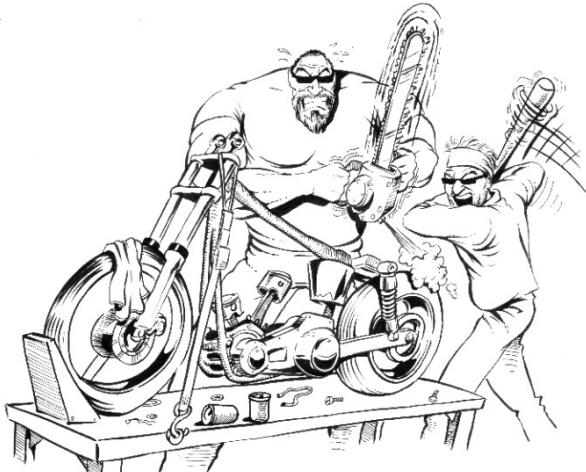

“Hand me a bigger hammer, goddamn it,” Bandit hollered across the garage. We were slamming together as much steel as we could to get this Frankenstein of a bike together in time to show it to the crowds at the Queen Mary Motorcycle Show this weekend.So far this week we’ve managed to cut 1.5 inches off the swing arm. This brings the wheel into the back end of the bike at the point of the pivot. We are designing the bike with brevity in mind. We are hoping that the finished impression will be a bike shrunken around the RevTech 88-inch motor and Rev Tech 6-speed. Oh, we’ll have devilish accents here and there, but the overall concept is lean and mean.
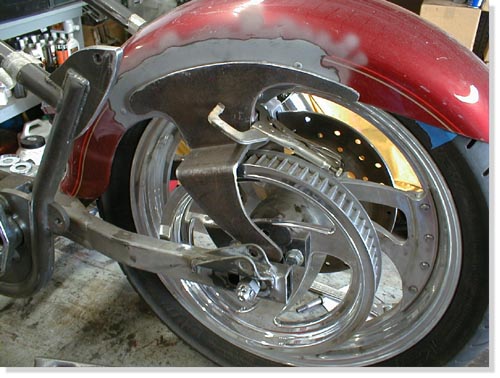
To that end, we are cutting off any unnecessary tabs and struts. Of course, everything changes as soon as a UPS box arrives. Joker Machine parts arrive every couple of days. The foot controls arrived. The new front Avon tire should be here Monday or Tuesday. It arrived, we had it mounted pronto and the fender was looking good. I hauled it to Urs who is a master body man and he widened it to fit perfectly. Having the right tools makes a big damn difference.
A new front tire was called for because the sexy front fender from Cyril Huze was too narrow, since he builds bikes for 19 and 21-inch from wheels and we’re running an 18 (our fault).
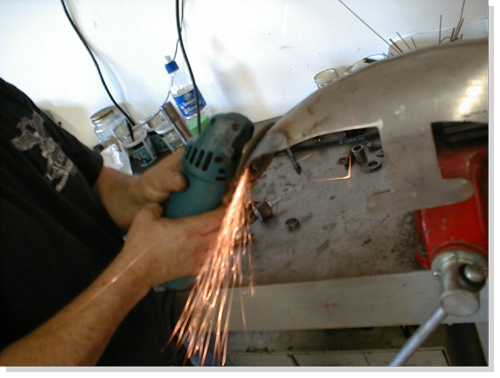
After banging the hell out of the fender to try to squeeze out a fraction of an inch clearance, we decided on a smaller sized tire. We ordered an 18/ 100-90. We hope this will allow us at least 3/8-inch all around.
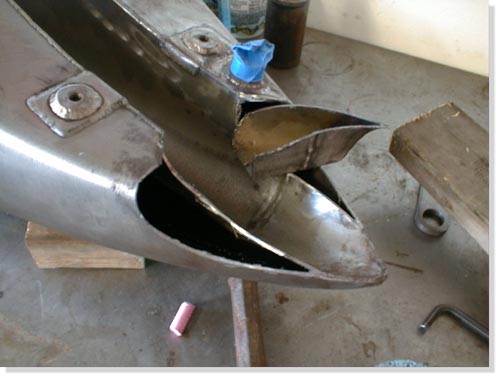
The new Cyril designed stretched tank arrived with the fenders. We cut out part of the bottom of the tank at the back where the front of the seat is, since every goddamn thing we do is backwards. Every builder in the country stretches bikes, we shrink ’em, so the tank won’t fit without mods. This move helped bring the tank down closer to the engine and since the FXR is short, well you get the picture. The tank tabs are in place and welded.
We decided to use an old rear fender off one of Bandit’s past bikes–a Fatboy. We turned it around backwards, the front end will be bolted to the center of the swing arm. Our next problem was how we were going to hold up the stern. After a lot of head scratching, cussing and phone calls we met with master fabricator James Famighetti who suggested that we create our own struts that will be bolted on the inside of the lower rear shock absorber bolt, then welded to the outside of the fender in such a way as to add to the over all look and strength of the fender and conceal the stock aspects. Mounting fenders to swingarms is treacherous. It will vibrate like a dog attacked by killer bees, so it better be strong and still able to remove for touchup.
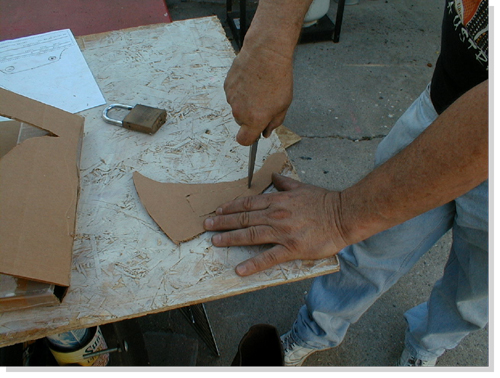
No problem, you say? Ah, ha, not so easy kimosabe! We are pretty sure the strut will have enough clearance for the Rev-Tech brakes on the right side of the rear tire. When you come around to the left side, you’ve got the pully to contend with. So on this strut we added a 2″ dog leg to clear the pulley. I made up the patterns on cardboard and the Fam-Art brothers cut and bent the pieces. Then it was time to fit. We’re getting there.

The BDL pulley from CCI is smaller than the one we used for the mock up. So with our fingers crossed, when all these parts come together this week it will be amazing if they all fit. They did, well, perhaps not perfectly, but we’re getting close.They did, well, perhaps not perfectly, but we’re getting close. If not, “Bandit, get me a bigger hammer, goddamn it!”
Here’s the score. The fender needs tabs and it’s ready. The rear fender needs rivet removal and the massive tabs tack welded. The shock tabs have been cut since the Progressive Suspension shocks from Custom Chrome need to be set wider away from the fender tabs. Let’s see if we can make it to the show. We’re still waiting on Huze oil tank mounting tabs.

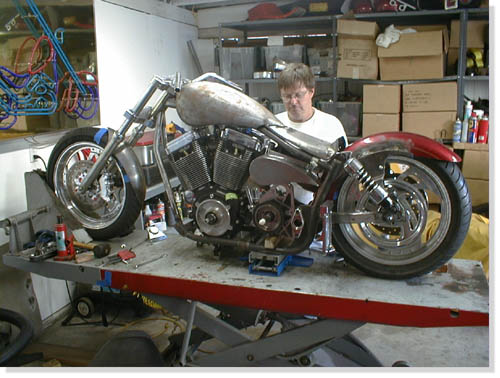
The saga of the Amazing Shrunken FXR continues. This project is notonethat is merely slapping together after-market products to build a facsimileof a customized Harley-Davidson.From the start, Bandit and I sought to create a unique ‘signature’ bike.Even though we have used a lot of after-market products, most have beenmodified to fit our design plan. The products we use, from the FXRPro-Street frame to the Rev-Tech engine to the Joker Machine qualitycomponents, to Cyril Huze, Avon and BDLare some of the finest products available.

Because some of the fundamental elements of design were modified, we havebeen constantly fabricating new brackets, tabs, mounts, and studs. Eachmodification created new issues relating to the fit and function of thedrivetrain. It seems as if we’ve bolted and unbolted the elements of this bike ahundred times.For example, the frame was modified by Dr. John to fit the Rev-Tech engineinto our overall design concept. The top motor mount was bent to fit thenewspacing. We used this motor mount point to position the Cyril Huze teardropgas tank. When we positioned the tank we related it to the handle barclearance at maximum turn position. Rubber mount brackets were welded inplace. The tank was cut at the underside back end to fit low on the frame.It looked hot. Next I cut the La Pere seat pan to hug the pointed rear ofthe gas tank and strengthened the seat back. There is a continuousdouble-‘swoop’from the handle bars to the back of the rear fender. The seat pan lookedhot.
Then we tried to put the engine in. It didn’t look fit. The engine wasmere fractions of an inch from fitting. Even if we could have hammered itinplace the subsequent tight tolerances would surely create problems as thebike rattled and roared down the road.
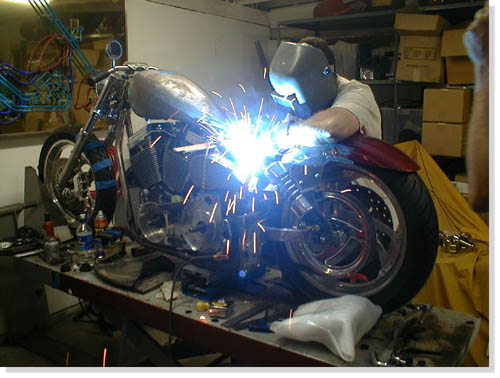
At this point, we cut the original tank brackets and repositioned themodified tank a little higher on the top frame tubing. The tank looked hot,the engine fit, but now the handle bar swing is a fraction of an inch tooclose to the tank. This means we will probably have to have custom handlebars.
It still looks good and we’re still optimistic. Even as wedroppedthe tank down on the new rubber mount brackets and began putting in the5/16″bolts, we found that the right rear bolt was too long to fit. So we got abolt with a thinner head and with my small fingers, I got the bolt in andstarted. We were still looking hot.
We decided to see if the belt fit since Bandit had cut andrewelded the swingarm 1.5 inches shorter for that Amazing Shrunkenlook. Bandit said no, the belt wouldn’t fit. It wasn’t suppose to. Isaid it looked close. As welooked at the bike we realized we’d had to remove the engine, drop thetransmission, which meant we’d have to support the swing arm. It alwaysseems harder than hell to make something easy. So with a couple of scissorsjacks, hunks of wood, and a crow bar, we were able to loosen the rubbermounton the left side of the pivot point of the swing arm. Then we gingerlyslipped the belt in, put the rubber mount back and bolted everything backtogether. Damn! It fit perfect and we were looking hot.
Wait a minute. The right side of the belt was almost touching the edgeofthe back fender. Quick surgery with a saws-all cut a chunk out of thefender. Fender fits, belt don’t rub, bike still looks hot.
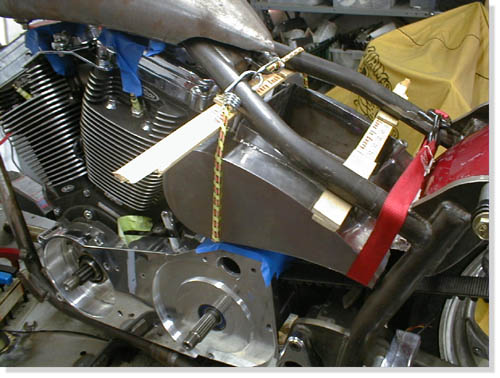
As we cram more operational parts together, the room to move gets lessandless. Next we positioned the oil bag, which also brought up the issue ofthebattery accessibility. With bungee cords, a busted yard stick and some woodshims, we finally got the bag in what seemed a reasonable position. Fourrubber mounted brackets were fabricated then welded into place. It lookedHot. Everything was bolted in place. And everything looked Hot.
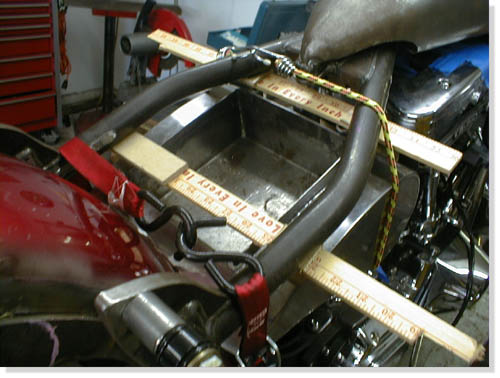
Ah, but not so fast kimosabe. We shaved the fins off the back ofthe oil bag for more clearance. With the two rubbermounts in place atthe rear of the oil bag under the seat pan we had enough clearancefor the battery, in the front for the engine and exhaust, under itfor the starter motor, but no clearance for the ever moving rearfender. It needed at least 1.5 inches of shock play since it’sattached to the swingarm. We had to peel the bag out of the frame andtake it to the Famighetti’s metal fab shop, Fam-Art, for theirexpertise. They came up with a plan to scoop out the back of the bagto the battery box without shortening the overall look of the bag.Then the fender will have the clearance to move with the swingarm andstill look hot.
Next, we neet to investigate whether the Joker controls canbe mounted mid frame. At the same time we will begin fabrication ofthe Amazing exhaust system. It’s gotta be lookin’ hot one way oranother.

Bandit and I were checking out the Amazing Shrunken FXR. “Thedamned thing,” referring to the shrunken FXR project we had beenhammering at, off and on, for almost two years, “has attitude,” hegrowled, “a bad-assed attitude.”
“Yeah, but will it have sound attitude?” I mused. “I want it toget attention. I want it to be felt in their chests before they seeit. I want them to hide their children from the evil they fear.”
The Amazing Shrunken FXR has developed into a mythic ethos. Froma cardboard box full of rejected, beat-up, and cast off parts, thebike has become a sculptured icon, a physical dream, and perhaps awrong turn down a bad dirt road, three miles back.The project began back in the spring of 2001. After a lot of fitsand starts, the Buell Project, the Sturgis Run, the Deer Gut stewadventure, Bandit’s painful recovery, the Red Ball prep, variousevents including a trip around the world and soiree’s, we slappedparts on, hammered steel into shape, welded this and that, cussed andfarted and got to where we are with the help of a RevTech driveline,Custom Chrome, BDL belt, Joker controls, Cyril Huze sheet metal andCompu-Fire electrics. The bike is raw boned, trimmed down, and meanlooking. That’s where it stands, inert and waiting for inspiration,up on the rack at the Bikernet garage.

Bandit regarded the raw metal frame with squinty-eyed intensity.”What you thinkin’,” I asked, keeping my own gaze focused on thepotential of the bike. At my question he stretched out his gangly,egret-like frame to its full 6’5″. “It’ll be a loud mother fuckereither way you play it,” he intoned in his gravitas basso-profundodeep voice. “We’ve shortened the frame and rear wheel base so muchthat it’s barely a cunt-hair from the exhaust port to the rear wheel.”

We cut a piece of an Samson Evolution system with a Mikita touse the exhaust port, then started welding other pieces in place. Wecut it back to make a tight turn and create space away from the oiltank.
“Fuck it,” I responded in my best Pancho Sanchezimprovisation, “let’s just start from the port and see what happens.”
We rummaged through a pile of Samson scrap exhaust pipes that wehad scavenged from a dumpster behind the Sampson factory. Flingingout fish tail tips, shot gun systems and swoopy cruiser exhausts,most of them dented and damaged so they couldn’t be re-used. Mr.Samson gave us only the best to modify. We eventually came up withenough pieces to fabricate a Frankenstein exhaust system.
As I grabbed for a section 1 3/4-inch chrome pipe, Imistakenly grabbed a goodly chunk of fur. Bandit’s midget, crazeddemon of a feral cat yeowled in protest and sank his needle-liketeeth into the back of my hand.
“God damn that crazy bastard,” I screamed, “he’s as crazyas a peach orchard boar.” I’m sure Bandit has a mescaline salt-lickfor that freaked out feline.After I extricated my hand from the jaws of Bandit’s feline Cujo, Ireturned to the exhaust system at hand.
Our intent was to minimize the exhaust system as much as possible.We ran the pipe straight down from the front exhaust port, thenturned it to hug the bottom of the engine case. We had originallyhoped to put a flattened pipe under the frame, but reasonable roadclearance dictated a different path. So we tucked it in and aroundthe engine case, then inside the frame, coming out just at the edgeof the back wheel.
“Our first mistake,” Bandit spouted, “we needed a smallerdiameter chunk of exhaust to form guides when welding chunks ofexhaust together. If we had slipped it in one piece even a quarter ofan inch. it would have held each chunk in alignment. That’s onetheory to building pipes. The key to fabing your own pipes is havingenough scrap to slice and dice, then cutting and working each pieceuntil it’s as close to a perfect fit as possible. Finally the tackingprocess is critical. That’s were the guides didn’t come in. If we hadguides we wouldn’t have offset pipes tacked into place. That problememerged severely a week later during the grinding process.”
“It took two days of playing, cutting, fitting and welding toform a completely custom exhaust system in place,” Bandit added.”Make sure you wet towels and form a fire barrior around your tackingarea to protect the rest of the bike. I used a small 0-sized torchtip and common hanger to tack the segments of pipes together. I’m notconfident enough with our new MIG welder with thin sheet metal, so Istuck with the torch.”

” It wasn’t perfect, but it was ours,” Bandit added, “acompletely unique system that would be tucked under the transmissionand attached to the driveline solidly under the tranny backing place.Then we faced the muffler aspect. The pipes were too short to be openor we would have been arrested within a block of the headquarters.”
Needing some kind of ‘standardized’ muffler elements, we went toour local San Pedro Kragen Auto Parts store. With the clamp-on piecein hand, we found parts and pieces enough to create a 7″ mufflercase. “Most of the elements were too heavy and glass packed,” Banditspouted, “We couldn’t weld on a glass pack.”
Back at the garage, with torch in hand, Bandit cut out a sectionof baffles from some scrap Sampson muffler. Spot welding the bafflesinto our jury-rigged muffler, we produced something that may, likeJapanese Fart Wax, diminish the painful ‘Brap-rap-rap’ flutter ofunrestrained exhaust back pressure. A right-angle turn-out willdirect the dragon’s breath exhaust from the screaming 88cc Rev Tech,high-performance engine to an unsuspecting public standingslack-jawed and terrified at the curbed edge of civilization, theirhair-dos blasted straight by the sizzling after-burner of the AmazingShrunken FXR.
“He gets sorta twisted,” Bandit muttered shaking his head.”Actually with the baffle in hand we went to San Pedro Muffler Shopand looked at the myriad of tips and tubing alterations we couldmake. We found a tip and had a chunk of 1 7/8 tubing spread to matchthe tip. That formed the other end of the muffler. We just had toweld the three elements together.”

I welded the baffle in place, positioned as it was in theSamson System. I discovered that the two elements didn’t want to weldtogether. I have a feeling the tip was made of an inferior metal.

With the die grinder we cut notches for the muffler clamp.


“After welding and fitting I stood back and was proud of ouruniquely tight system that would allow Giggie, from Compu-Fire, tomachine mid-controls for a final touch,” Bandit interupted. Theexhaust played perfectly into the Shrunken aspects of the project. Iremoved the tacked system and began hours of gas welding to make itwhole. That’s when all hell broke loose. While working on anotheraspect of the bike with my back turned to my partner, he began togrind the welds. The college art history professor sought perfectionwith each weld and ground right through the thin walls of the18-guage exhaust pipes. It was amazing. I was sure the system wasruined.”


This shows the amount of area ground down so far we were forcedto fill it or destroy the system and start over.

“Some builders tack systems together then take them tomuffler shops for professional construction. I thought that was mynext move. Unfortunately a regular muffler shop doesn’t have themandrels to make the tight bends we had proposed. I was devastated,but the man told me that he could fill the welds with his MIG welder.


More welds to fill the mad grinder’s cutting work.
“Unfortunately each weld was now a 1/2 inch tall and wide zit atalmost each junction of the pipe. Nuttboy began the grinding processagain. More holes were found and I filled them with gas welding usinghanger rods. I joke now that if the bike runs like shit we blame iton the exhaust system. If it runs well, it’s the same roll of thedice. We’ll see.”
“Making your own exhaust system can be a blast, just don’tget heavey handed with the grinders. Pipe is thin and a little weldthat shows won’t matter much since we didn’t plan on chrome, butblack Jet Hot coating. I’ve sworn off chrome exhaust systems on mybikes for the future.”

That big bastard just won’t shut up. The next episode in thismechanical adventure will feature Giggy’s attempt a electrifying thesteel monster. Next weekend, barring any new bike projects, Giggy’sinopportune finger damage at the power tools, splattered deer guts,San Pedro political insurrection, Sin Wu’s beguiling charms, a caseof beer, or any other form of diversion or chaos, we will be closerto cranking this monster over.
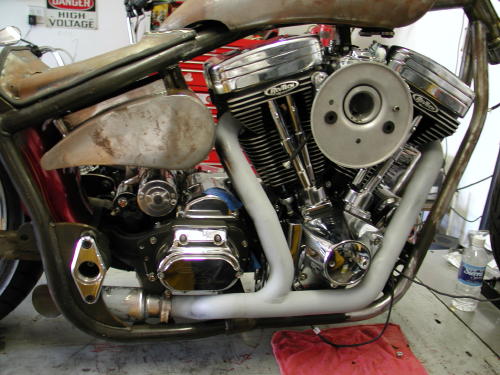
Photos by Bandit and Sin Wu
It’s New Years Eve 2002 and catch up time on the ShrunkenFXR, as if I’ll melt if I don’t cross the line by midnight. And I’mgoing to lower the boom on you. It wasn’t intentional that Giggie,from Compu-Fire, came to the Bikernet Headquarters to help install aCompu-Fire charging, starter and ignition system. He added showing usthe benefits of installing S&S solids in the 88-inch Rev Tech engine.That would seemingly be enough, but since the starter involved theBDL inner primary, Giggie was snagged into helping with the beltdrive installation. That’s not all. As you will see in some of theshots we have Joker Machine forward controls installed, but we’vealways considered mid-controls. Unfortunately for the mastermachinist, we asked for Giggie’s impression and knowledgeablenotions. He dove right in and you’ll see the outcome here. There’seven more, but let’s get started.
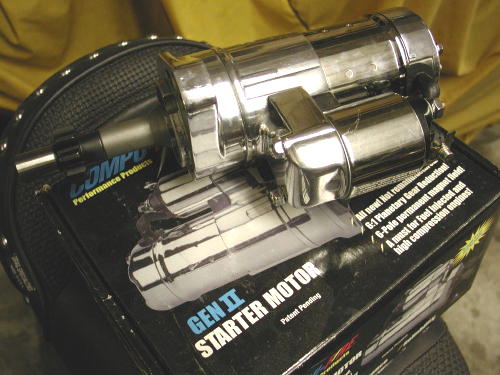
I’ve been running Compu-Fire Electronics for several yearsand will continue to do so. The systems are flawless and a breeze toinstall. I’ve learned to trust their components and enjoy asingle-fire ignition. My discussions with Giggie ran into startingproblems I had encountered before. He pointed out to me that newhydralic systems bleed down as engines cool which closes valves whenyou want that puppy to fire to life once more. That’s where the S&Sportion of this tech began.
Here’s the deal. If the valves are closed while the starter motoris desperately trying to turn over the engine, especially aperformance unit, it’s a bitch. The compression is over the top, andthe electric motor is fighting an up-hill battle. The battery isbeing stressed. This situation is caused when the bike sits and thehydraulic lifters bleed down. Once it fires to life that situation isrelieved.
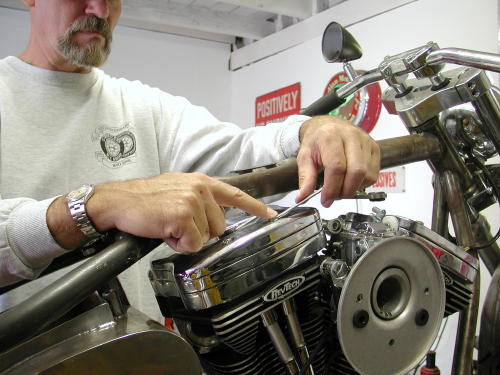
Giggie has been testing and improving starter systems for thelast three years with Compu-Fire. They are developing the mostelectrically efficient systems on the market, but discovered thishitch in the driveline system with the jammed valve train which putsundo pressure on an otherwise fine starter motor and battery. We madea date to install the new Compu-Fire Starter, but in addition, fourlittle rings from S&S would slip into the Rev Tech hydraulics. Sincethis Custom Chrome engine had non-adjustable pushrods we had to ordera set of Rev Tech aluminum adjustable pushrods. We removed the rockercover and arm assemblies to free the pushrods.
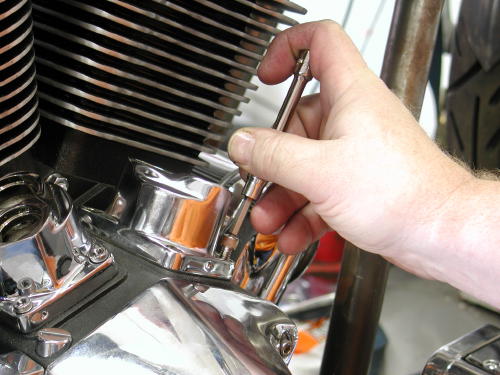
The lifter blocks had to be removed to retrieve the hydraulicslifters.
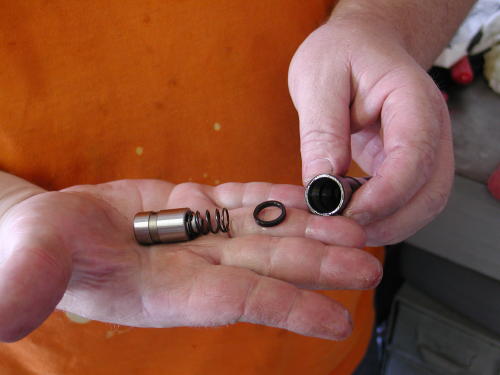
The following shots show the S&S solid ring installationprocess, I hope.
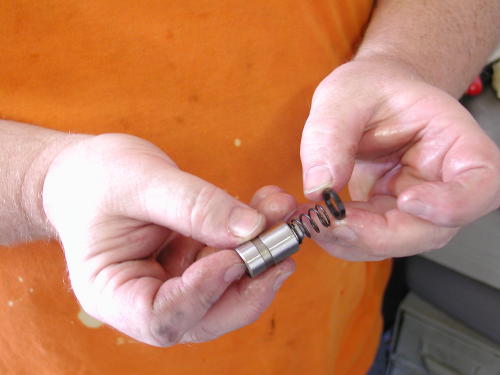
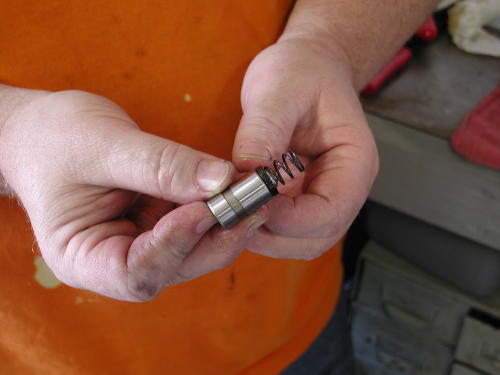
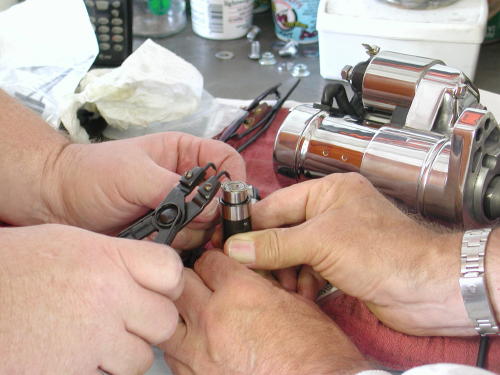
Giggie used snap ring pliers to remove and install the snapring to free the hydraulic piston.
With the lifter blocks removed, the lifter slipped outeasily, and with a snap ring plier tool Giggie removed the ring andthe spring and the piston came free. The S&S ring was slipped overthe hydraulic plunger spring and the rest is history. With the clipring back in place the hydraulics were ready to rock with the new RevTech Pushrods.
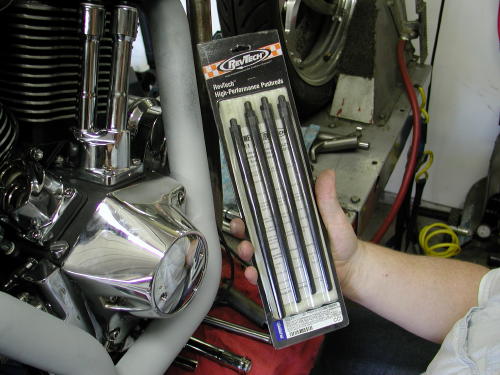
Giggie demonstrated how he adjusts pushrods by finding the intaketop dead center, TDC, position for the front cylinder first. When theintake valve is closing or the pushrod heading down, stick a straw orpencil in the spark plug hole and watch it travel north until it’s atthe top, TDC. check the timing hole for confirmation. Sure enough averticle slot showed up in the hole confirming our position. The camwas also in the perfect position to adjust both the intake andexhaust pushrods for the front cylinder, since both valves are closedfor compression. There is also an exhaust TDC.
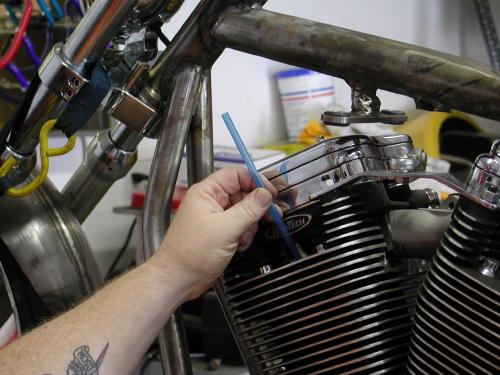
The pushrods are adjusted just like old school, solids untilthere’s no up and down slack. You’ll notice that the rings don’t makethe hydralics completely solid but give them .020 slack. Once youhave each pushrod adjusted back off one complete turn. That will giveyou .020 cushion and once the bike runs for the first time you won’thave any tapping like the old scoots had. That’s an easy fix for amajor performance issue. I hate wasting starters or batteries.
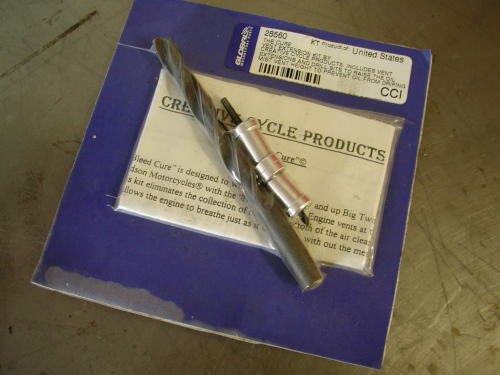
Since we didn’t have the adjustable pushrods on hand we tookthe rocker boxes apart and Giggie pointed out another big inch motorfix. Performance engines that are pushed to redline can build upexcessive oil in the rocker box breathers. That oil will end up inthe air cleaner if it doesn’t have time to filter back through theheads into the oil return line. Creative Cycle Products, distributedby Custom Chrome, designed a fix for this problem. They call this theNose Bleed Cure which was designed to work on all late 1993 and upEvolutions with Nose Breather (engine vents in the heads) system.Installed, the kit eliminates the collection of oil at the bottom ofthe air cleaner assembly. It allows the engine to breath naturallywithout the mess in the air cleaner. The vent extensions, installedin the rocker boxes, allow more time for the oil to filter throughthe head.
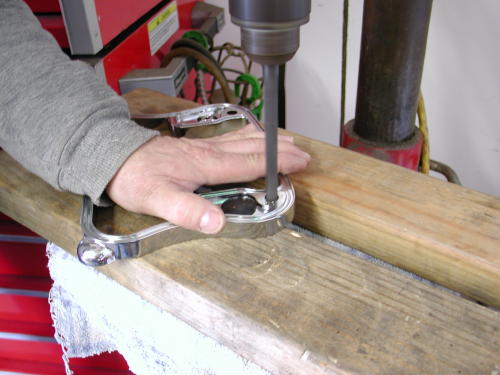
The vent extension is a breeze to install, especially if therocker boxes are removed. The center rocker arm spacer has two areasin the corners for breathers. The inside cavity has a rubbermushroom, Umbrella Valve, poised to limit some air and oil into thearea. That’s the corner we’re concerned with. The extensions wereeasy to install in some respects in the Rev Tech Rocker Boxes andcreated another challenge in other respects. Let’s follow CreativeCycle’s instructions: If we had a battery we would have disconnectedit, first. Since our tank was easy to remove we 86’d it to make roomfor the operation. You could get away with just jacking up the tank.
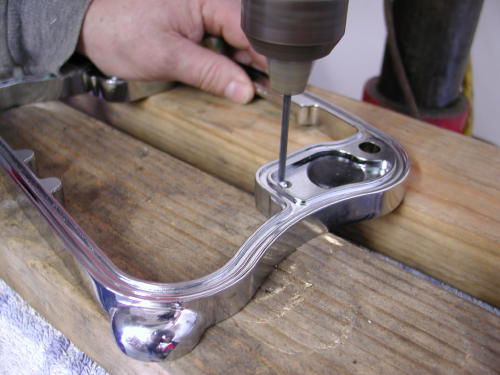
Remove the front rocker box top plate following the servicemanual. Unbolt the sucker. Then remove the center spacer. Remove thegasket. If the engine is new you don’t need to replace it. Theinstructions also call for replacing the Umbrella valve, but youdon’t need to do that unless it is old and worn or you bury it inaluminum shavings. Umbrella valves generally last a long time, butheat sometimes damages them and they crack. If you are going toinstall the cure in a worn performance engine, replace the UmbrellaValves.
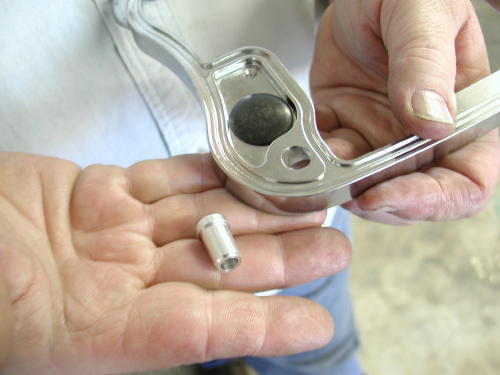
Drill the small drain hole with the supplied 1/8 bit. Using the13/32 drill, bore out the large drain hole. The Rev Tech rocker boxspacer already had a sizeable hole and didn’t need drilling. The ventextension slipped right in. On the opposite side of the spacer thehole was broad and open which didn’t secure the new vent extension atall, which is generally a mild press fit. We cleaned the spacerthoroughly and cemented the extension in place with sillicon on theunderside and let it set up before we re-installed the rocker with afresh gasket (generally the use of silicon on the inside of anyengine is forbidden. But since it’s Nuttboy’s bike, who cares). Makesure the ring is completely clean of any debri or burrs. In mostcases, according to the instructions, the vent extention is a pressfit into the new hole. Tape it gently into place, clean the rockerring thoroughly and re-install that bastard.
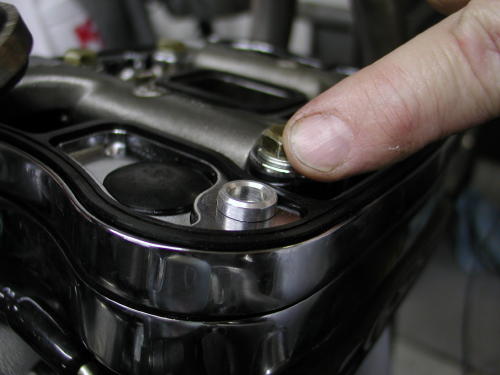
Now perform the same function with the rear head. Accordingto the diagram with the kit, the two breather sections you’re lookingfor are the inboard units closest to the carb. Makes sense. Theoutboard breather cavities are not used. If you are running a monsterengine and want to extend the extension, there are small ringsincluded in the kit to enhance the existing extension although youmay need to clearance the top rocker box cover.
One more time I’ll mention silicone. It’s not to be used in anengine since one little piece could severely block an oil passage anddestroy the engine. The other reason I mentioned it again was broughtto bear by Frank Kaisler and a neatly placed .38 against my righttemple. He whispered angrily in my ear that silicon will not cementitself to chrome. He suggested JB Weld after the chrome was groundaway for a clean sticky porous surface.
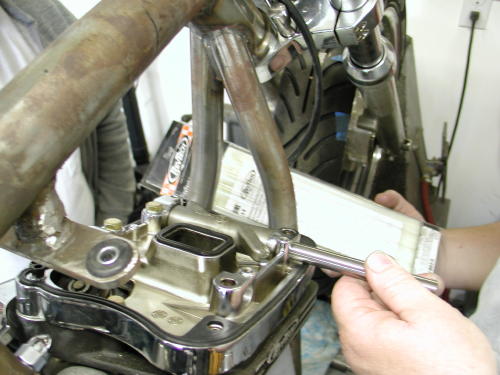
That’s two out of say five techs we need to cover. How thehell are we doing? If you have any questions about this modification,here’s the number for Creative (800) 368- 6217.
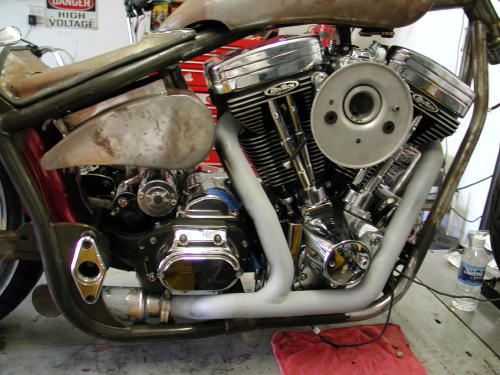
This entire tech process was handled in two differentsessions. During the first we discussed the mid controls notion withGiggie and he altered our course. We were headed in the direction ofstock FXR mid control mounts, that bolt or are welded to the frame.That notion would force us to created large sweeping mounts to clearthe BDL belt drive. Giggie had another notion. Run a shaft throughbushings built into the belt drive inner and outter covers, tolinkage much like stock through primaries, except we would mount thefoot peg on the end of the shaft for the cleanest possible approach.
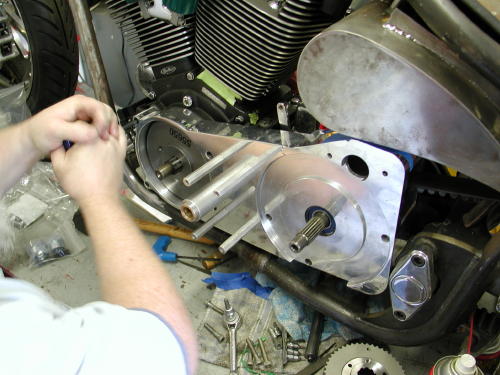
On the right side of the bike we had to make a plate that wrappedaround the tranny cover that would carry a similar shaft that wouldact as the axle for the brake lever. He suggested that we hide themaster cylinder under the tranny close to the rear wheel for a tighthose run to the rear brake caliper. The pipes will wrap around theshaft for the right peg and brake lever. Seemed like a good idea,except for one thought. This is a rubber mount motorcycle and boltingthe pegs to the driveline was asking for foot vibration. We discussedthe concept with several riders and the reactions were varied from”we’re nuts”, to “What the hell”, to the notion that we could run oneset of billet pegs for around town and a vibro-padded set for theroad. We decided to run with Giggie’s concept and try the simplesuckers out.

When we met with Giggie again he demonstrated the outcome.He machined the shaft for the BDL unit and an aluminum guide tubewith brass bushings pressed into the covers. The support unit wasstrong enough to stand on. Next, we needed linkage and a shifter peg,then foot pegs. In this case the foot peg will rotate with theshifter, another odd approach.
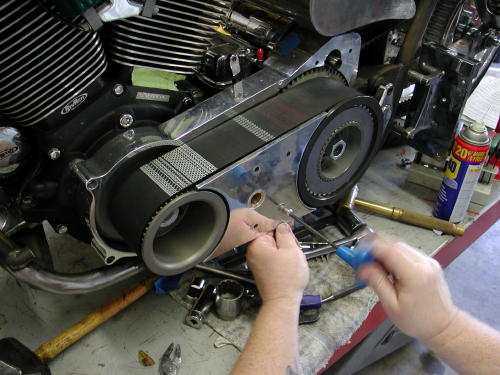
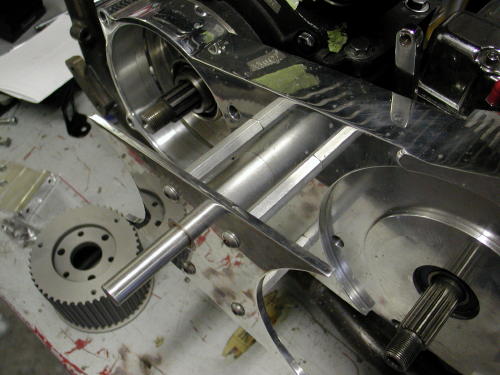
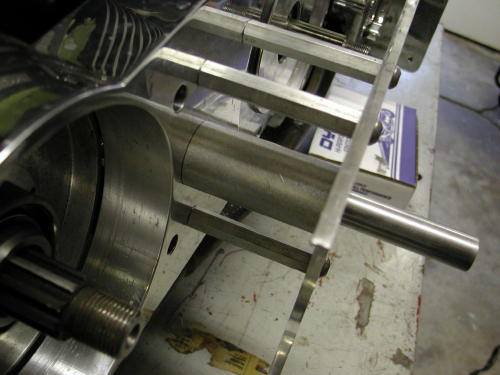
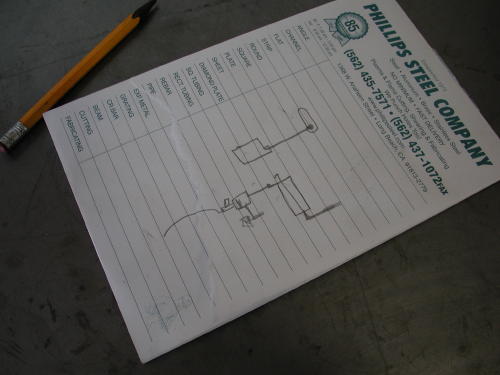
Note the high-dollar precision sketch of right rear brakelinkage mechanism. I don’t get it, do you?
Moving right along we installed the Compu-Fire chargingsystem. This is a breeze, but first you must hit the Harley Shop oryour Custom Chrome Catalog for a set of Stator Torx screws. If you’renot sure which charging system you have here’s a clue: The 32-ampalternator kit is identified by the stator plug protuding from theleft crank case outer surface. The 22-amp stator plug is recessedinto the crank case surface. This particular system is designed tofit all Big Twin models 1981 and later. The rotor may be used withstators rated at 22 amp and 32 amps.
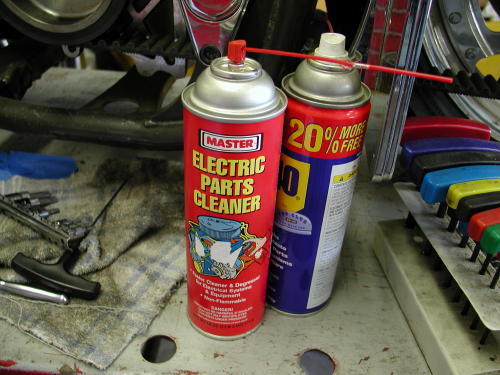
We used the contact cleaner for clearing the stator area ofgrease or debris. The WD-40 was used to let the plug slip into placegently.
We cleaned the area in the left side of the Rev Tech casesthoroughly with contact cleaner. Then we slipped the stator over themain shaft, but not into position. Giggie sprayed the alternator plugwith WD-40 and began to wedge it into the inner slot in the case.First you need to back out the Allen set screw in the case to allowthe plug to slide through. Once the plug is in position (protruding1/4 inch), tighten the Allen set screw with Permatex blue Loctite. Becareful not to over-tighten the screw which could short out thealternator and ruin your day. With the plug in place make sure thewires are safely routed then install and tighten down the stator withthe self Loctite’d Torx screws. Done deal.
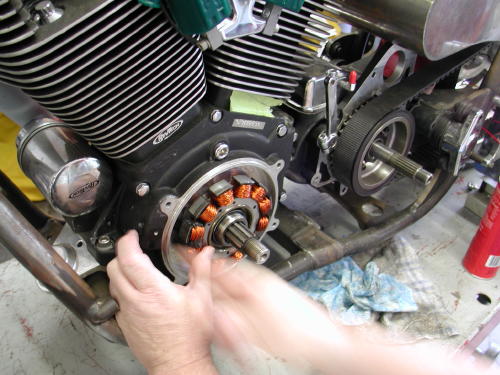
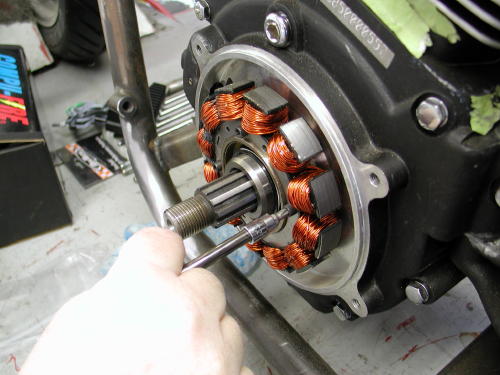
Then Giggie slipped the smaller of the two massive washersover the shaft (except when 32 amp Harley-Davidson alternator kit isalready installed). If the Compu-Fire rotor is being installed on a1981-1988 model with the Harley-Davidson 32-amp alternator kitalready installed, the spacers and shim washers should already beproperly positioned on the sprocket shaft. Discard the washerssupplied in the kit and reuse the washers and shims in the samelocation from where they were removed. Compu-Fire charging systemsare perfect replacements for toasted charging systems.
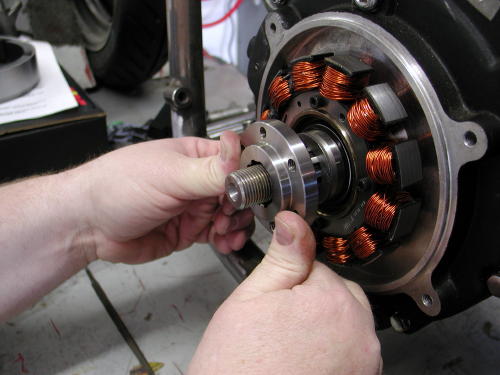
Then he took the BDL engine shaft insert and slipped it onto thesplined sprocket shaft to check the fit. Some sprocket shafts fromJIMS and S&S were slightly different sizes. The splines were machinedto be .001-inch larger across the face. Since the BDL insert fitsnugly, but fit he attempted the same manuever with the Compu-Firerotor. When we installed a rotor on the Redball chopper, we had tofile each tooth to make it fit. That wasn’t the case this time aroundsince Giggie ordered the Compu-Fire rotor with the larger slots orsplines. Note the number on the rotor. The 650 unit is alreadyprepared for the larger shaft, whereas the 600 unit was built forearlier alternator motors. If you need to remove an old rotor you mayneed a JIMS machine tool or a Harley-Davidson puller part no.95960-52B. Be careful that the magnets in the rotor do not pick upsmall metal parts or hardware from the work area before you installit.
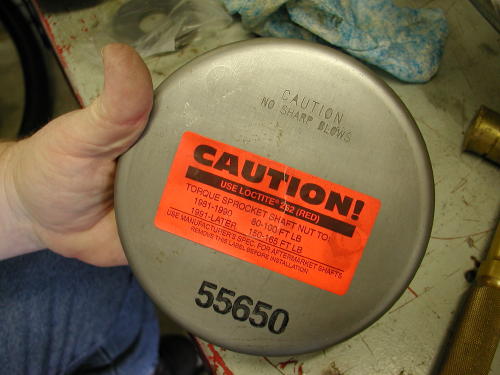
Also note the warning label on the rotor. It says not tosmack the rotor with anything. If you do so severely you could knocka magnet loose, or you could change the polarities on the magnets.Don’t hit it with anything harder that the palms of your hand. Thisone was snug, but slid right into place. Now comes the large flatwasher. This puppy is there for strength. With everyday use the faceof the rotor will flex and can crack. This washer adds strength tothe face and prevents cracking. Don’t forget it.
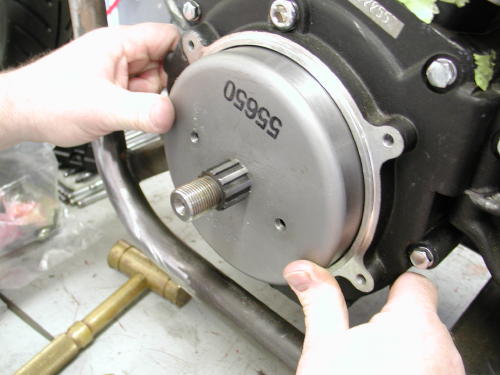
Here’s some notes regarding different models. Thisinformation is supplied with all Compu-Fire charging systems:
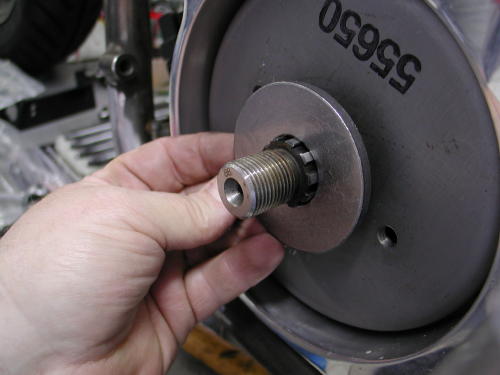
To install rotor on 1981 to 1990 Big Twin) except those witha 32 Amp alternator kit installed) place the large washer suppliedand original shim washers over the sprocket shaft (in that order).See figure 1.
To install rotor on 1991 and later FLT/FXR models, discardthe large washer supplied in the kit. Place the original washer andshims over the sprocket shaft (in that order). See figure 2.
To install rotor on 1991 and later Softail and Dyna Glidemodels, discard the large washer supplied in the kit. Place theoriginal shim washer over the sprocket shaft. The original thickspacer washer will be used under the compensating sprocket nut onfinal assembly. See figure 3.
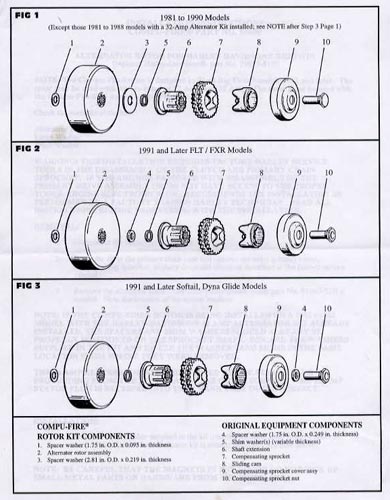
If your are installing this Compu-Fire kit on a stock bike,next you would re-install the primary drive assembly per factoryservice manual and use loctite (red) on the threads of compensatingsprocket nut. The compensating nut must be torqued to the correctspecifications:
1981-1990 models 80-100 foot pounds
1991-Later models 150-165- foot pounds
(for aftermarket shafts use manufacturers specifications.)
Don’t forget to put oil back in the primary.
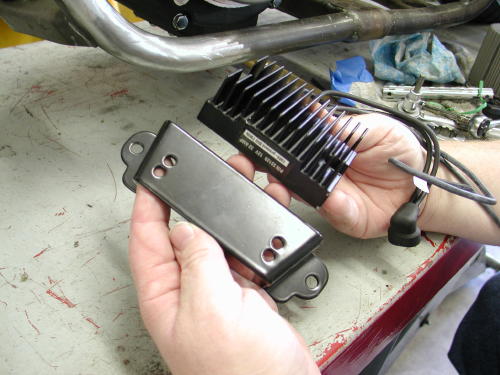
That left the regulator. In the past you would be forced toinsure a proper ground by cleaning some of the regulator case surfaceof paint, the bracket surface and paint off the frame. That’s nolonger the needed. These regulators come with a separate groundstrap, which Giggie recommends that you attach to the engine case onthe right side under the cam cover to hide it. “Make sure the wire iscrimped to a lug, not soldered,” Giggie pointed out, “and that thecase is clean of wrinkle paint before it’s bolted in place.”
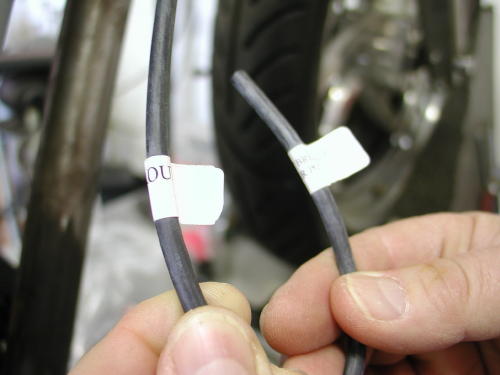
One other wire is afforded with the regulator, the hot wire,which generally runs to a circuit breaker, the battery hot terminalor the ignition switch hot side. There’s a specific reason for notsoldering lugs or connectors, but crimping them. According to Giggiesoldering induces heat to the wires and a completely solid lead bondthat creeps under the wire insulation. The combination creates abrittle point in the wires that can deteriorate and crack withvibration. Wire connectors do not come with the regulator kit. Youneed to find the appropriate size for your application.
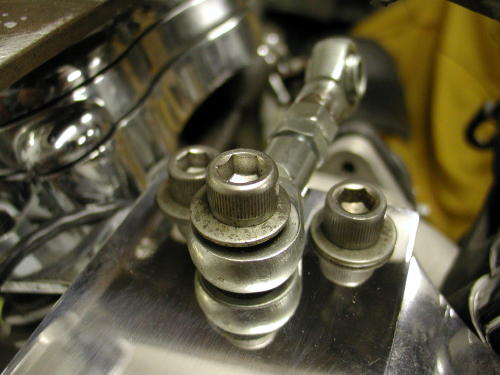
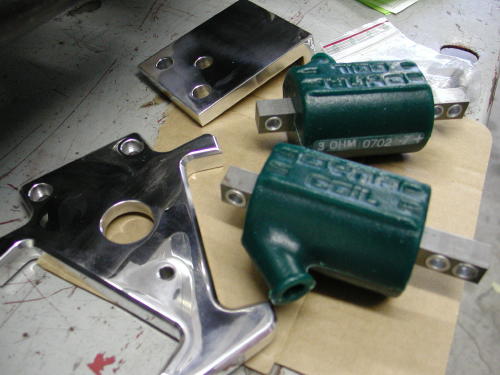
While Giggie was tinkering in the Compu-Fire machine shop,building prototype components for their line of products and slippingin a Shrunken FXR parts, in his free time, we installed 3 ohm Dynacoils required for the single-fire Compu-Fire ignition system. Theyare available from Custom Chrome in 6 and 12-volt models, with singleor dual towers and in 1.5, 3.0 and 5.0 ohm configurations. We chose astrong billet German made bracket, from Custom Chrome, to hold thecoils between the heads. This is one of the cleanest ways to run theelectrics with all the elements close together. The coil bracket fromCustom Chrome was also capable of holding the ignition switch and ahorn button or toggle high/low beam switch. That would be the extentof the wiring for this bike and it would all be tucked under the gastank and between the heads cleanly.
We have also ordered a CCI ignition switch discovered from thewater-craft industry by Bob McKay. It works like automotive ignitionswitch with a key and acts as the starter button eliminating the needfor a starter relay.
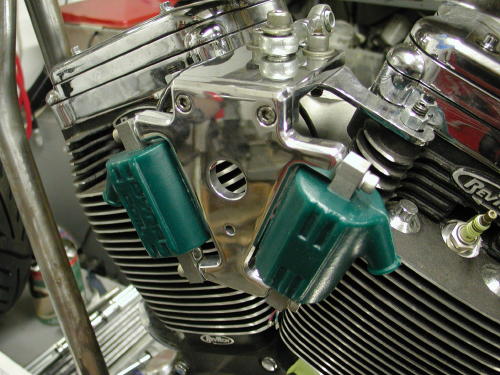
What should we handle next, the ignition system or the BDLBelt Drive? Your call? The BDL Belt, okay, here goes. Actually theseunits are increasingly easy to install. Late model bikes with rubbermounted drive lines are in solid alignment which makes these unitslip right into place. Just in case you are working with a pre-unitmodel I will list some alignment recommendations from Frank Kaisler.
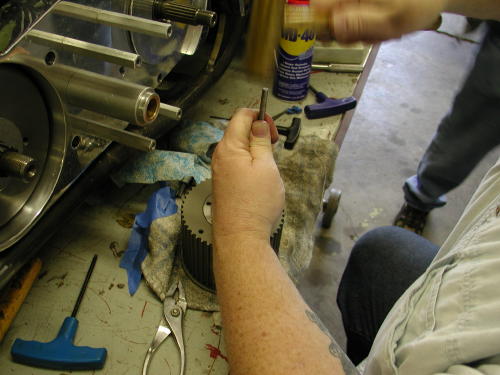
This particular BDL installation came with their brand new SuperStreet Clutch which consists of nine fibers and 11 steels. Installtwo steels first then alternate fiber and steel ending with a steelbehind the pressure plate. Install anywhere from four to nine springsand bolts depending on how much spring pressure is needed for yourapplication.
“With this much clutch surface, not much spring pressure will beneeded for proper engagement,” Said Bob from BDL. For additionalspring pressure for monster engine and abusive clutch throwers theyincluded washers to enhance the clutch pressure.
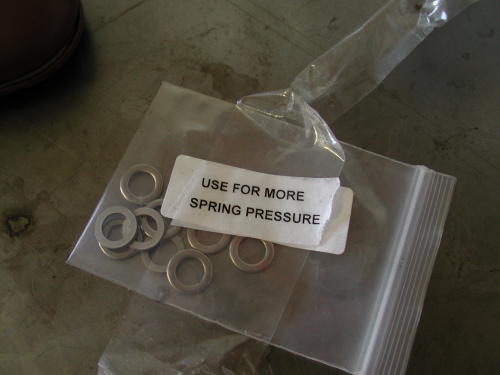
Basically Giggie installed the backing plate first using thefasteners supplied by BDL. Installation on 1986-89 models require theuse of a 1990-up starter and modification to the starter mountinghole on transmission will be necessary. You must open the mountinghole to 2-1/8 inches.
Remove the stock starter pinion gear and complete starter gearassembly from starter. Bolt starter into back side of motor plate.
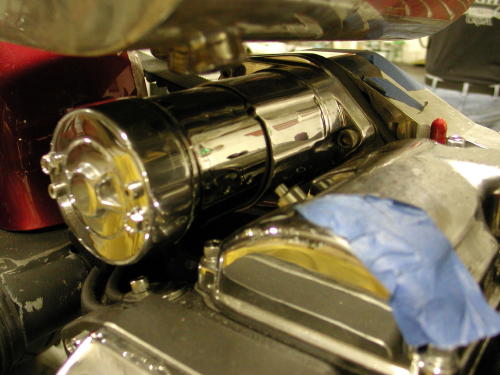
Install the front and rear pulleys and check for proper fit. Atthis time you should determine if the front pulley will need shimmingor not depending on how the pulleys align with each other. Removepulleys and add shims if necessary.
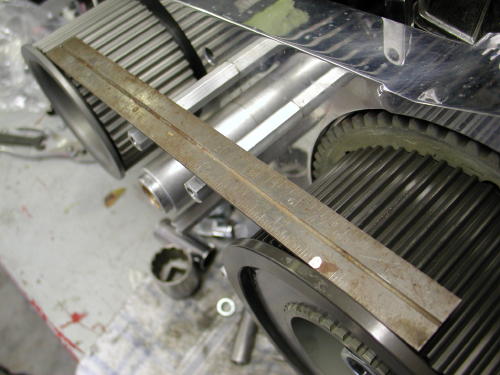
Re-install belt drive placing front pulley, rear pulley and belton at the same time or you’ll discover it’s tough going. Install andtighten to H-D specifications, mainshaft hub nut. BDL supplied aspecial hub nut with seal for all spline shaft models 1990 and later.Engine shaft splines should not protrude from the pulley. Be sure tored Permatex Loctite front engine nut and torque to H-Dspecifications (an electric impact driver is used but notrecommended). JIMS and CCI carry a tool that will lock the pulleys soyou can use a torque wrench. For 1986-89 taper shaft models you mustuse the stock hub nut and seal kit (included).
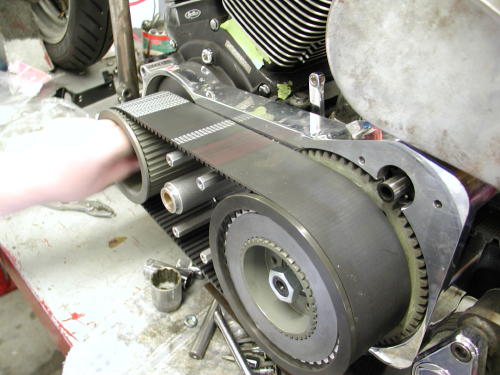
For spline mainshaft models, 1990-up, apply red Permatex Loctiteonto the back of the BDL hub 1/4-inch inside of the spline and letthe Loctite flow onto the mainshaft when sliding the rear basketassembly on. This procedure is necessary so that the hub andmainshaft will fit together properly and will not let the mainshaftspin inside of the BDL hub. This procedure is not necessary on tapershaft models 1986-89.
(The belt drive was designed with the use of stock H-D frames.The shaft to shaft dimensions on a stock Softail are 12.825 and on anFXR is is 11.325. The number of teeth on the pulleys and the numberof teeth on the belt were engineered to exact fit using the abovedimensions. If aftermarket frames, engines or transmissions are usedthen these dimensions may very slightly. You may need to address thisproblem so that the kit will fit properly. We will not be able tohelp you with this problem, this is an issue to be addressed by themanufacturer of the aftermarket parts that you may be using.)
Rotate the motor (take the plugs out) using a socket wrench, thebelt should track straight and away from the motor plate, but not sothat it may come in contact with the outside pulley flanges. Be surethat the belt drive is not making contact with the motor plate.
Grease the starter shaft and install the BDL starter pinion gearonto the starter shaft, apply red Permatex Loctite to the starterbolt and tighten to H-D specifications (they supply two starter boltswith the kit, one is a 1/4-20 by 2.5 inches for 1990-93 starters, theother is a 10-32 by 2.5 inch for 1994 and up starters. Be sure not totighten starter bolts too tight as this may interfere with properengagement to the clutch ring gear.)
Install the clutch pack, refer to schematic spline steel first,1/2 sided friction plate with fiber facing out, then alternate steeland two sided fiber plates ending with the other 1/2 sided frictionplate with the fiber facing in. This is for the regular clutch andnot the Super Street Clutch which was covered above. Install pressureplate, springs and shoulder blots.To install shoulder bolts apply redPermatex Loctite to a bolt and run in one turn, go onto the next boltuntil all the bolts are in place, then tighten them all the way downuntil they bottom out. There is no adjustment to the spring pressure,this is all pre-determined with the length of the shoulder bolt andexact dimensions of our pressure plate.
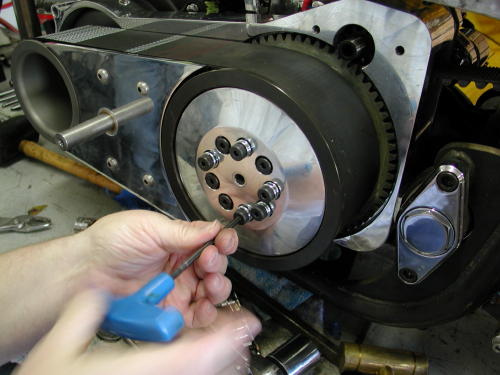
Install the four hexagon cover plate extensions into motor plateand mount side guard with the four button head allen blots.

Clutch screw adjustment should be 3/4 to 1 turn loose from lightlyseated. Note: When the clutch is hot the adjustment screw should notbe seated. Tighten rod nut when adjustment is complete. BDL suppliesa clutch adjusting rod and nut for all models 1990 and up, only.

If your bike is perfectly level, if you put a level on thisruler, it should be level.
SIDEBAR; ALIGNMENT CHECKS FOR RIGID MOUNT DRIVE LINESWith the engine in place and all the lower engine mounting boltsinstalled but loose, take a straight edge and place it on the innerprimary mounting surface of the engine. Look at the straight edge toinsure that the sprocket is parallel to the straight edge, if not trymoving the engine around until the straight edge and sprocket areparallel.
Once this is done snug the rear engine mounting bolts. Now checkthe engines front mounts to the frame with a feeler gauge, if thereis a gap between the engine and frame make some shims to fill thegap. The shims should be a plug fit. A plug fit is the same as a slipfit, the exact shim height to fill the space between engine and frame.
Position the transmission on the trans plate and install in theframe. Place all plate mounting hardware in their respective holes,but leave them loose.
Place the BDL engine plate on the engine and the transmission andinstall all of the mounting hardware. Tighten the plate to enginemounting bolts first, then the plate to transmission bolts. Usingyour hand turn the mainshaft of the transmission to feel forresistance, this is how you will check your work.
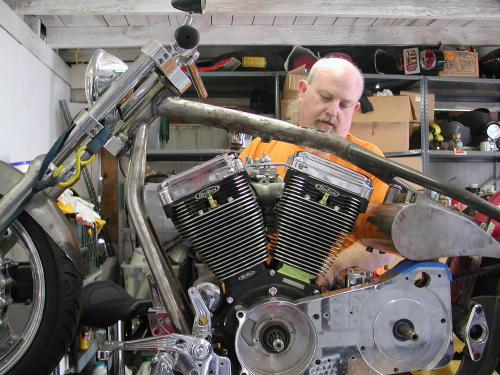
This shows the primary before installing the pulley and the masterCompu-Fire designer/machinist Giggie.
As of right now, you have assured the engine’s sprocket shaft andthe transmission main shaft are parallel to each other. Now tightenthe transmission mounting plate to the bottom of the transmissioncase. Check that all of the trans plate mounting bolts still movefreely up and down, if they or only one of them don’t move freelyfind out why and fix before moving on. Sometimes this occurs due tomanufacturing tolerances. Sometimes just running a 3/8-inch drill bitthrough the frame and mounting plate will fix small misalignments.
Here is where the difference is made. It is a lot easier to shimthe transmission mounting plate to the frame mounts than thetransmission to the mounting plate. To do this take a set of feelergauges and measure the gap at each trans plate mounting bolt, thenmake-up a shim to “plug-fit” the distance. With all four corners ofthe trans plate done check the “fifth” trans mount and shim as needed.
The moment of truth. Start tightening the transmission mountingplate bolts one at a time. Check the transmission main shaft byturning it in your hand before and after tightening each bolt. If youfeel increased resistance after a bolt is tightened then you willneed to go back and check that you got the correct shim thickness forthat one mounting bolt. Keep checking the mainshaft and proceed tothe rest of the mounting bolts. After all the mounting bolts aretight and the mainshaft spins as it should, you’re done.
A good way to double check your work is once everything is tight,remove the engine plate. The engine plate should not pop or springwhen the mounting bolts are removed, and likewise the plate should goright back on and seat against the engine and trans with no effort.
Ok, where to get shim stock. There are a number of machine toolcatalogs that sell a selection of shim stock for about $20-$30. Theseselections come with different thickness sheets of stock that you cutto whatever shape you need. Another source of shims is PerformanceMachine and Custom Chrome. Both companies sell brake calipers thatsometimes need to be shimmed to their mounts to center the caliperover the disc rotor. The mounting bolts for these calipers are3/8-inch diameter, the same size as your transmission mounting platehardware, I have bought a couple packs of these shims to use. If Iremember right they were only a few bucks per pack. If for somereason you have a big gap between the plate and frame you may be ableto use a 3/8-inch flat washer. Most flat washers these days measureout between .060-.068-inch in thickness, you may still have to addanother shim to achieve the plug fit you are looking for. Anothersource of shim stock is beer or coke cans, if I remember correctlythese cans measure out at around .014-inch, but it has been a longtime since I measured one.

The main thing to remember, is that the mainshaft must always turn free,maintaining its parallel course with the engines sprocket shaft.
When speaking of parallel shafts, that’s plural parallels.Both planes, vertical and horizontal. Believe it or not, careful set-up ofthe belt drive, or chain drive frees-up hidden horsepower.
When both shafts turn parallel, true parallel, requires the least amount ofpower to turn. Freeing that extra few ponies to do your bidding, not tomention better fuel mileage.
–Frank Kaisler
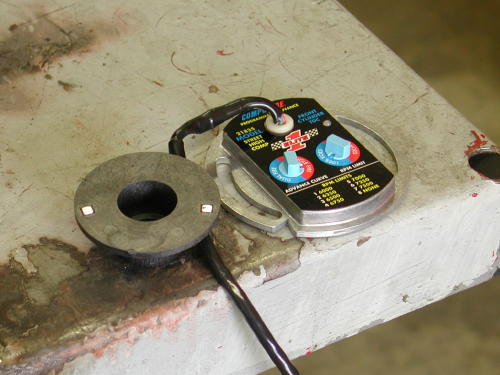
Compu-Fire Ignition model 21835 installation–the last hurtle.For kickstart you need the 21835KS. The electric-start unit delaysspark for two revolution to allow the starter to get rolling.
We are finally to the bottom line, the last straw, the final beerin the six-pack. We face only the simple, yet precise Compu-Fireignition system. I’ll try to make it quick.

First find front cylinder top dead center TDC as we describedbefore with the straw (won’t hurt anything) in the sparkplug hole,after the intake valve begins to close. The notch on the cam shaftwill be at 7:00 at TDC and you know that you’re cool. There shouldalso be a straight verticle line in the timing hole, anotherconfirmation.
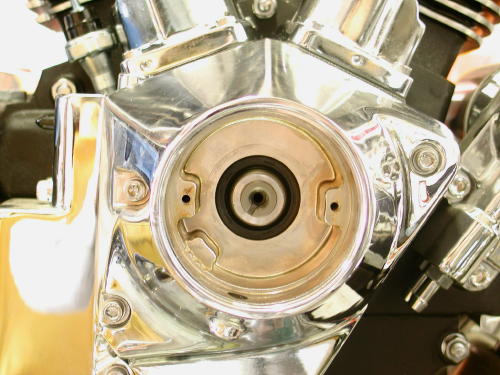
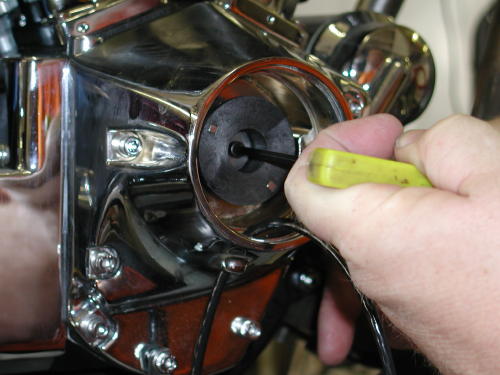
First you need to remove any previous ignition systemright down to the cam shaft. Now bolt in the Compu-Fire ignitionrotor or trigger wheel with some blue Loctite. Giggie then bolted inthe Compu-Fire ignition plate and turned in counter clockwise. Afteryou run the wire loom out the bottom of the Rev Tech cone. Dig out a12-volt battery and hook the red wire to the positive terminal.
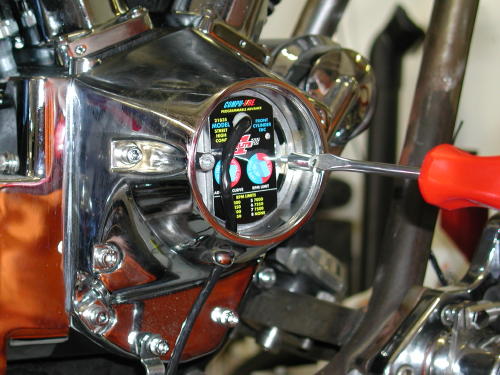
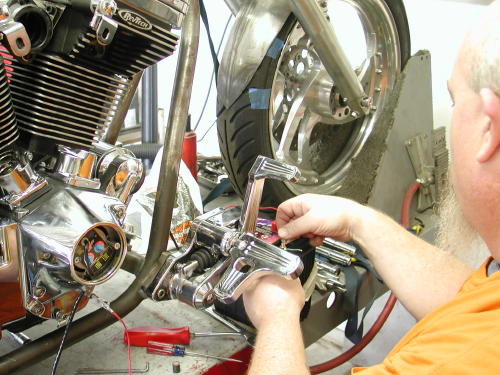
Tape off the black, white and green wires so they don’t ground orshort to the battery. Power the red wire up with a ground link to thebike. The LED light on the Compu-Fire plate will alight.
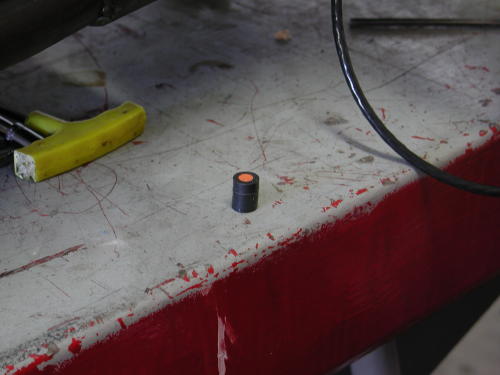
Grab the magnet that comes with the kit and hold it with theHarley orange dot away from the plate and swipe the magnet left toright along the bottom of the plate. The light should go out, if not,turn the magnet over and try again. Slowly turn the plate clockwiseuntil the exact moment the light goes on again. You’re timed, donedeal, simple. You’ve static timed the bike in its advanced position.Lock the plate down and disconnect the battery.
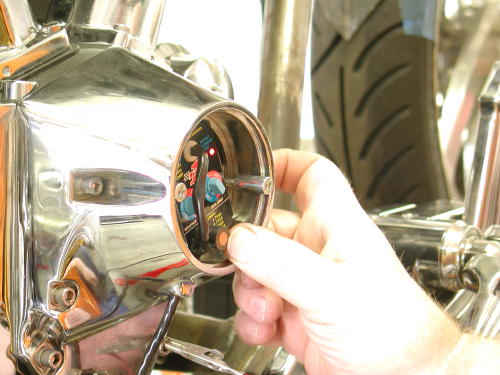
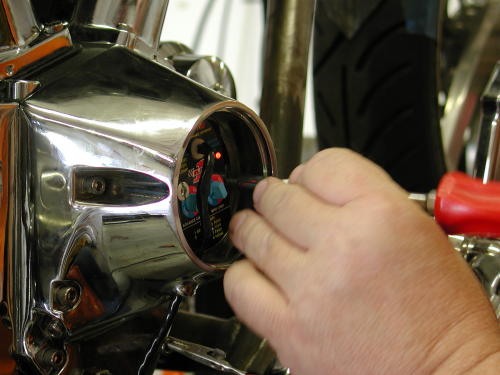
You wire this with with the red wire heading to heignition switch. It’s the hot wire. The Black wired hauls ass to thefront coil, the white wire to the rear coil and the green to the VOESswitch. That’s the single-fire set up. For Dual fire aim the blackwire to the coil and tape off the white wire. The green is guided tothe VOES advance switch once more. Giggie likes the VOES switch andI’ll try to explain why. I would prefer to throw it in the trash, butnooo. We will install the VOES switch in the wiring tech, later.
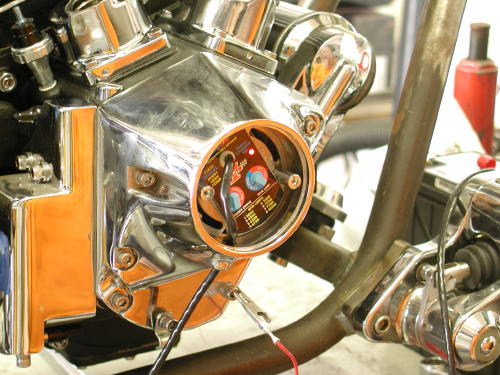
I like the concept of single fire for a smoother running engineand separate coils for each cylinder for a stronger spark. Some maysay, “Bullshit.” But that’s my notion of single-fire ignitions. Thisunit has two switches, let’s start with the left. You turn it to dualor single-fire and it has eight advance curves. One to three are setfor 35 degrees BTDC advance. Four to six are 32 degrees of totaltiming, seven is 30 degrees and eight is 28. There are threedifferent curves bringing the engine to total advance at differentRPMs, one is 1,500, 2 at 2,000 and three at 2,500, based on themotor. We set it at six because I’ll be running the VOES.
The right switch controls the VOES. You can have it set at50 percent or 100 percent. Fifty percent is advanced 5 degrees and100 percent, 10 degrees. It adds timing at necessary times but willnever add timing over the advanced maximum. The final setting on theright is the Rev Limiter. The best use of the rev limiter is to setit 500 rpms past peak power. That means some testing is needed to useit effectively. No problem. It’s designed to prevent over revving themotor because of a missed shift. The right hand switch controls theVOES and the rev limiter.That’s it goddamnit. I can’t believe I made it to the end. Wejust hauled the Amazing Shrunken FXR to our master metal fabricator,James Famaghetti for final craftsmanship. We need to install aSportster kickstand kit from Custom Chrome and Giggie’s controls,then it’s the three “P”s, paint, powder and plating and this puppywill rock. Hang on. We’ll be back in a couple of weeks.–Bandit
You’ve been there. You handed the Makita cordless drill toyou’re drunken buddy, and he drilled a hole in your big screentelevision. You tried to wrap the extension cord around his neck andfinish him off. We came close to blows in the garage a couple ofmonths back. I spent days carefully welding chunks of Samson exhaustpipes together to form a one-of-a-kind exhaust system.
All the welds were performed with gas and hanger rod. Thepipes weren’t perfect, but they fit the bill. They were actuallyintended to be prototypes, to be duplicated by a paid professional.After the first pass was completed the pipes fit like a glove,although they were artistically rough around the edges. Nuttboy cameby on his Wednesday afternoon escape, and I handed him a highspeedgrinder and instructed him to round off the welds. I worked onanother project and paid no attention while sparks flew. When he wasfinished he tapped me on the shoulder and said humbly, “Not sure thisis what you had in mind.”
He had ground right through the pipes and left gapingholes alongside most of the welds. In addition, I discovered to myteeth-grinding dismay, that there were still large sections of thepipe ground so thin, that as soon as the torch tip came within 6inches of the surface the pipe melted away. I spent another whole dayfilling the gaps. Who knows what will happen when the struggling bikefires to life. We’ll have the only exhaust system on earth withbaffles throughout.

That’s not all. The grief continued. I hand made a mufflerusing a portion of a Samson baffle. We purchased a chromed, truckfender tip from San Pedro Muffler and went to work, but after hoursof screwing with the shiny metal we almost shitcanned the unit. Thefender tip was made out of a strange metal, almost pot metal, thatdidn’t seem to take to the gas welding and wouldn’t respond tobrazing. For every hole I filled, another crack lurked. I welded,then smoothed on a bench grinder only to find cracks and holes tofill again. The shorty muffler probably weighs 50 pounds due to thevast layers of welding rod. As it stands, this is a pure prototypeexhaust system. We should use it for testing then shitcan the rankpiece of shit and start over.

Click to order Catalog!
Frustrated, but pleased with the overall look we were readyfor final metal work. This bike is being built by inexperiencedhands, not professionals, in our backyard garage. Sure, I’ve builtsome bikes, but I wouldn’t consider myself a metal fabricator. I cameup with the initial design and we roughed out elements, but we neededa master metal worker to finish what we started. There are preciousfew, true metal craftsman, who I know. One is Billy Westbrook,another is Jesse James and recently, in the news, we displayed metalwork by Roger at Goldammer (Goldammer Cycle Works Ltd.,www.goldammercycle.com ,1-250-764-8002). High quality workmanship.
They’re out there but not on every corner. I stumbledonto another super-slag artist under my nose. James and LarryFamighetti are Hamsters and own a corrugated steel metal shop inHarbor City, California, called Fam-Art. You’d be tweaked to rumbledown Narbonne Street and stumble across this rusting corner buildingthat’s got to be the oldest swaying dump on the block. Theyspecialize in structural steel (you could never tell it from theircreaking tin shed) for homes and buildings. Large chunks of steel,massive shredders, presses and welders are scattered around the funkylocation that’s reminiscent of the first shack Harleys were built in.

Nuttboy and I darkened their doors a couple of times toask them to flame-cut a couple of chunks of steel for our fenderbrackets. The more I hung around the more quiet-James began to showme steel components he had fashioned for some of the local riders. Herebuilt and reformed Harley taillights to eliminate all the edges andgrooves, then welded them to fenders so that ultimately there were noseams. The more I gawked at the sculptured parts, that demonstratedhis ability, the more I knew we had discovered a man capable of BillyWestbrook fabrication qualities. We hauled the entire FXR to Jamesthe next week.


James relocated the straps in such a way to narrow the shockplacement keeping that shrunken look in mind.

This is a close-up of the right fender strap. It’s beencorrected, reformed and readied for final welds.


We cut and fitted the tank and made the mounts, butJames filled the underside, rear section for a perfect fit.

We jacked up the front of the tank and mounted it, butJames filled it and formed the front of the tank to match the customridge along the top. He even made paint work suggestions that I foundinteresting. “If you paint a ridge like this with a light color,”James said, “The ridge will disappear.”
We decided to paint the bike a light House of Kolors pearland create a dark teardrop panel on the top of the tank. He alsocreated and welded fork stops to the neck.
As we rolled out of the shop that day James still hadfinal welds to complete. He straightened out our seat pan, but neededto figure out a mounting arrangement. Finally we needed the CyrilHuze front fender brackets checked and welded into place.
We should have the Shrunken FXR back in our clutches inthe next couple of weeks. We need to finish our rear brake andshifting mechanisms with Giggie from Compu-Fire, fire it up for atest ride and tear it down for paint.
Oh, I need to untie Nuttboy. I need that extension cord.

The Shrunken FXR returned recently from Fam Art, in HarborCity, California (310-326-2141). They welded, shaved, mounted theseat, manufactured fork stops and saved our poor- construction asses.James Famighetti mounted our Cyril Huze front fender, welded andformed the tabs and informed us that the Avon Venom was too large forthe narrow glide front end. It was our turn to work on it.


Note that James mounted the seat pan so that the edges wouldnot touch the frame paint in the future.

Like any self-respecting bikers we hate to have a bike, oreven components out of our mistrusting mitts. We had another dilemmathat needed handling. The bike still didn’t have a kick stand, and weused two 2 by 4’s, to hold it upright, when not perched on the lift.There’s a trick to this maneuver. If I backed the Pro Street FXR outof the garage and wasn’t hauling the wood planks, I was screwed. Ifalone, I could stand there for hours waiting for someone to strollpast carrying two 2 by 4s–unlikely. After a couple of unsteadyoccurrences, the bike didn’t move without the wood chips on the seat.You can imaging the major pain in the ass this caused.

We ordered a weld-on, Sportster style, kick stand fromCCI, and it arrived complete, with all chromed hardware and thebracket to be welded on the frame. There was one problem indetermining the position. The front Avon was a 100/100 18-inch, andwe planned to replace it with a 90/90. We needed to have the finishedPerformance Machine wheel in place.

The Avon Road Runner tire arrived, and we had it installed at thelocal Yamaha dealer. James pointed out to us that our front tirespacing wasn’t perfect so I sliced a spacer to give us about a1/4-inch spacer on the right side of the wheel and about a 3/4 inchspacer on the left. The tire, almost centered, now had clearance, andthe wheel floated effortlessly under the modified Cyril Huze frontfender.

Now we were cleared to install the Hot Match weld-on kickstand.This is a tricky assembly process. First, you need to be absolutelysure you don’t plan to change the front wheel, to a 21, or extend thefront forks. If you do, the kickstand will need to be bent ormodified to fit. It’s not the end of the world, but it will destroythe chrome.

The other trick is determining the right position. Here’swhat my feeble brain told me, since the directions with the Hot Matchdidn’t cover positioning, except to recommend that you take yourtime–no shit. First I stood my Road King straight up and lifted theside stand until it was locked in place. Then I measured from thepoint that would touch the pavement to the ground. It varied fromaround 2.5 inches to 3 inches. I noted that the Hot Match lever wasnearly 3 inches shorter from the point of contact to the center ofthe pivot point. I took that into consideration. I also noted that Ihad lowered my King with shorter shocks, then added a larger Avontyre (a 150). Ground clearance was also a consideration.

Then we picked a placement area on the frame. Our designcalled for little or no forward controls. I kept the tab under theBDL belt drive system and hidden as much as possible, without beingso far back as to create a balance problem. If the weight is forwardof the kickstand, sometimes it can topple the bike. One otherconsideration. When the stand pops up you need to be able to reach itwith a toe, and it better not ride on the belt, or you’re toast. Makesure to check all that, before you burn any rod.

I sprayed the frame rail and the components with asilicone splatter preventative. It obstructs slag from sticking tocomponents. It also made the frame a slipper bitch. I tried settingthe stand end on a socket nearly 3 inches off the deck. Then Iconsidered the differing lengths of the stands and shifted to 2.5inches. Sin Wu was called, from the bedroom, to hold the stand firmlyin place. I marked it, with a grease pencil, then ground the edges ofthe bracket to be welded to the frame. Extra grinding took place toform a snug, metal to metal fit. In order to make all this work weneeded to partially assemble the kickstand without the ball andspring.
The easy-to-read directions called for disassembly, but we left ittogether and used it to hold the bracket in place for tacking. Beforetacking I backed the bike out of the clamp, holding it upright,positioned the bracket in the white grease pencil marks and leanedthe bike carefully until the stand rested on the flat surface. Itlooked cool, so we re-clamped the bike securely, held the stand inplace, protected the belt from hot slag and tacked the sucker withour Millermatic welder. Then we took the stand arm off the bracketand welded it some more. That would hold it securely until we torethe bike down for paint.

The Hot Match unit from Custom Chrome is a well madeprecision unit delivered show chromed. The instructions includedrecommendations to apply anti-seize to the spring and ball. Theyendorse using Red Loctite on the pivot pin threads. We didn’t becausethe bike would be torn down for paint in the near future. The armneeds to be placed firmly over the bracket and pushed into placebefore the pin will ease into the hole from the bottom. It doesn’thurt to have a spare set of hands and someone holding the bike.There’s also a pivot pin set screw to prevent losing that preciouspivot pin and kick stand arm, on a desert highway, in the middle ofArizona.

That’s it, except to mention that when we head to thepaint shop, we need to tape off the chrome bracket, so the painterwill paint over the welds but not the chrome tab.
As you can see this bike is damn close to the spray booth.I need to coerce Giggie, from Compu-fire, to ride his FXR out to theBikernet Headquarters with our mid-controls. Once the Joker Machinehandlebar controls are bolted to the modified bars, we’re ready for atrial run, then off to paint. Stay tuned.


–Bandit


























